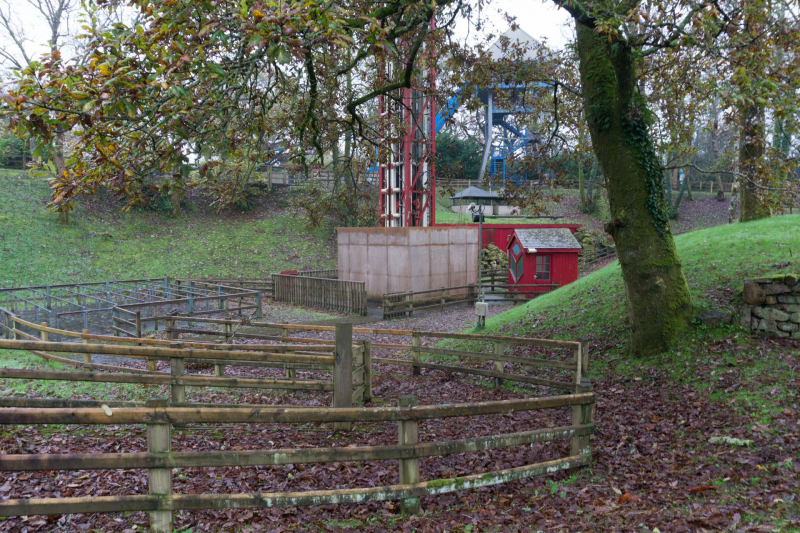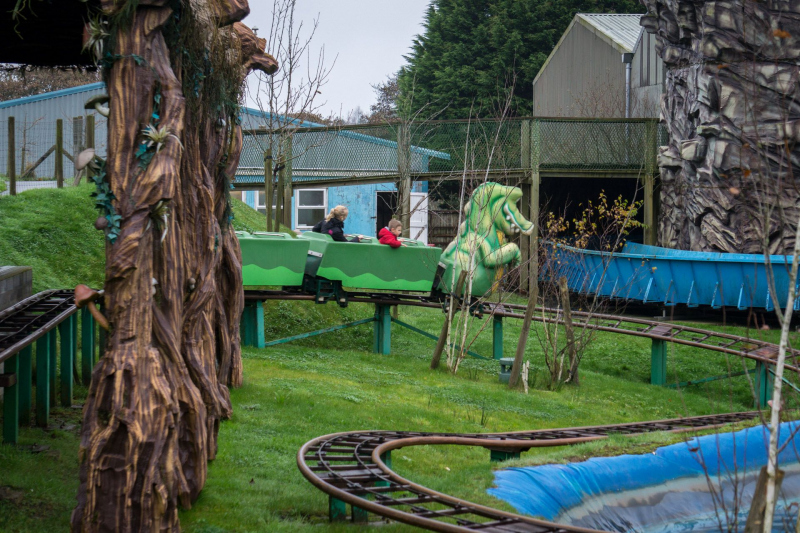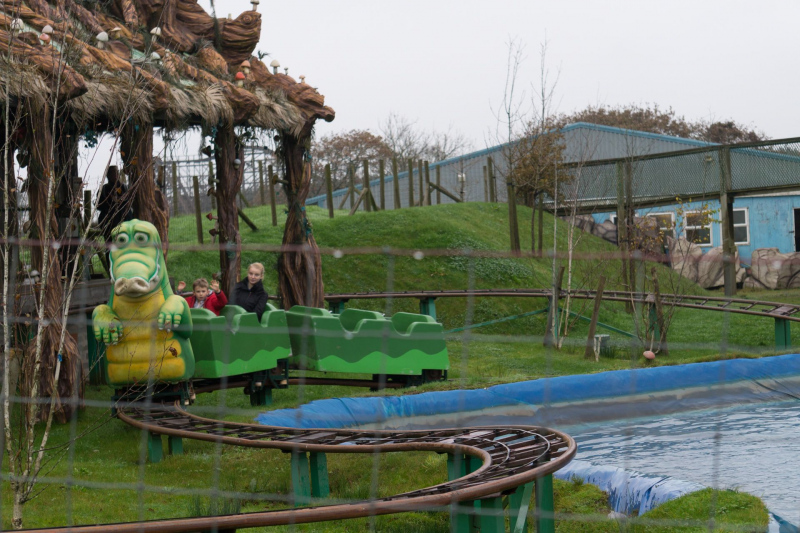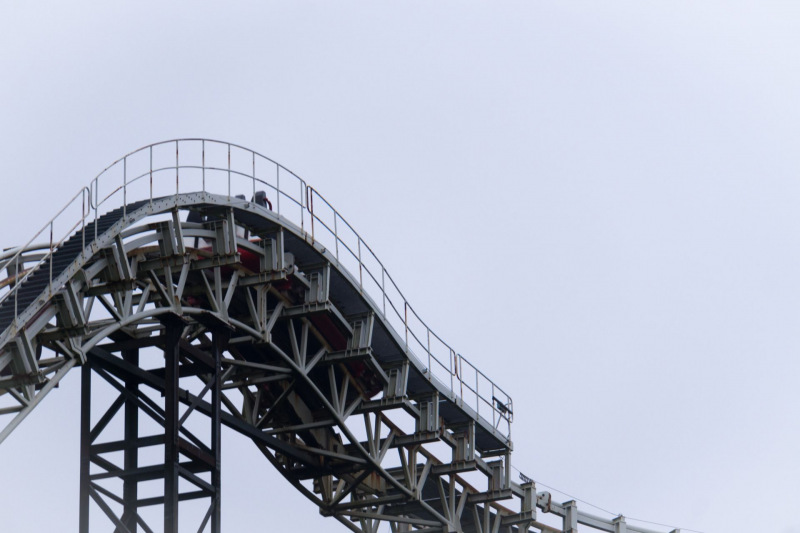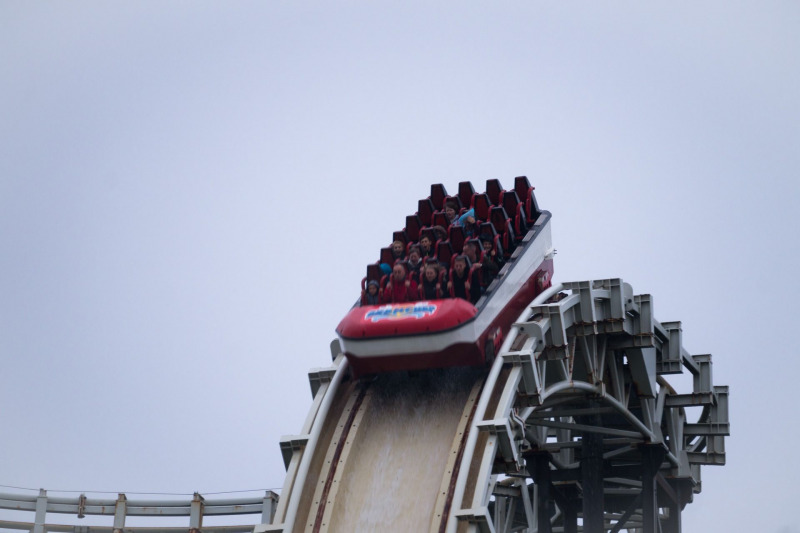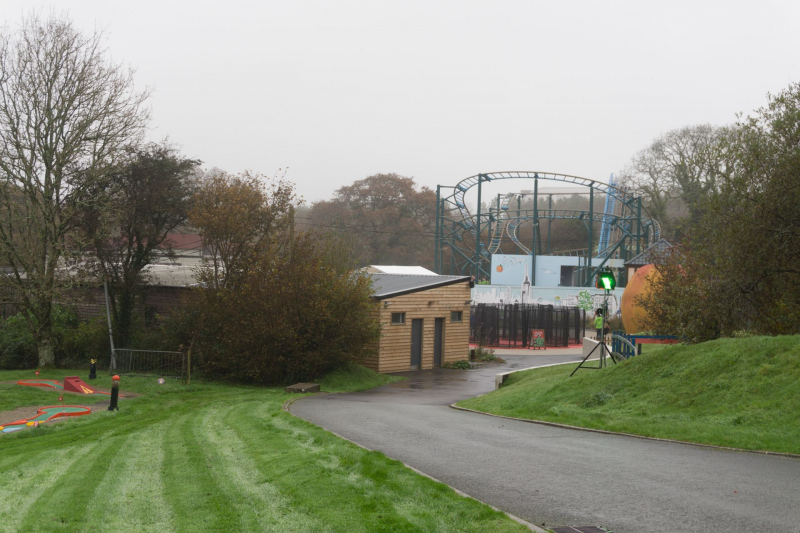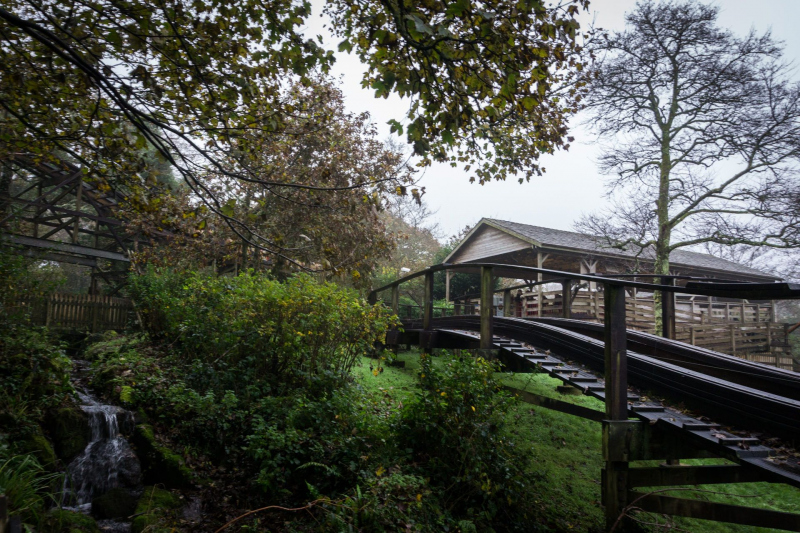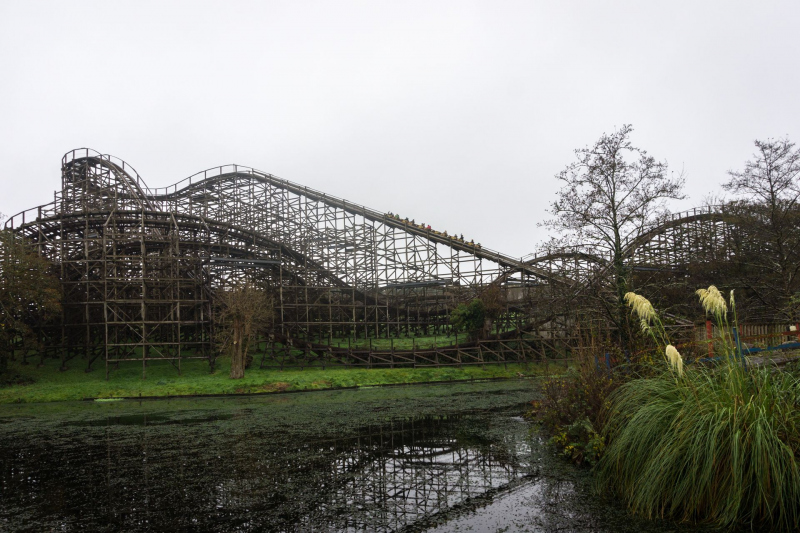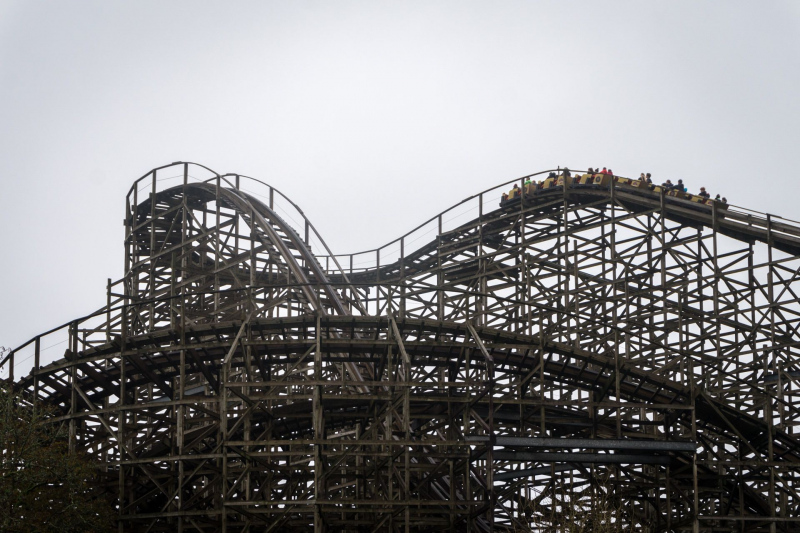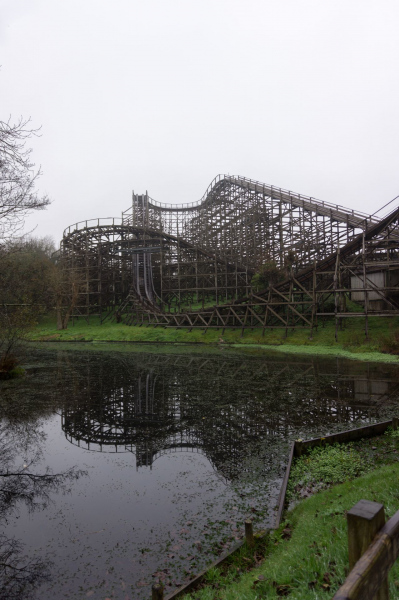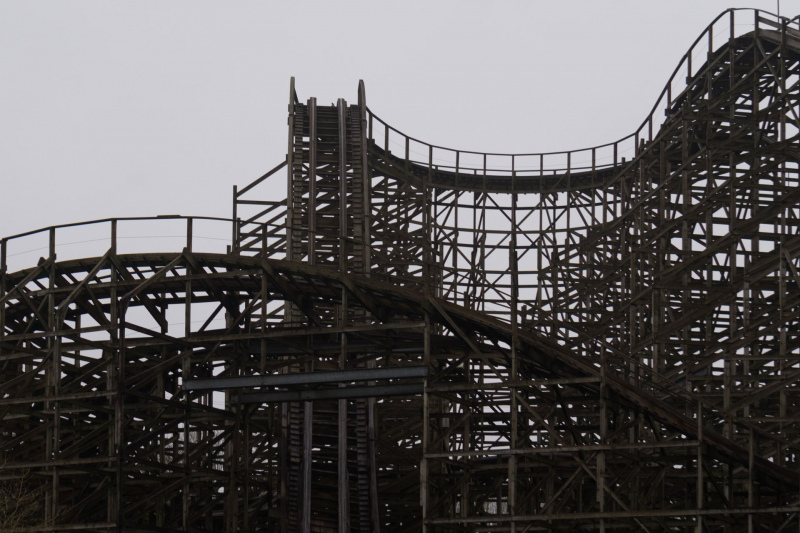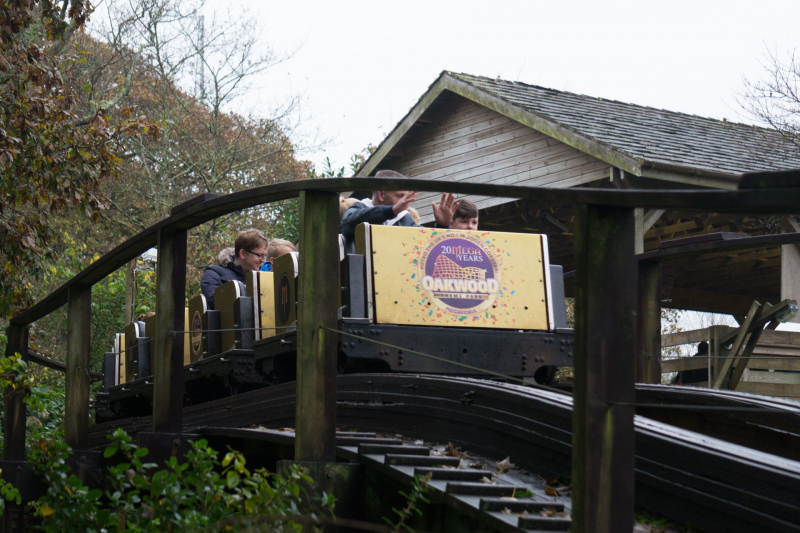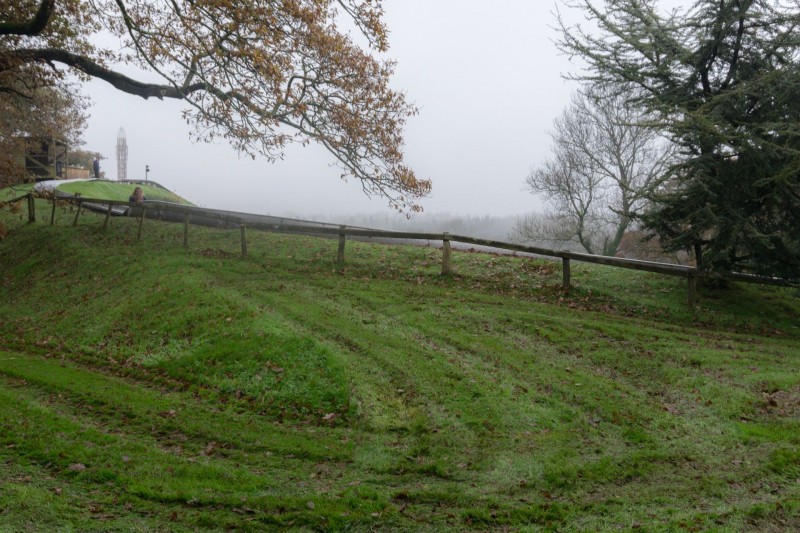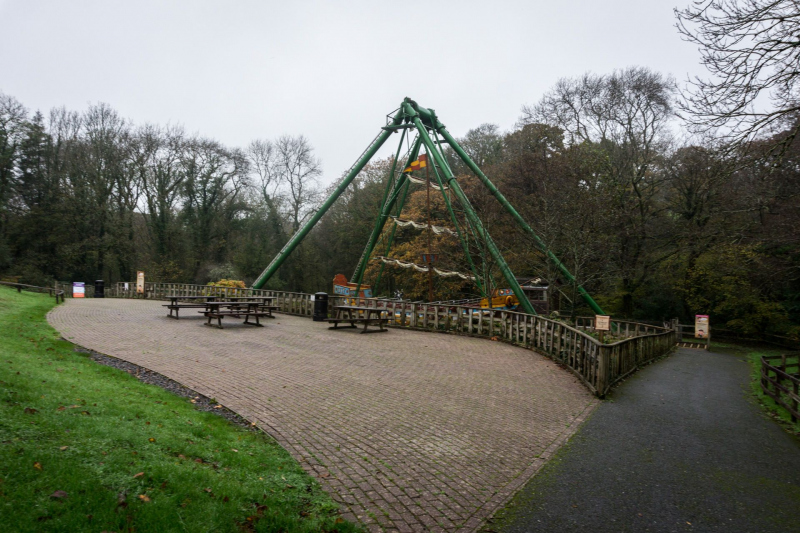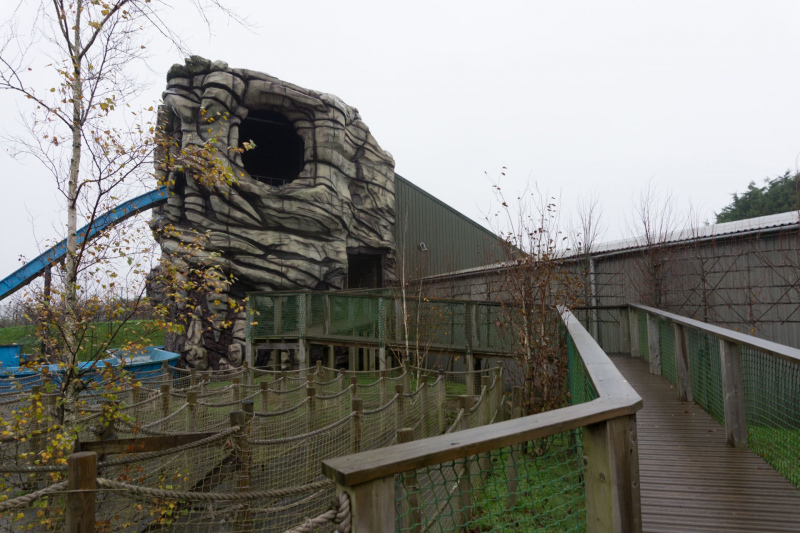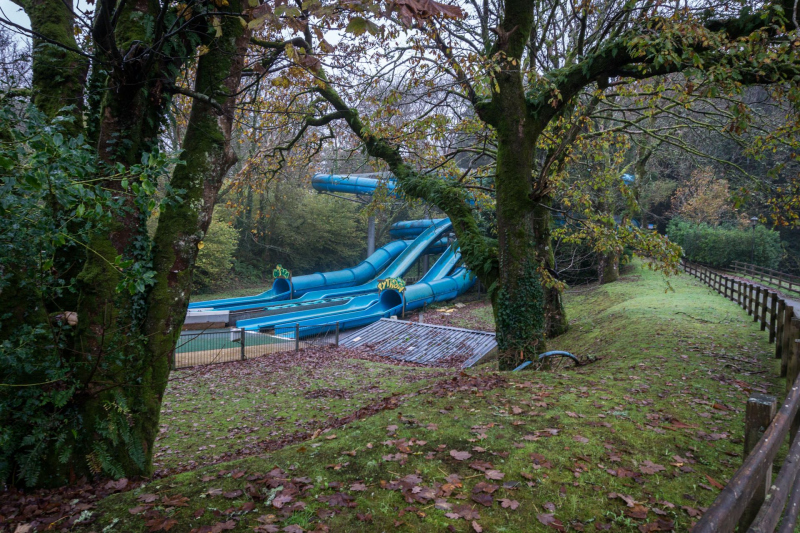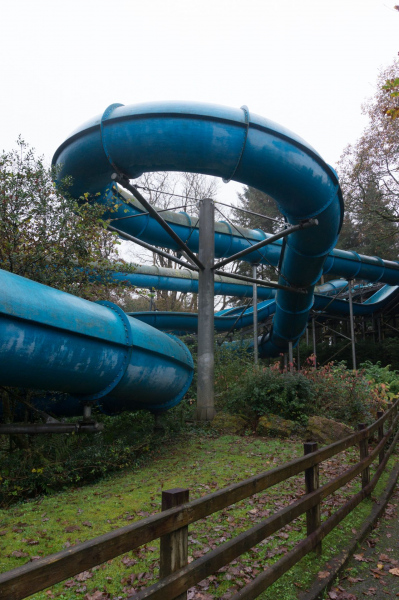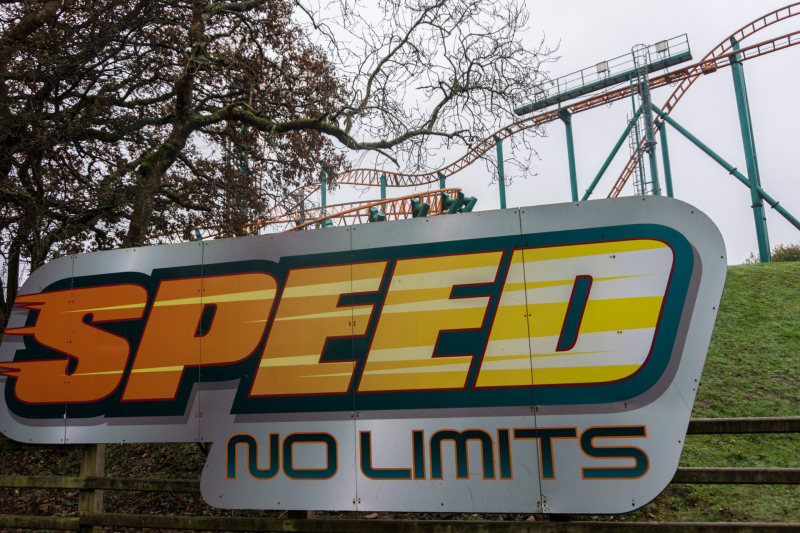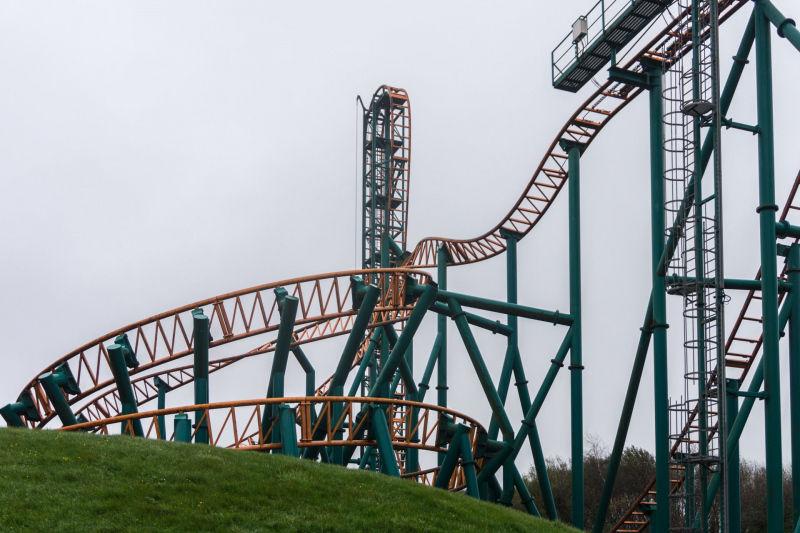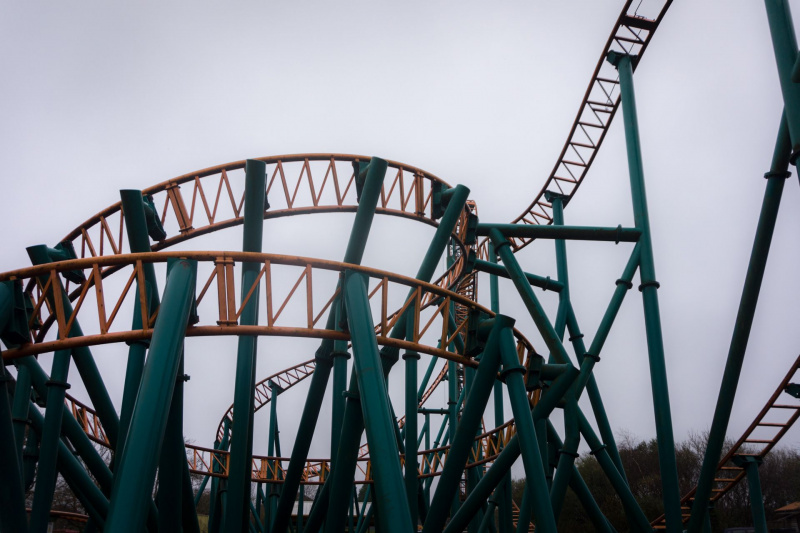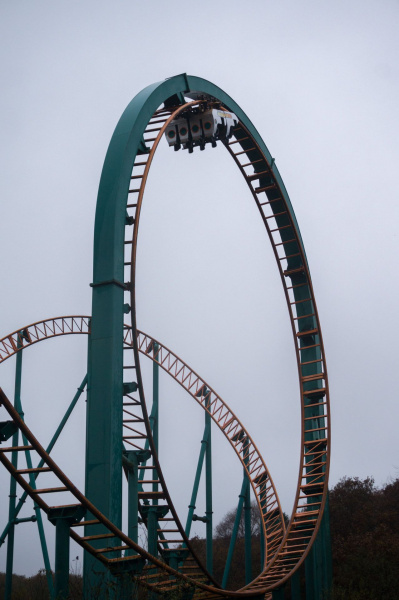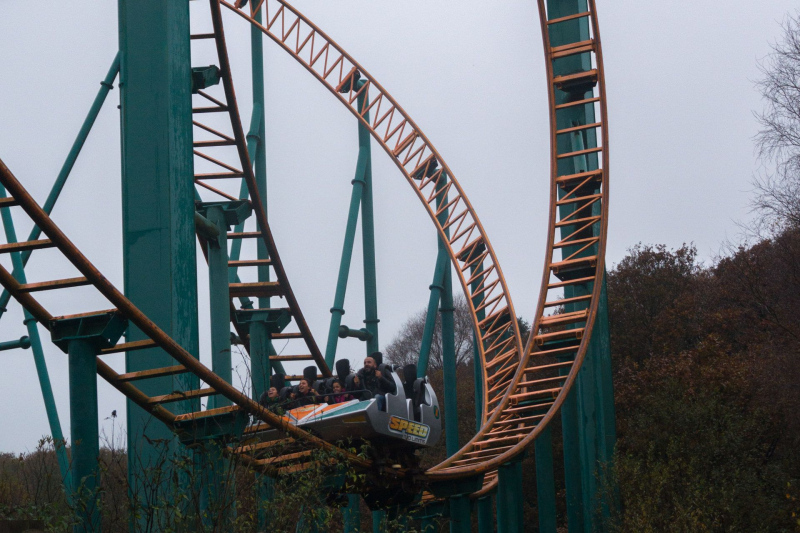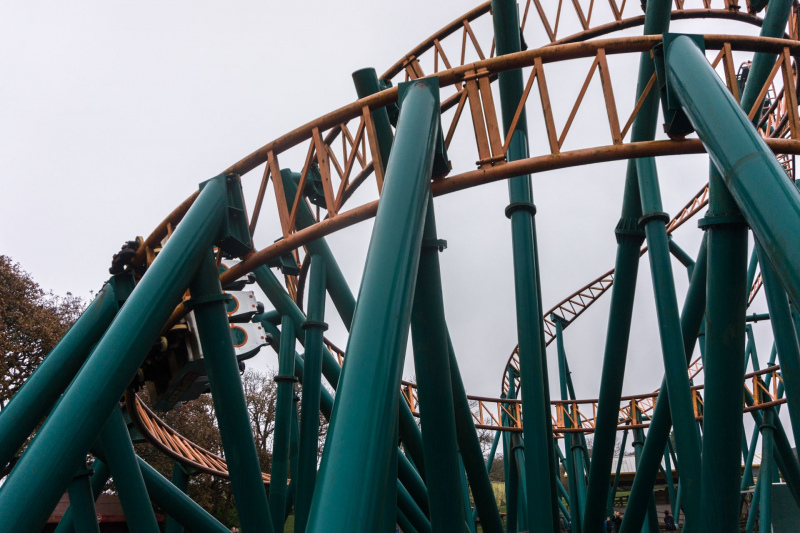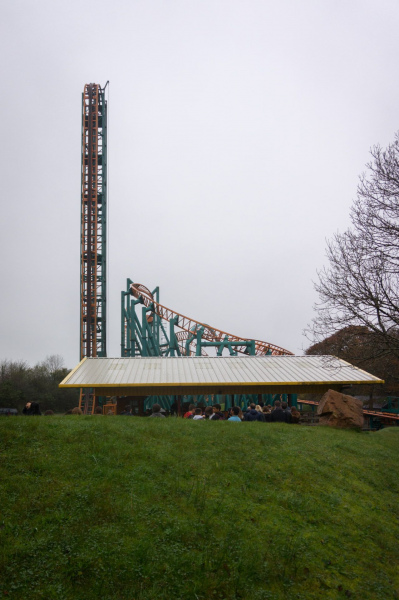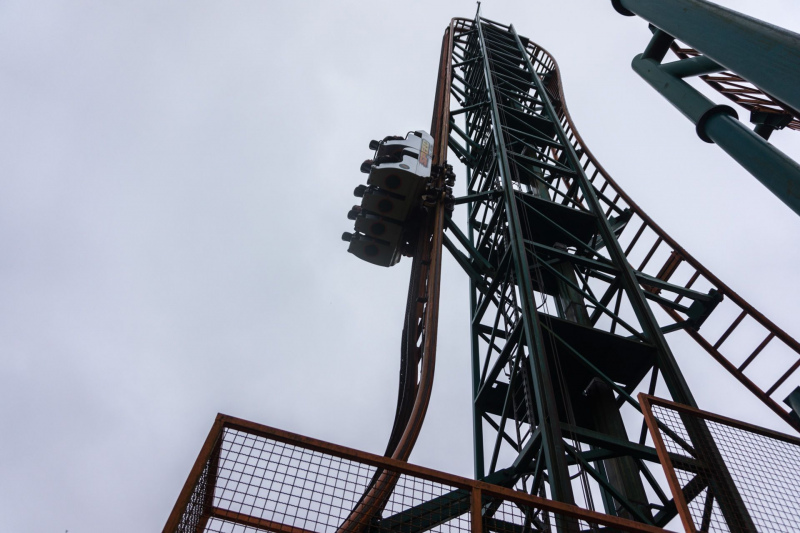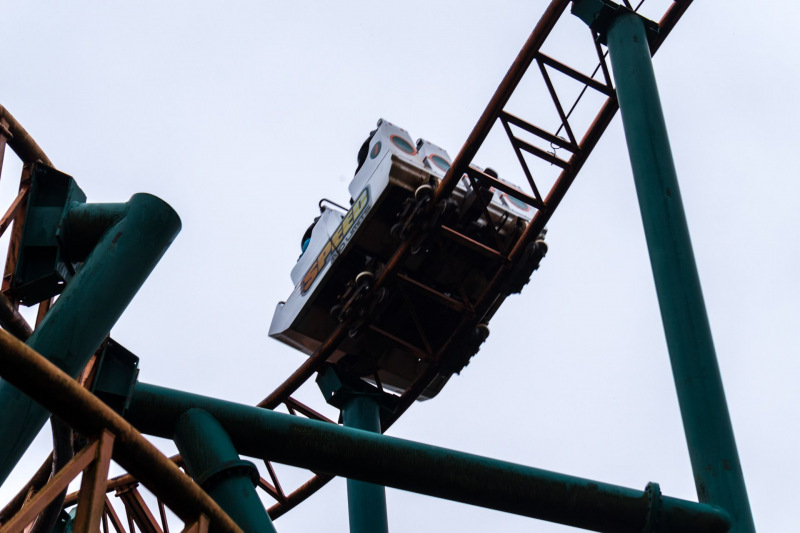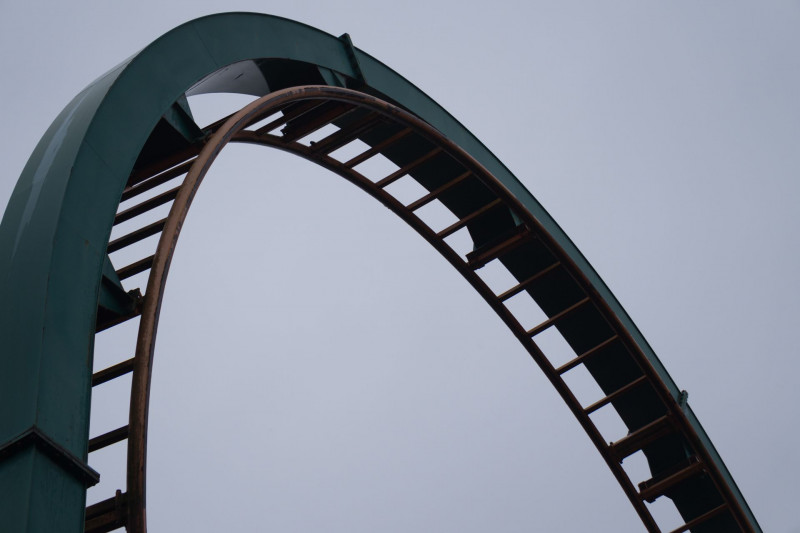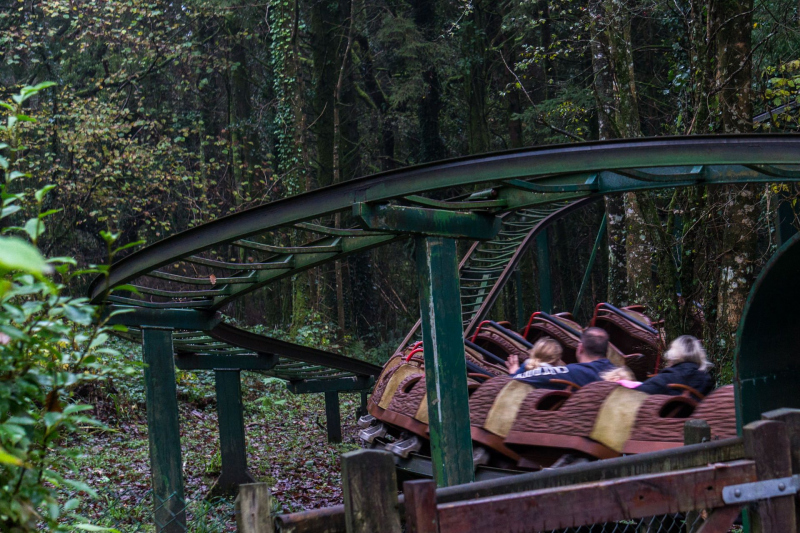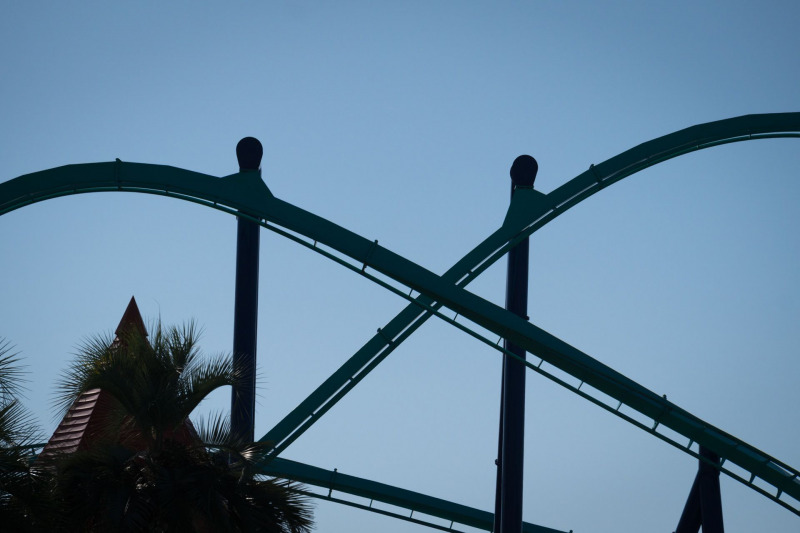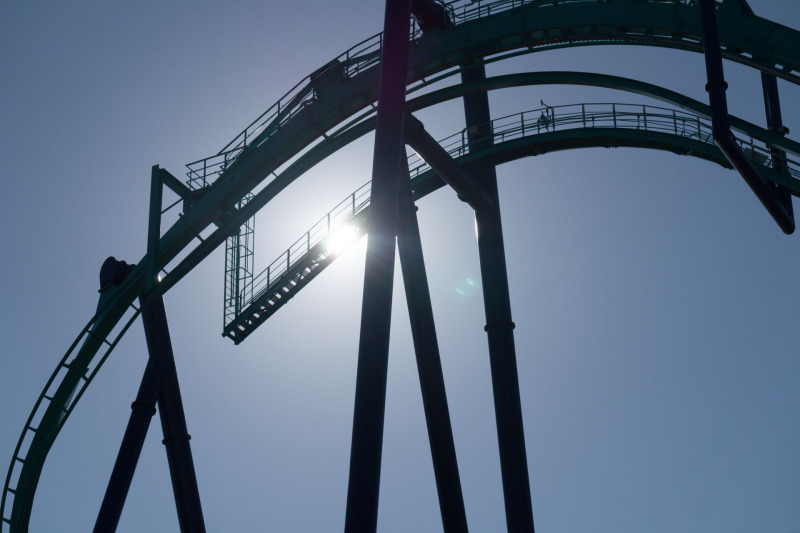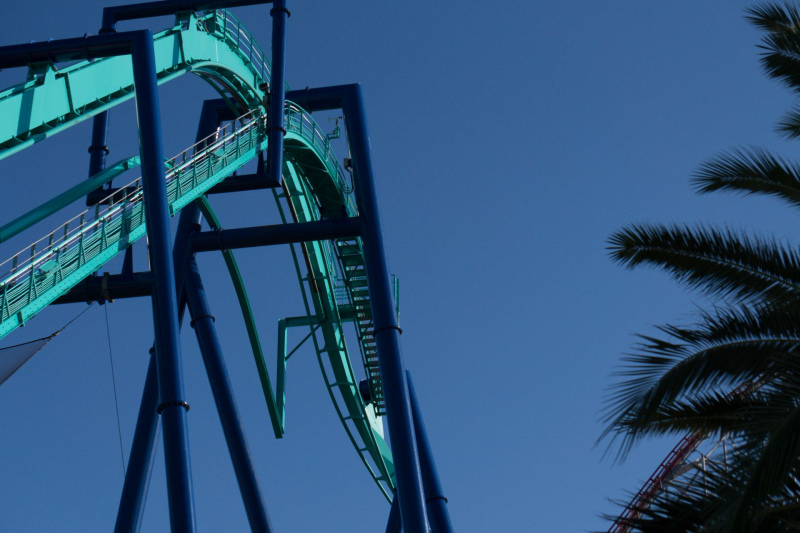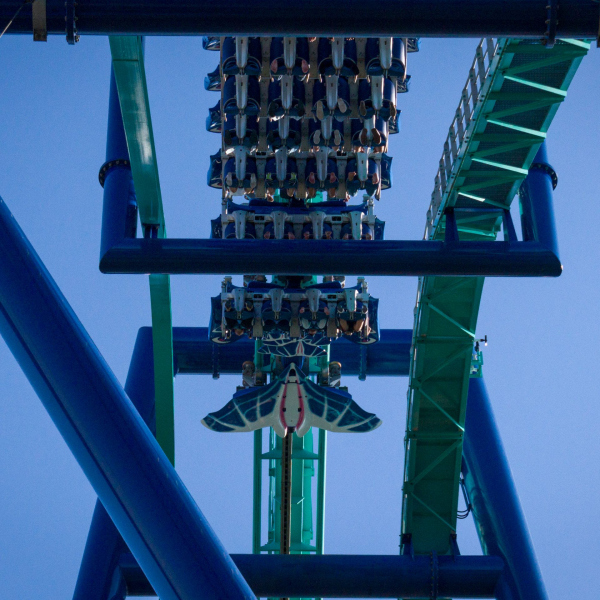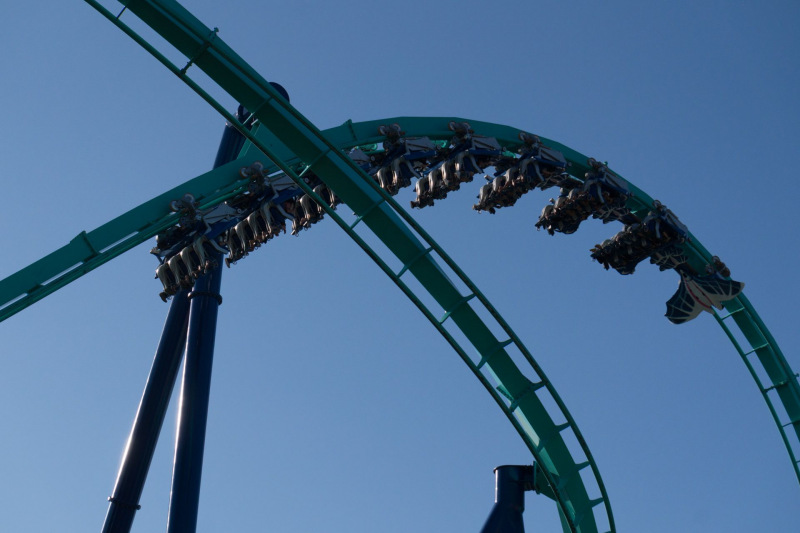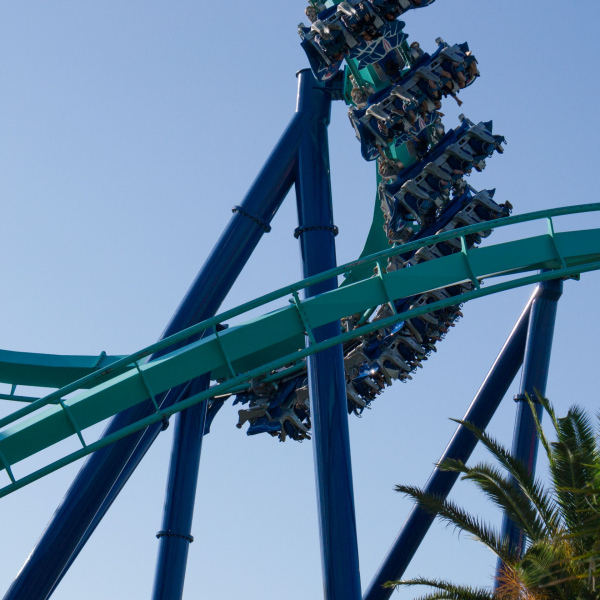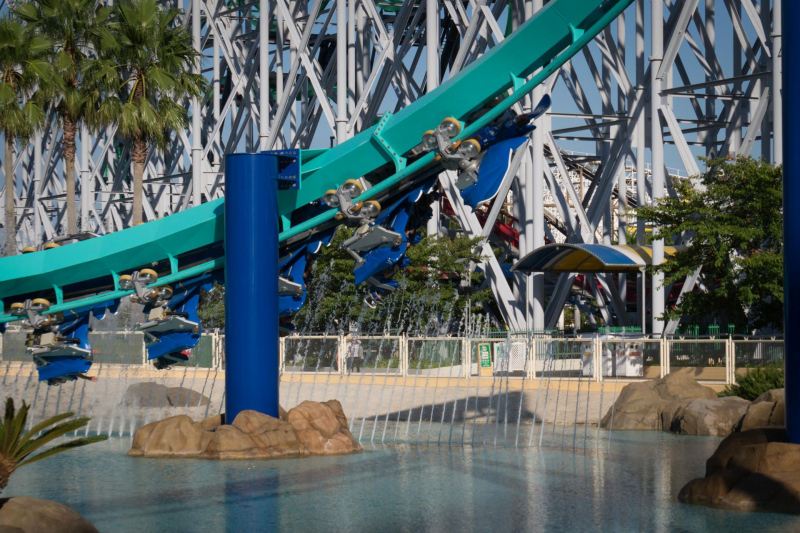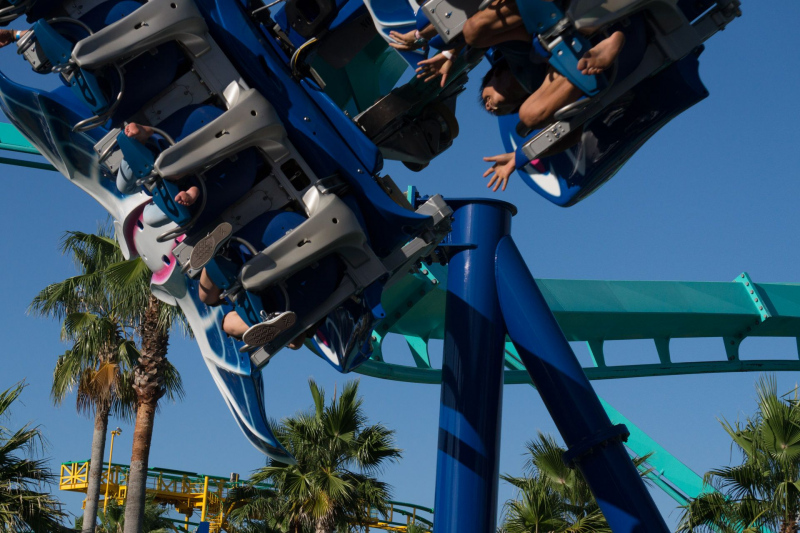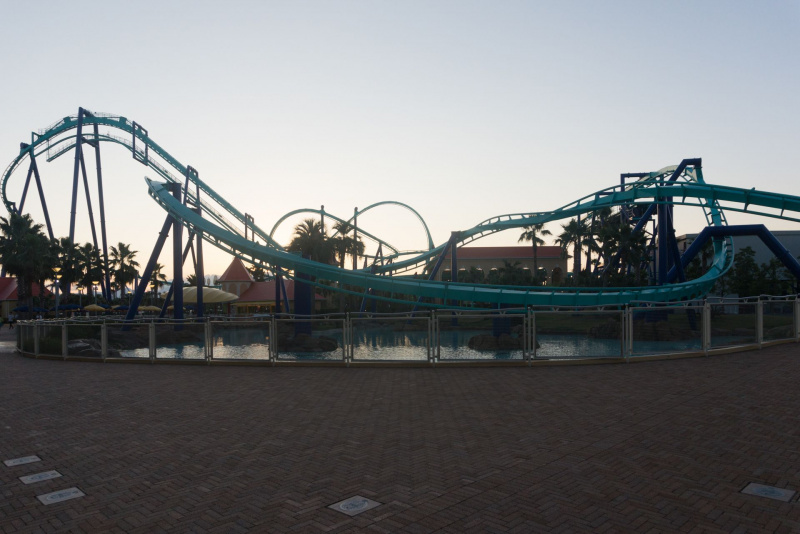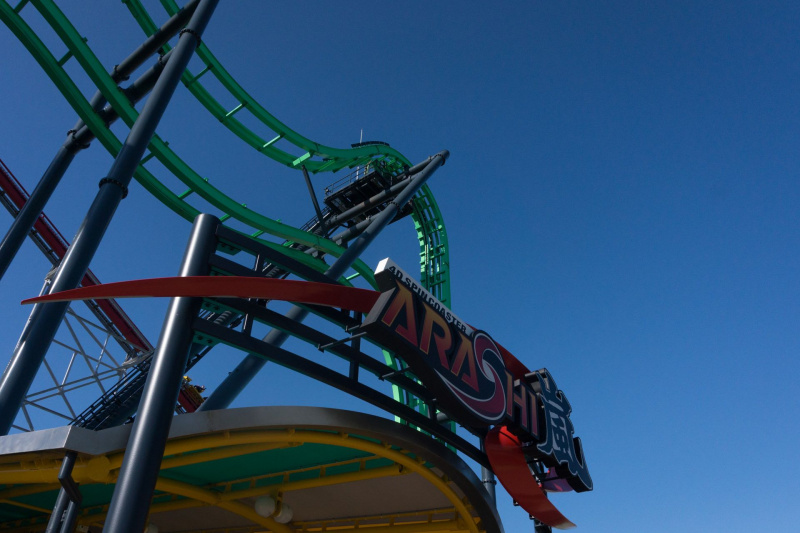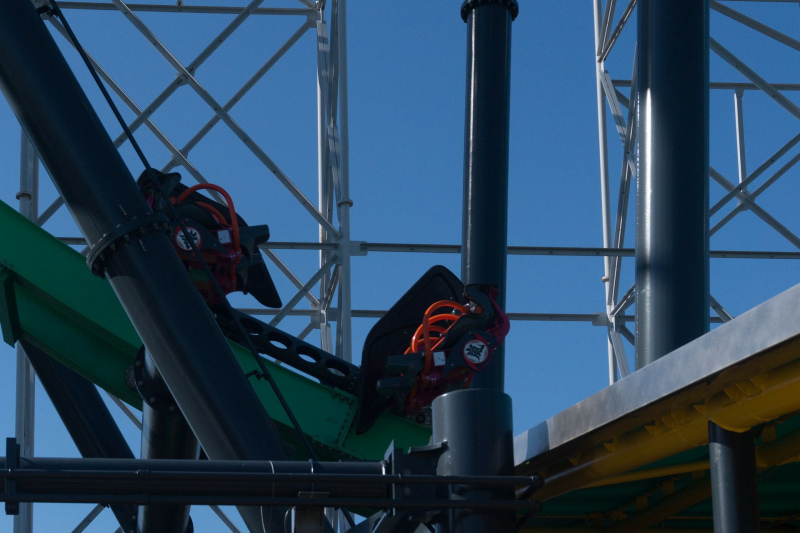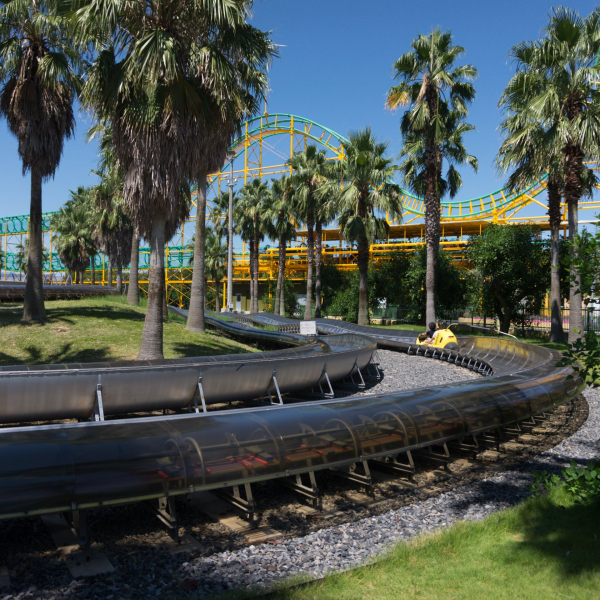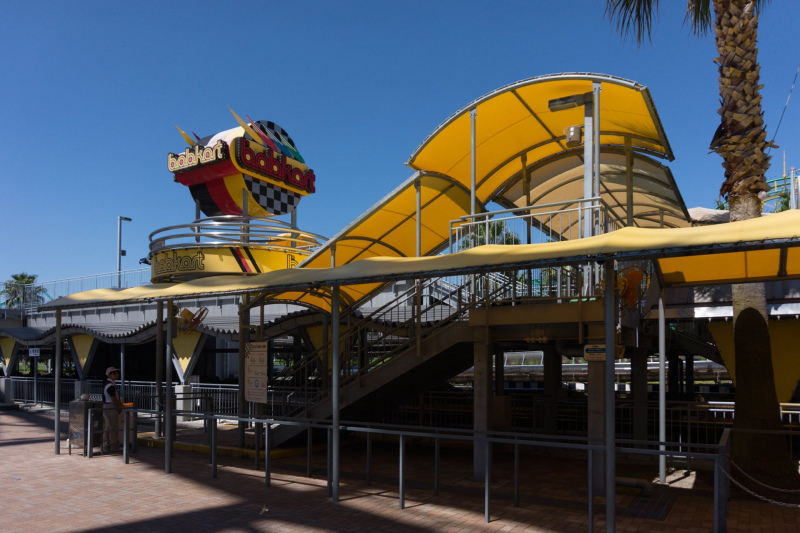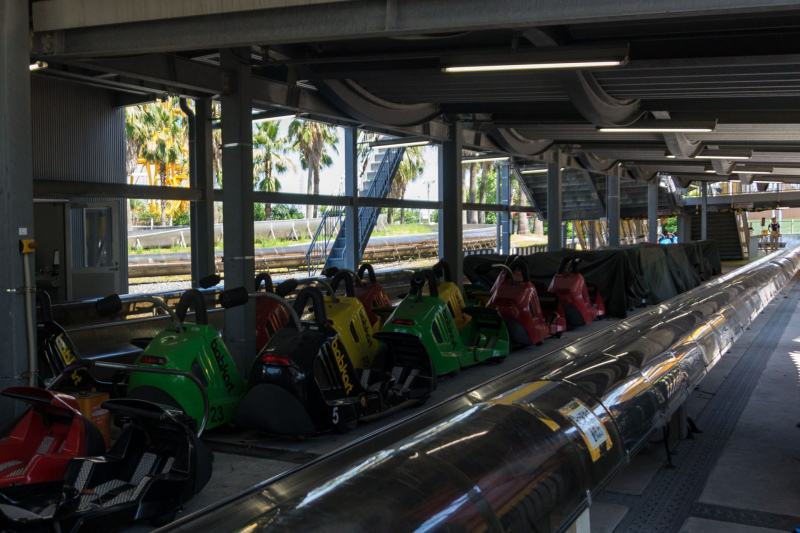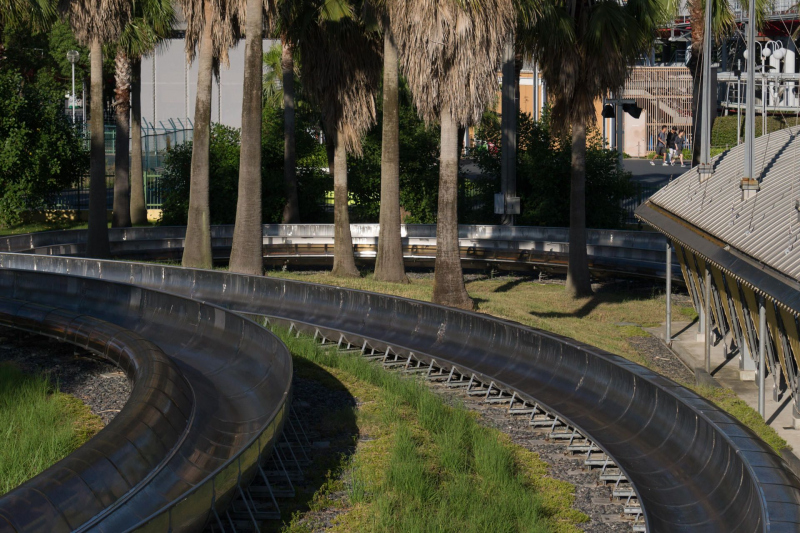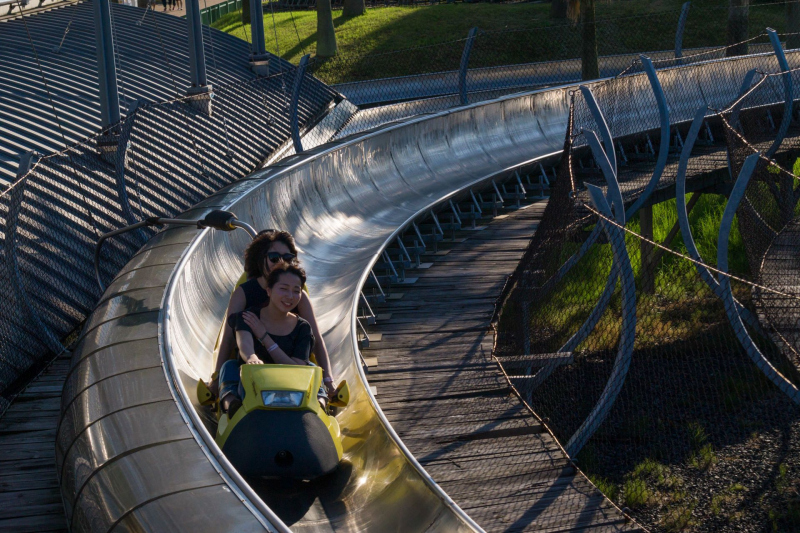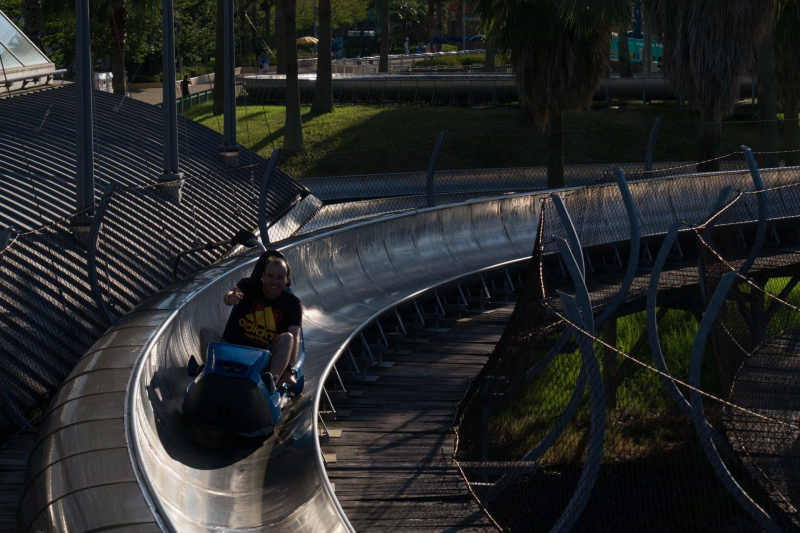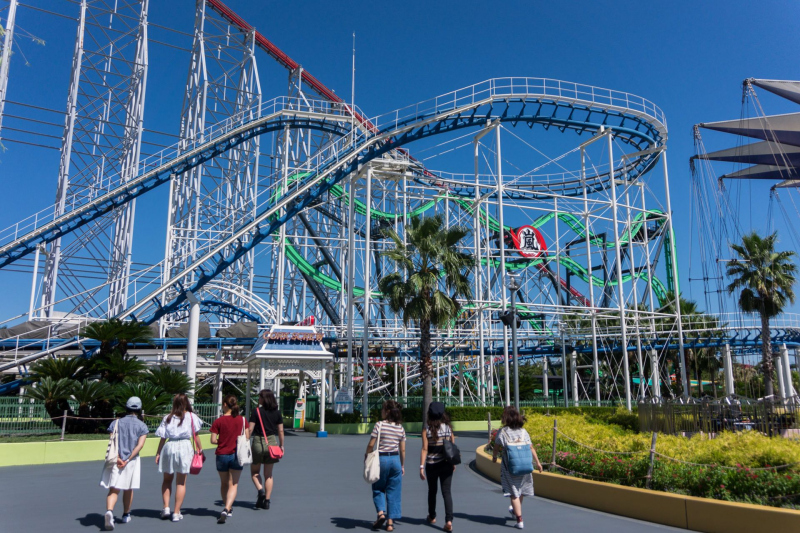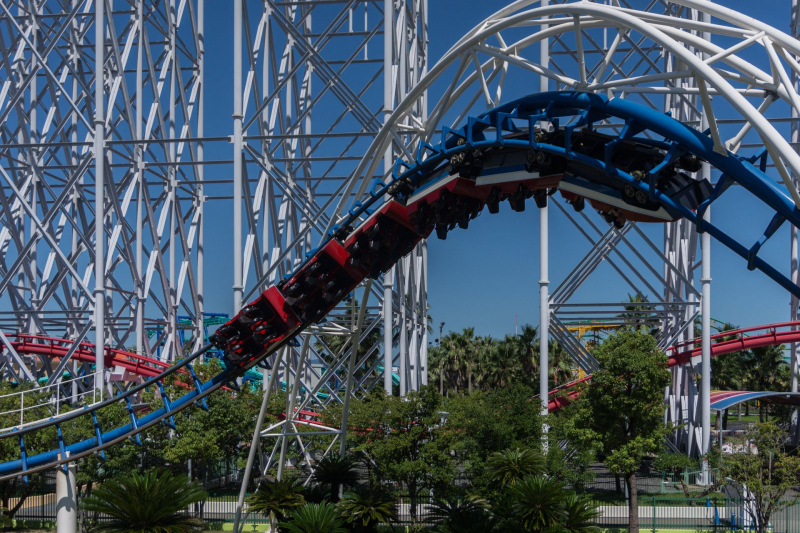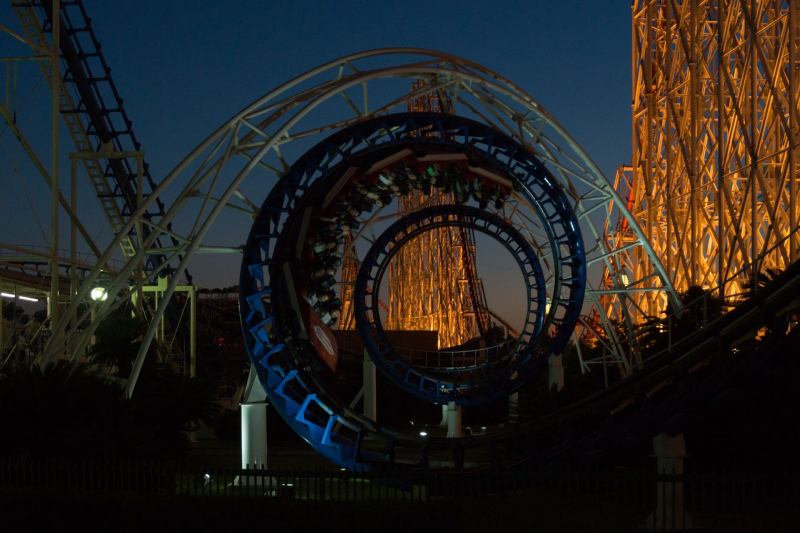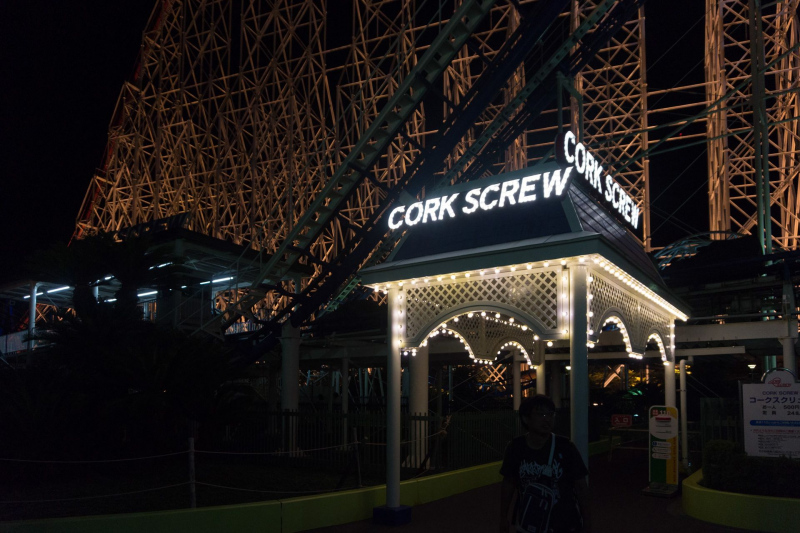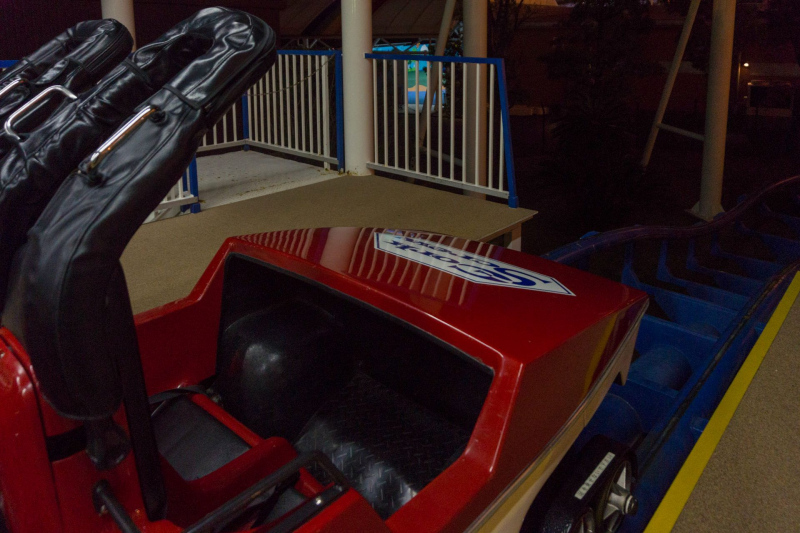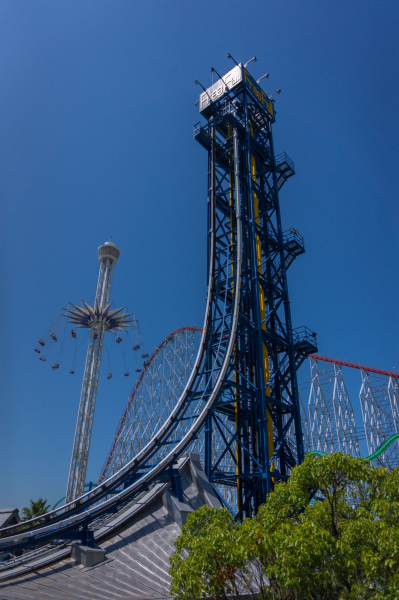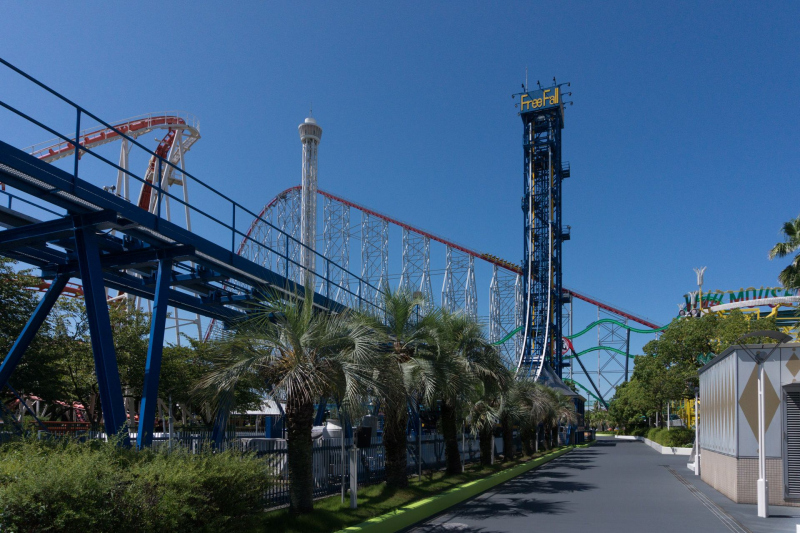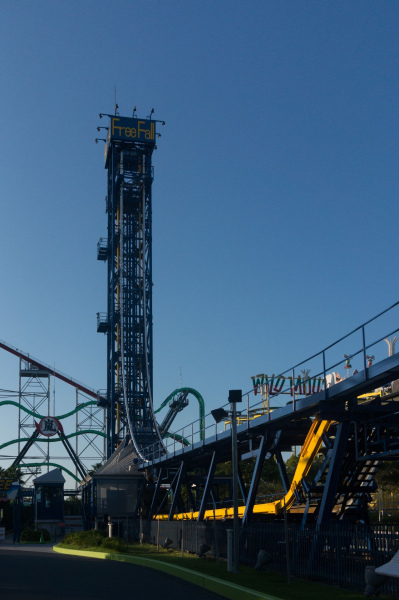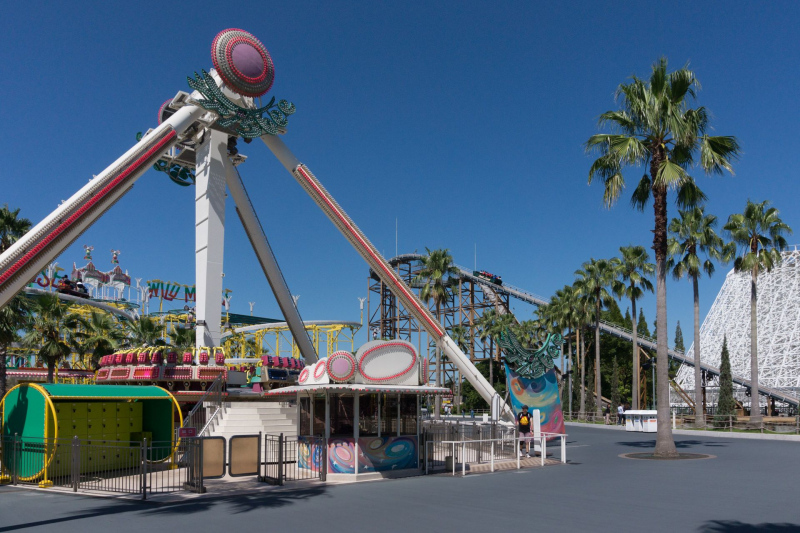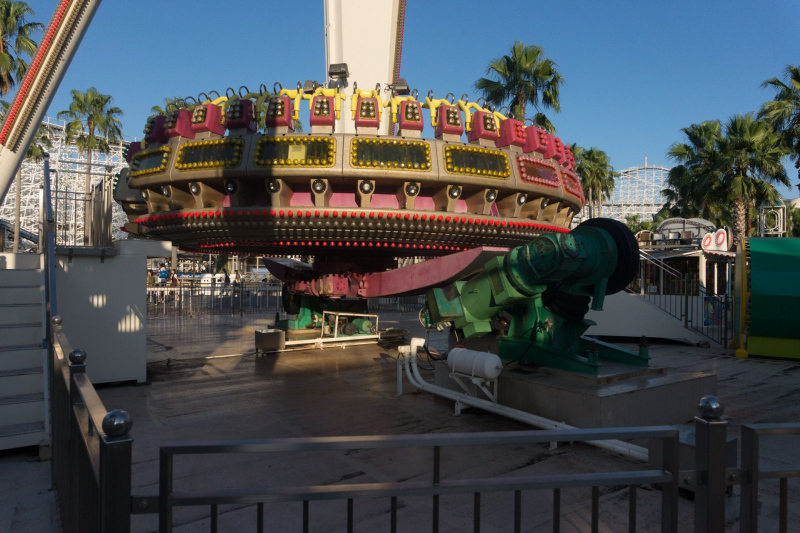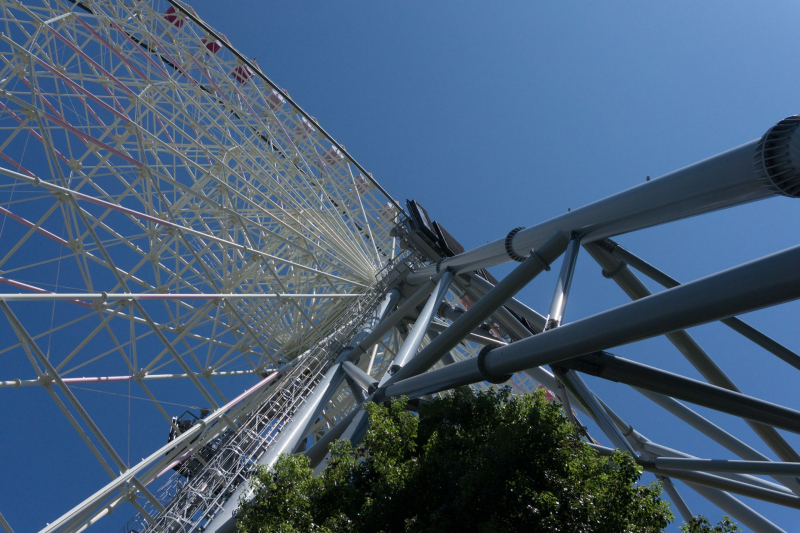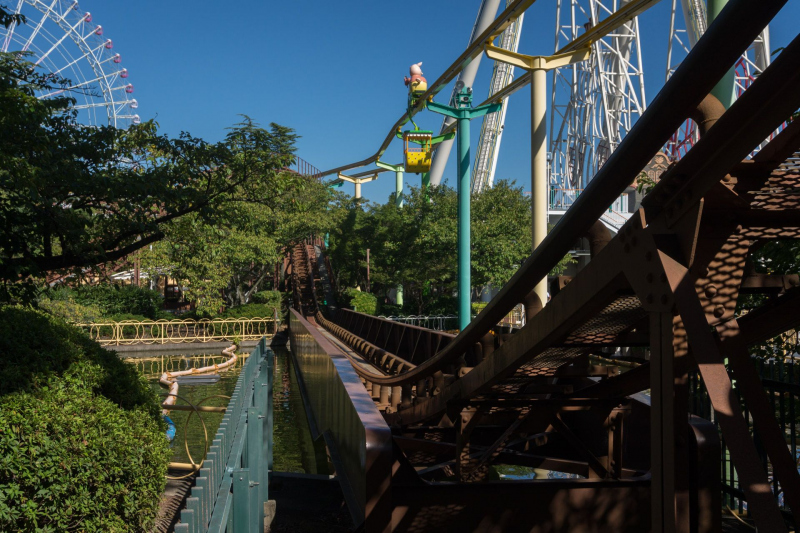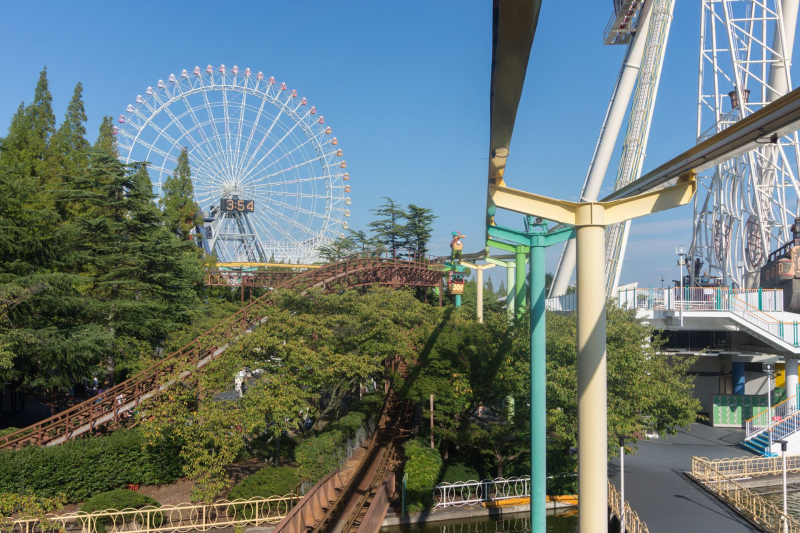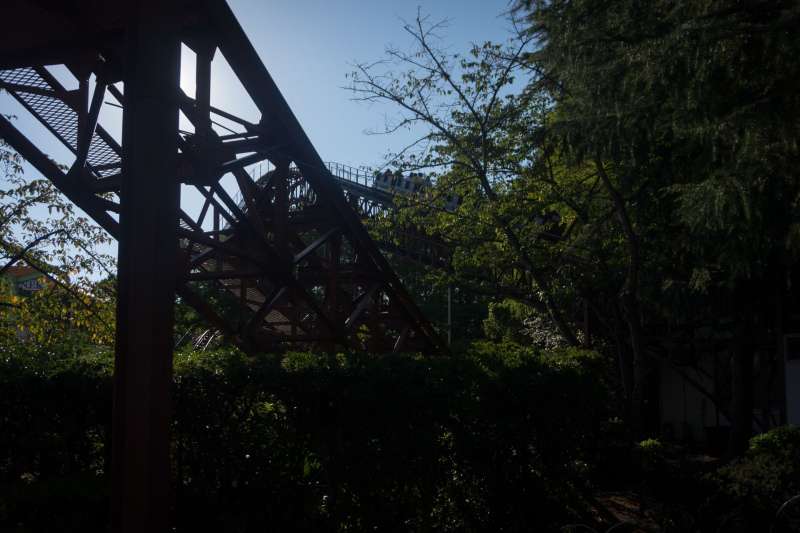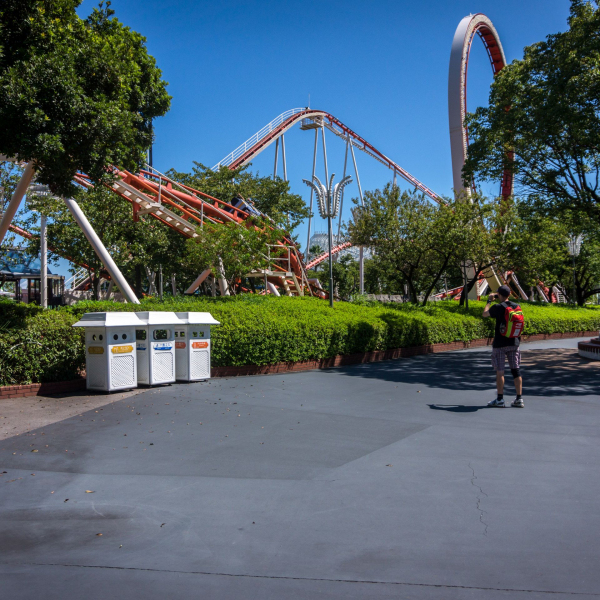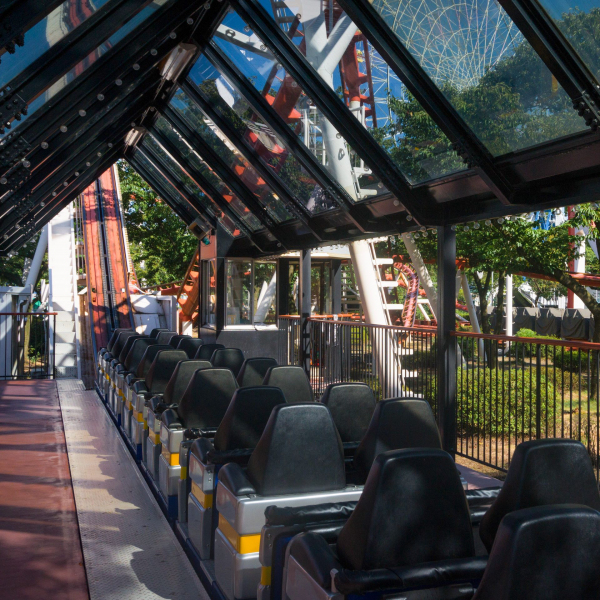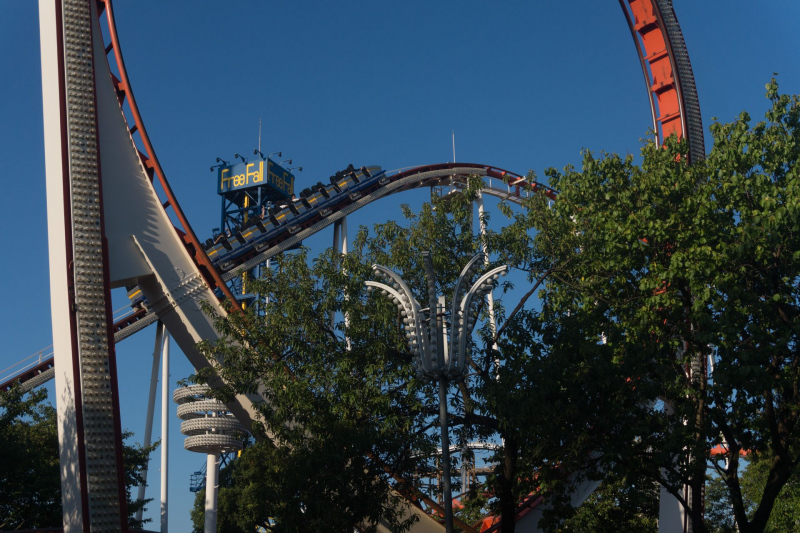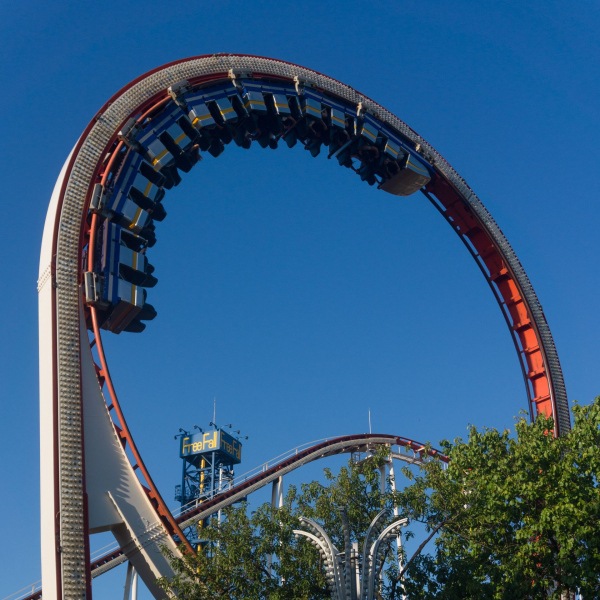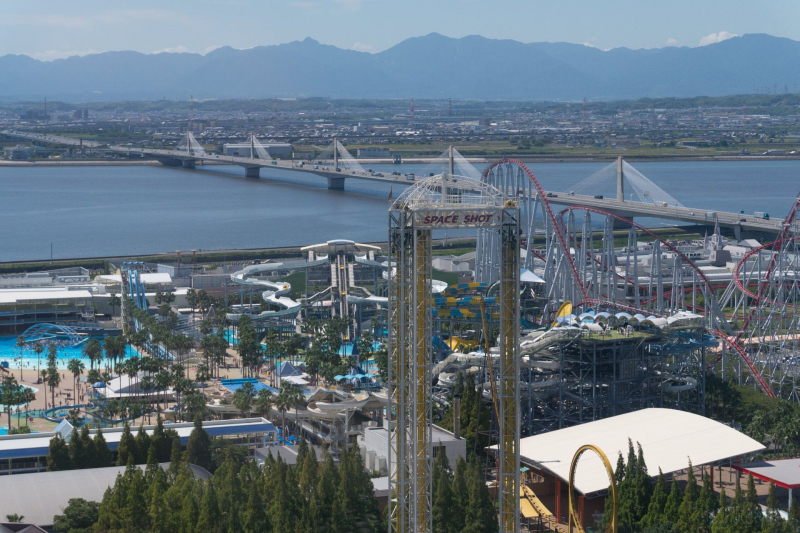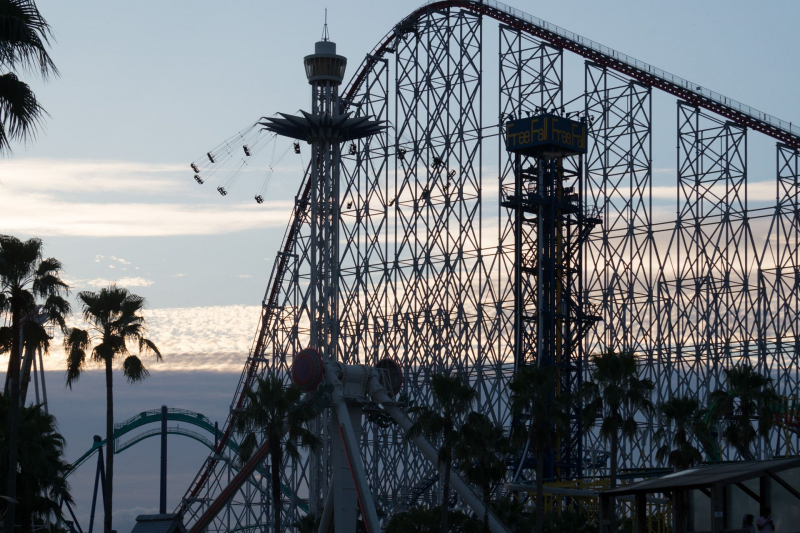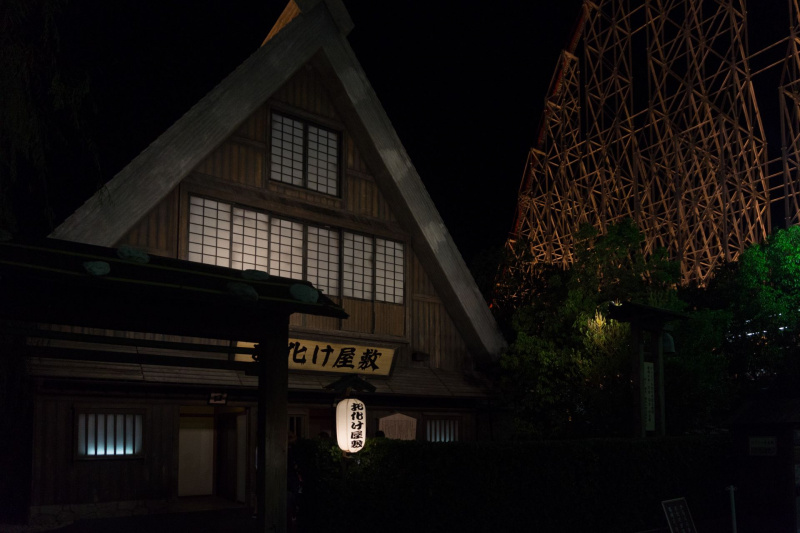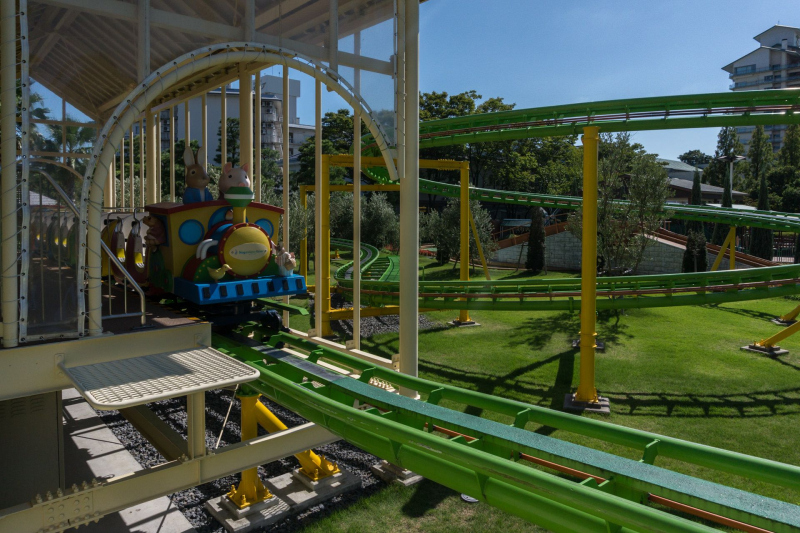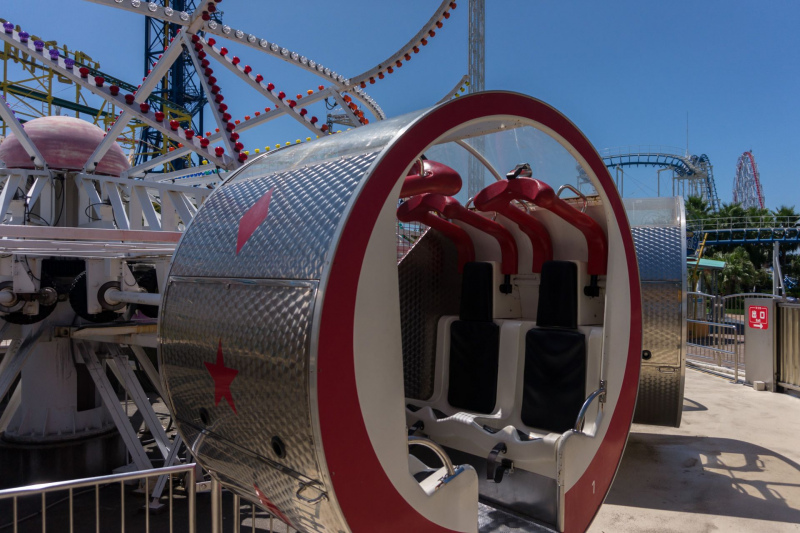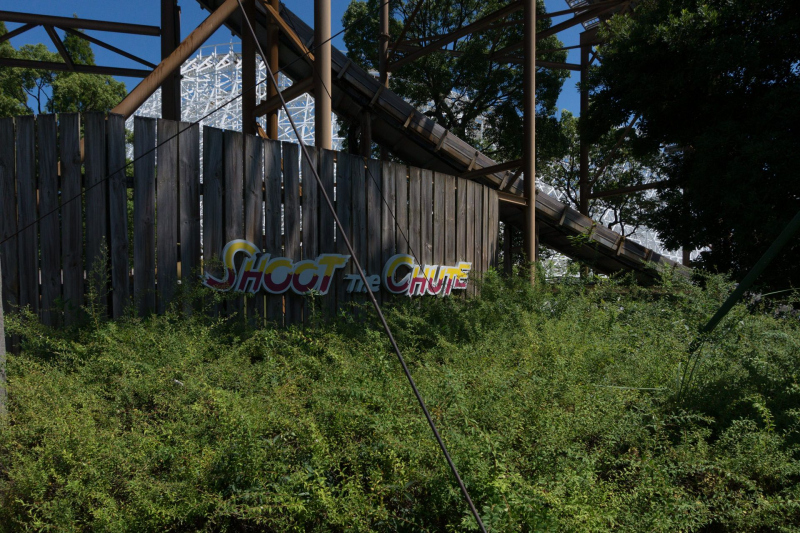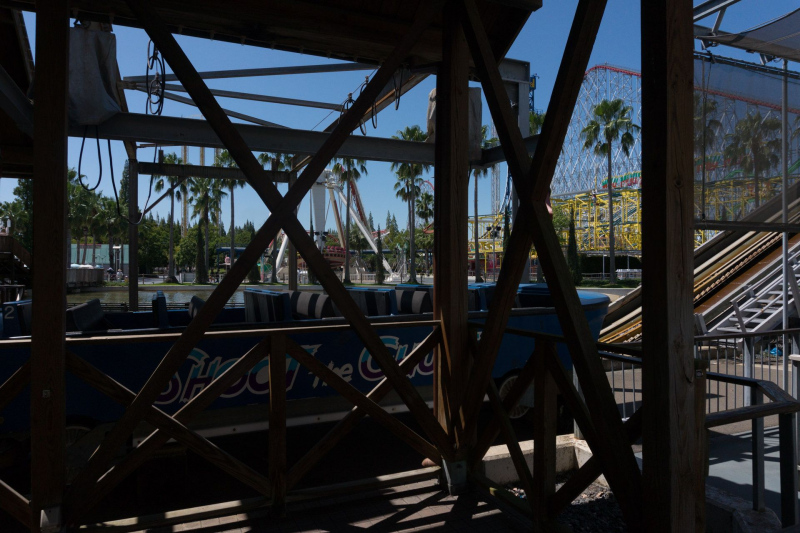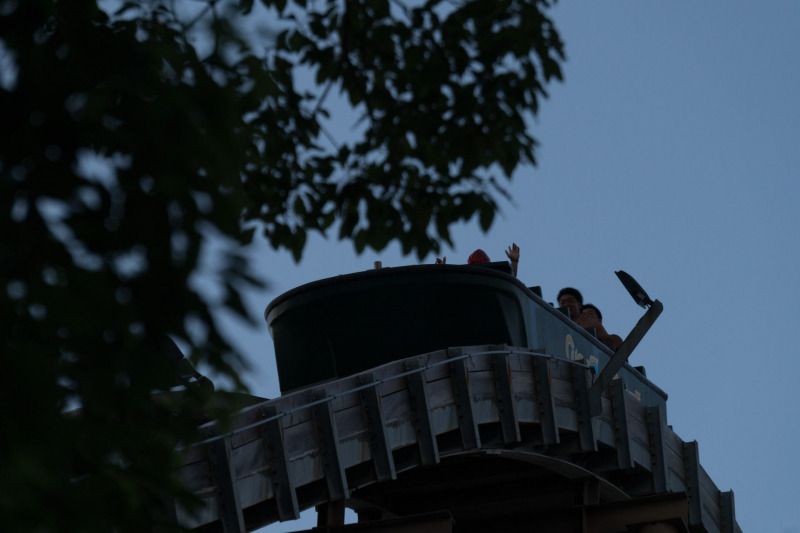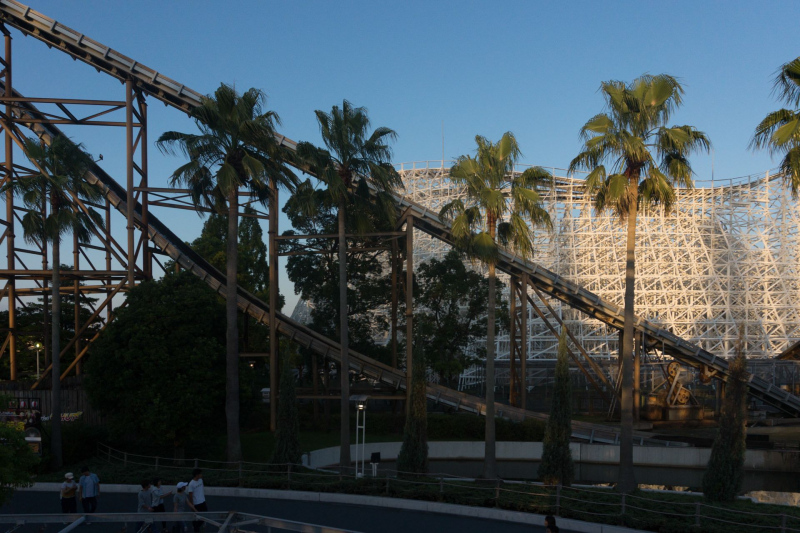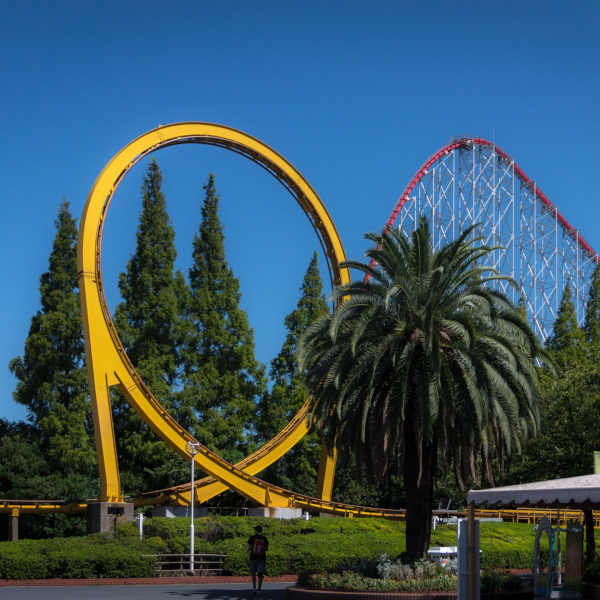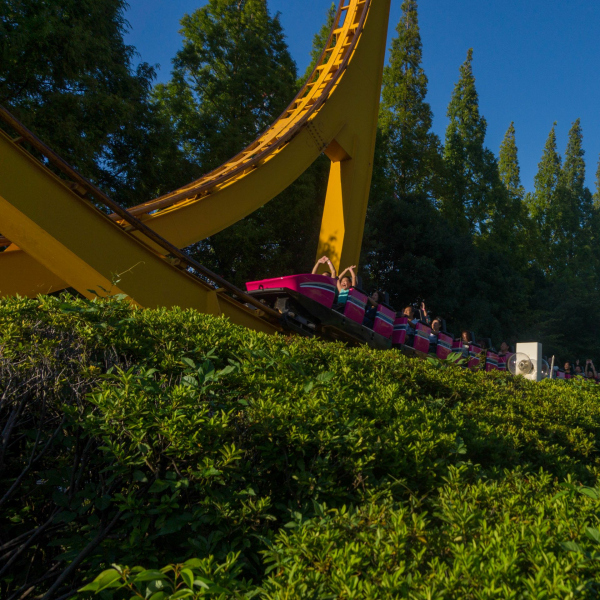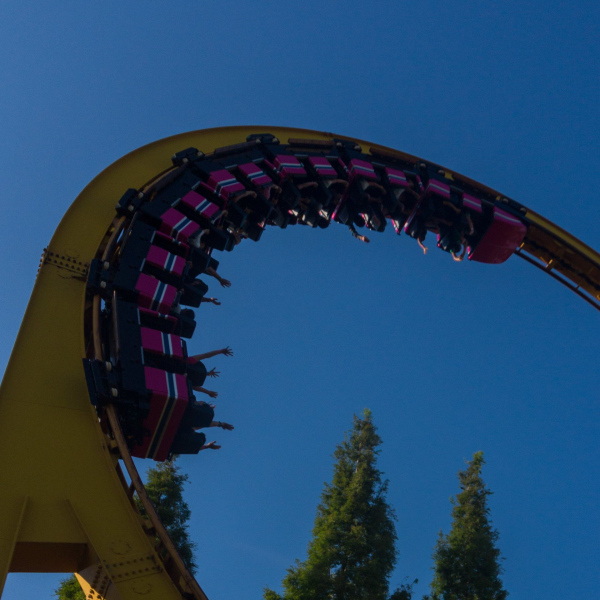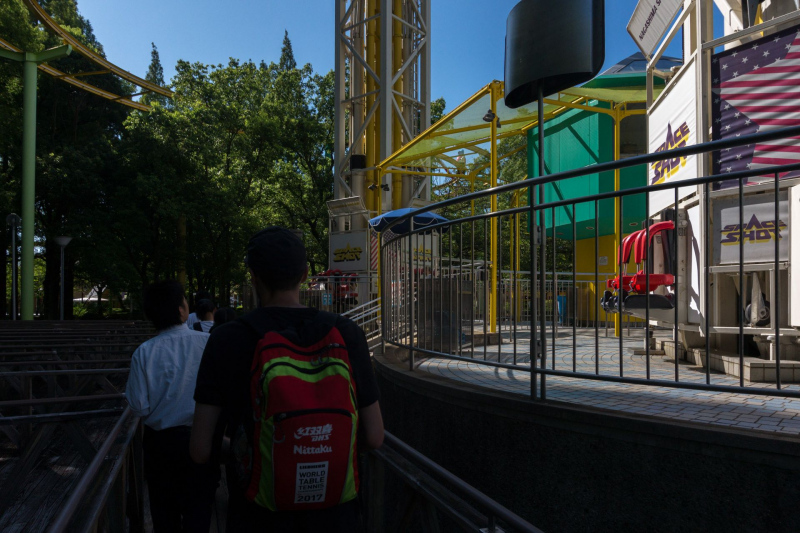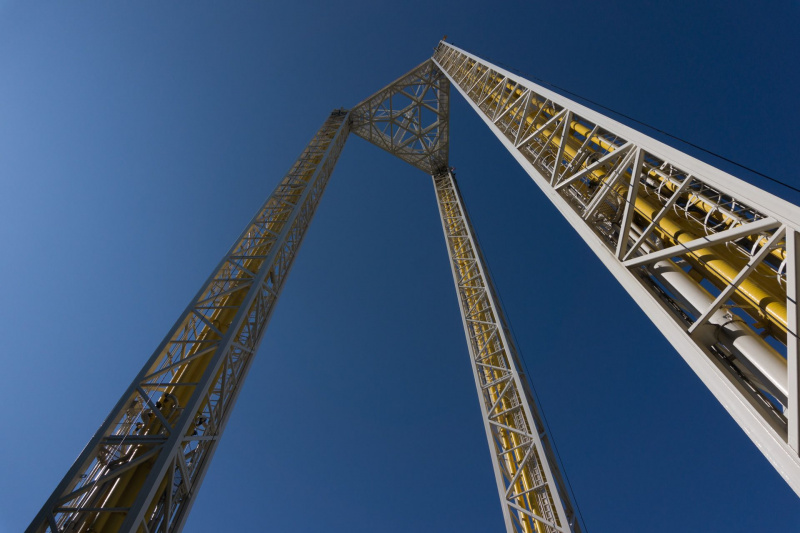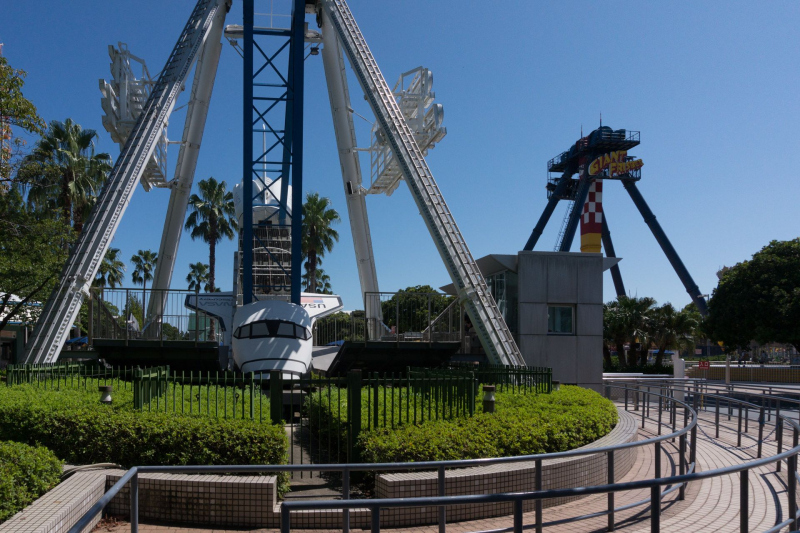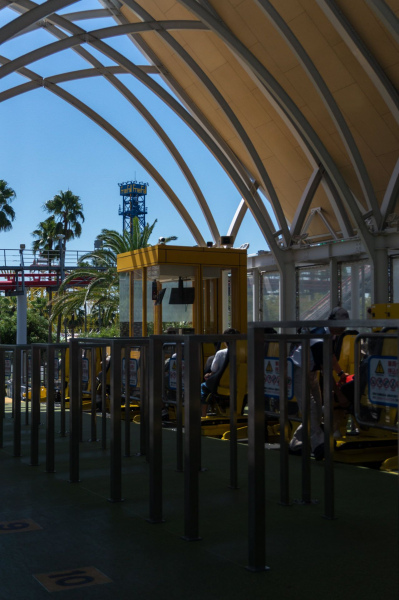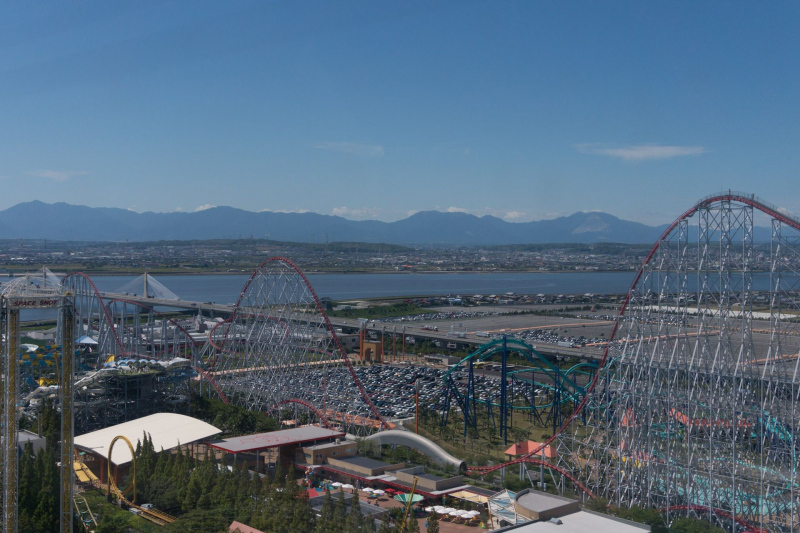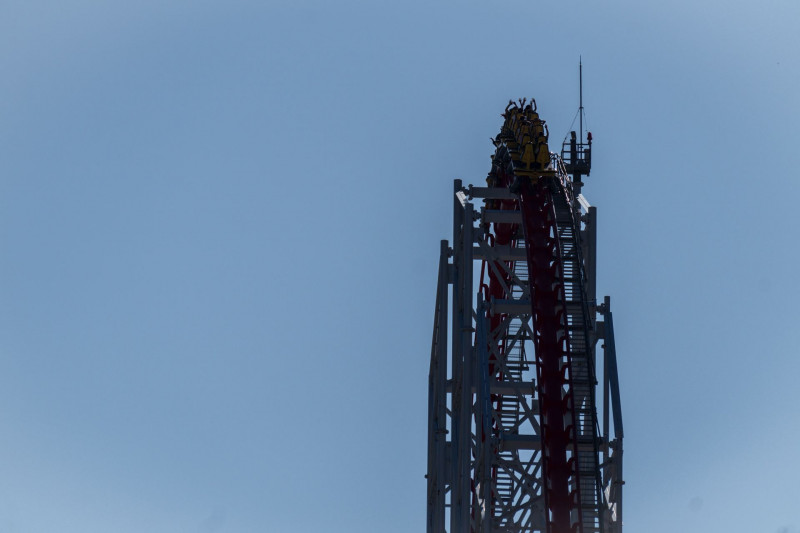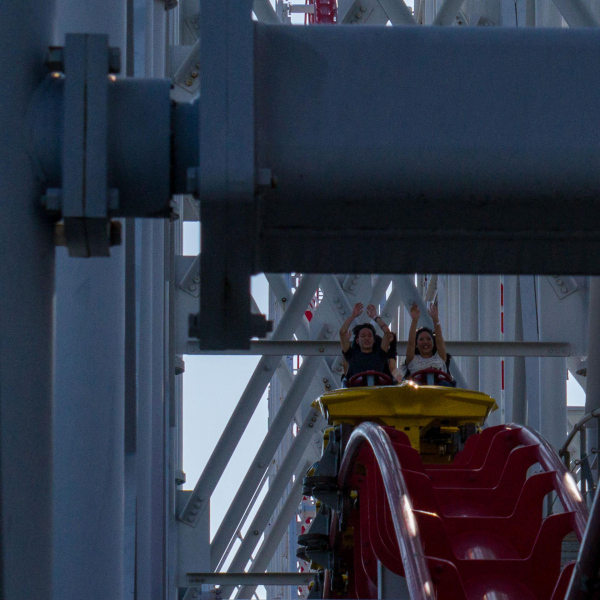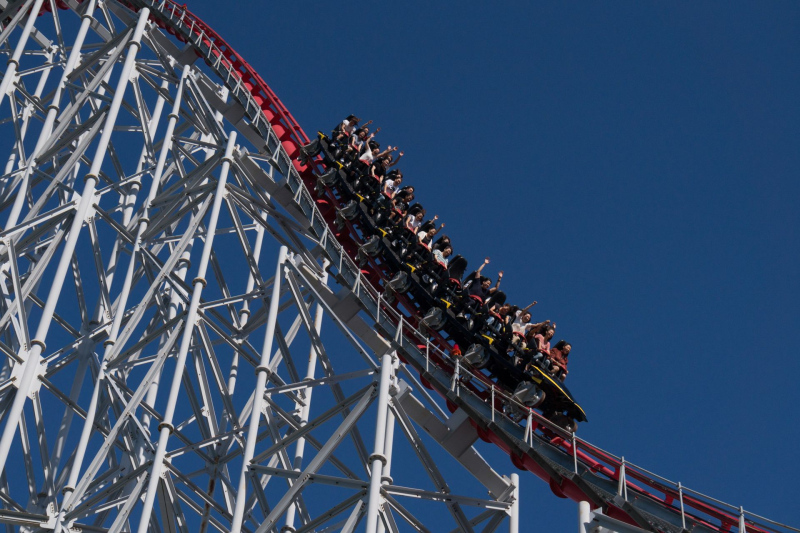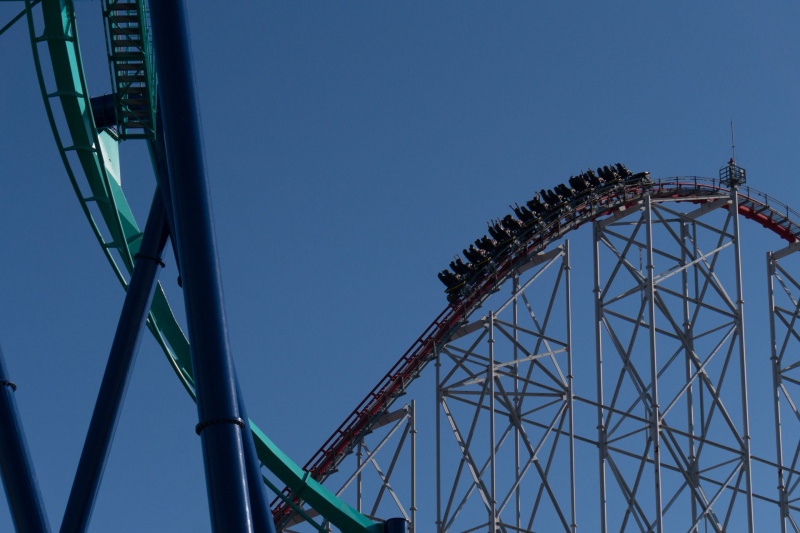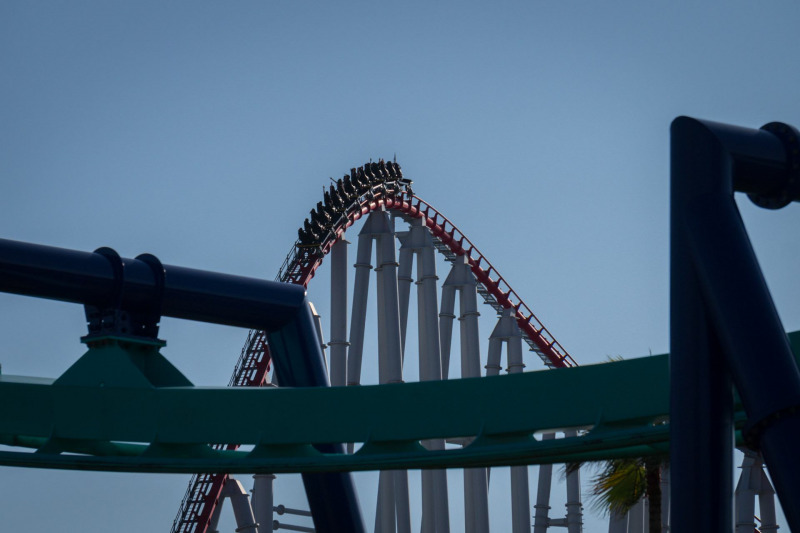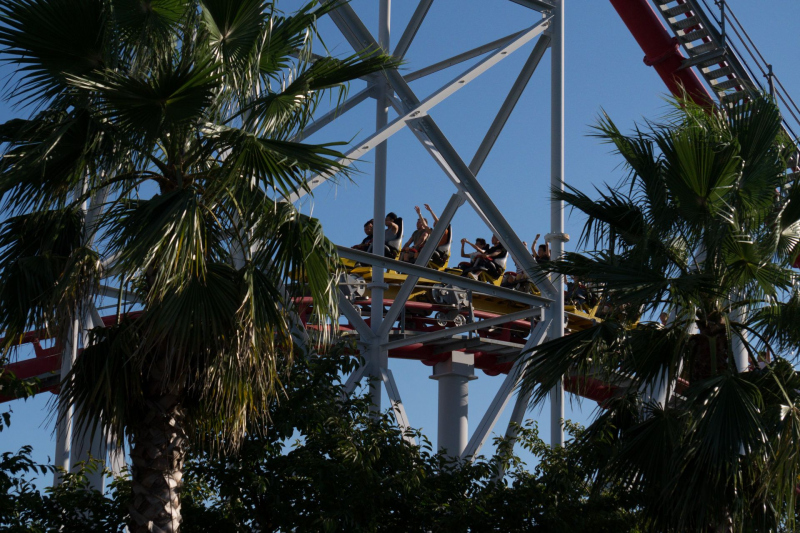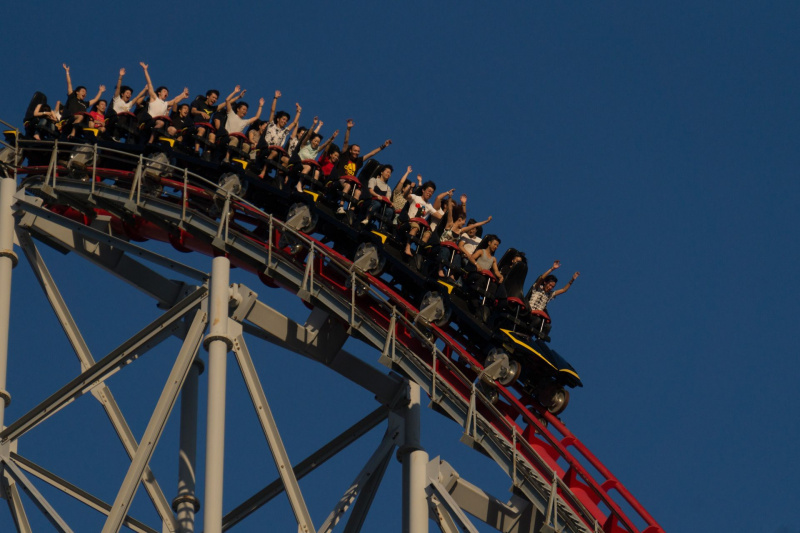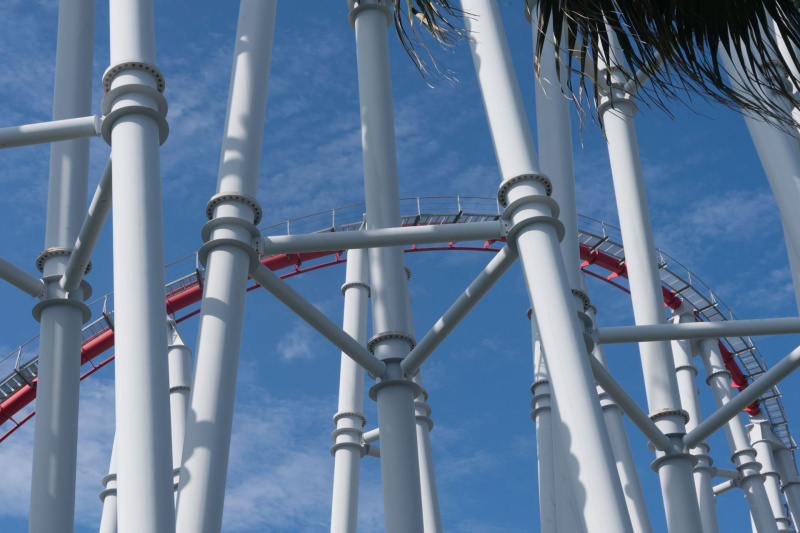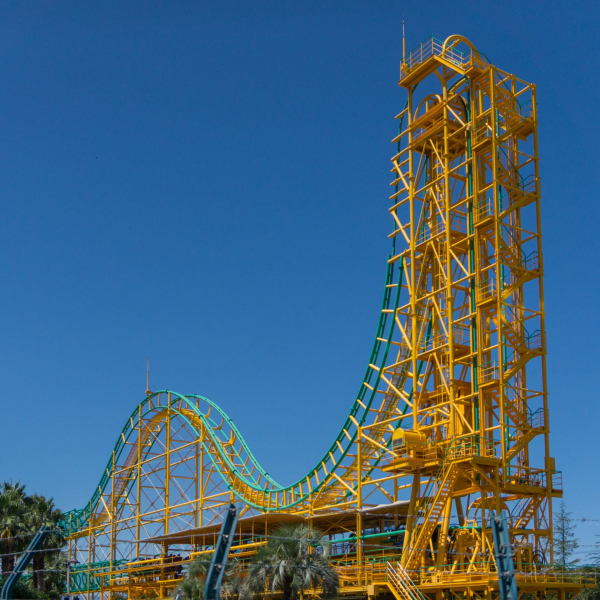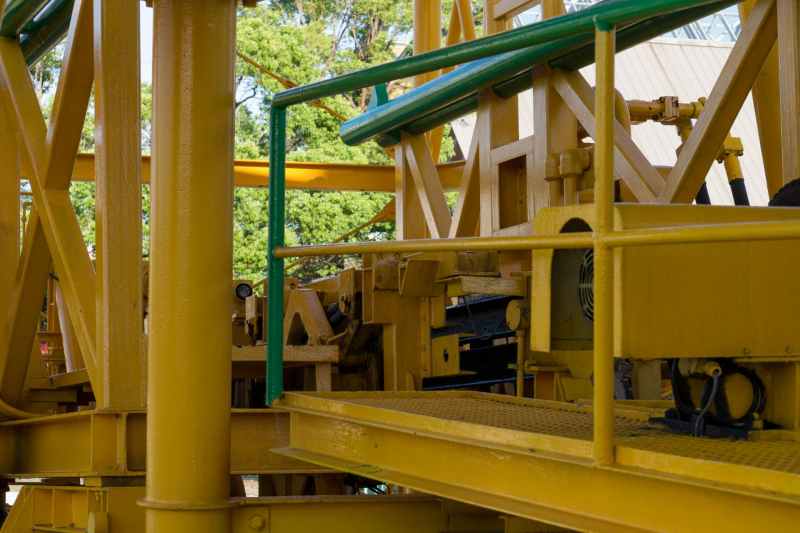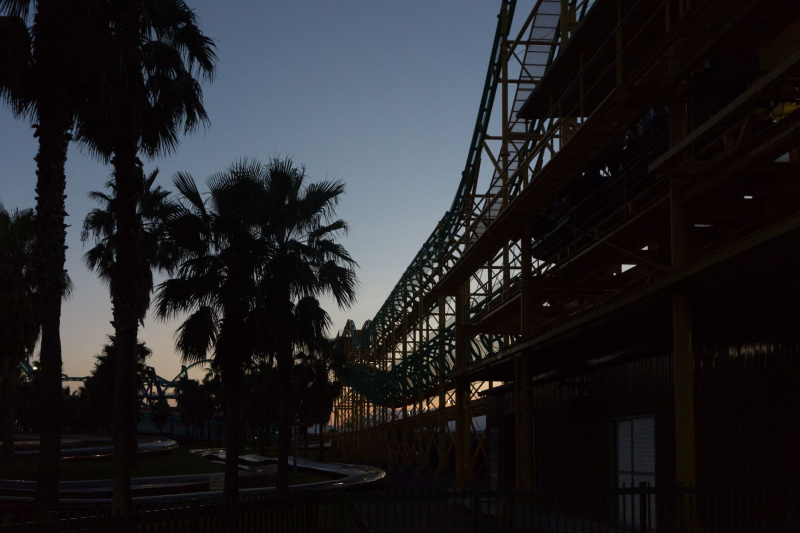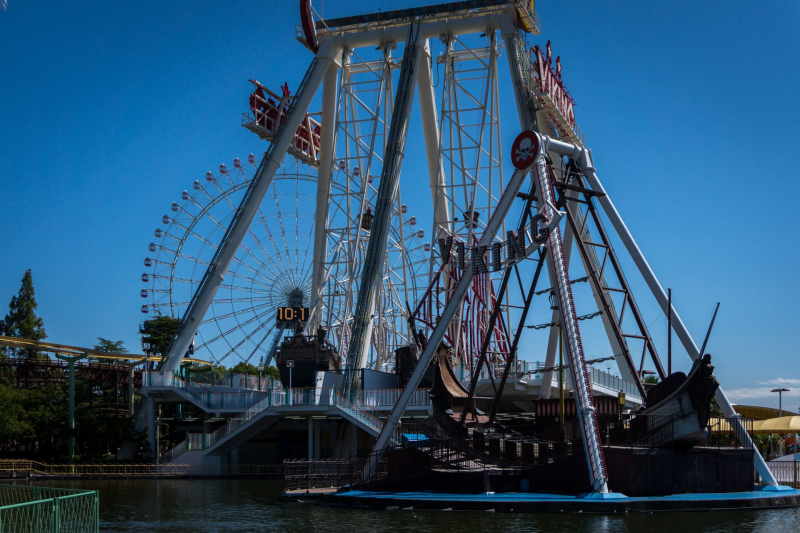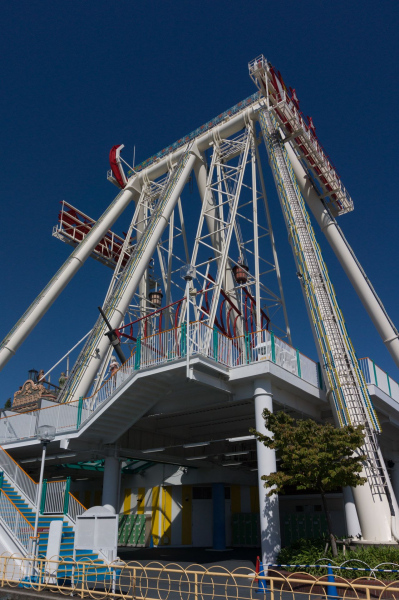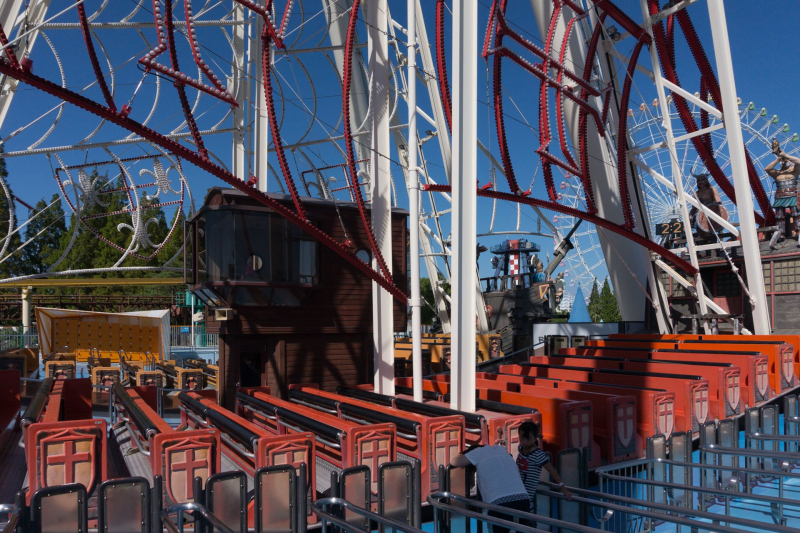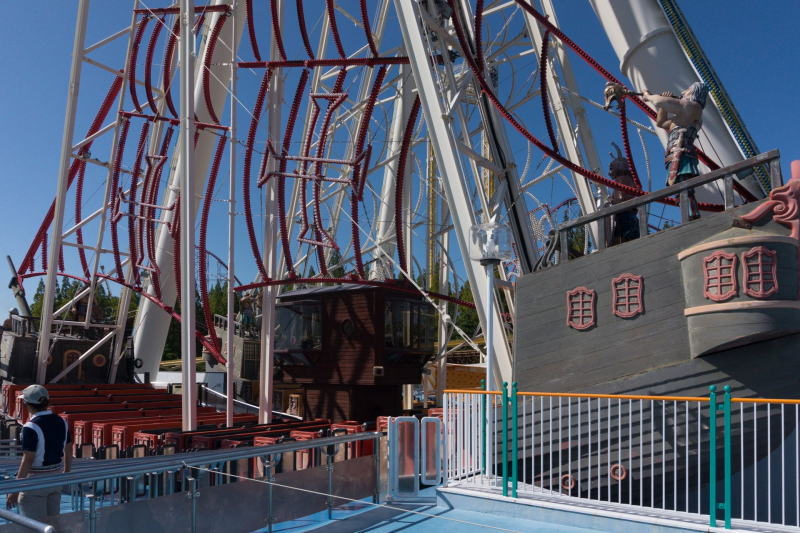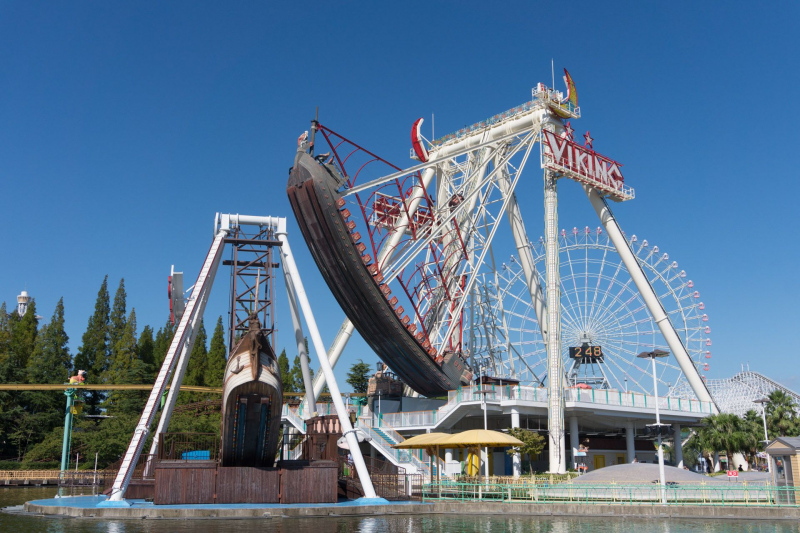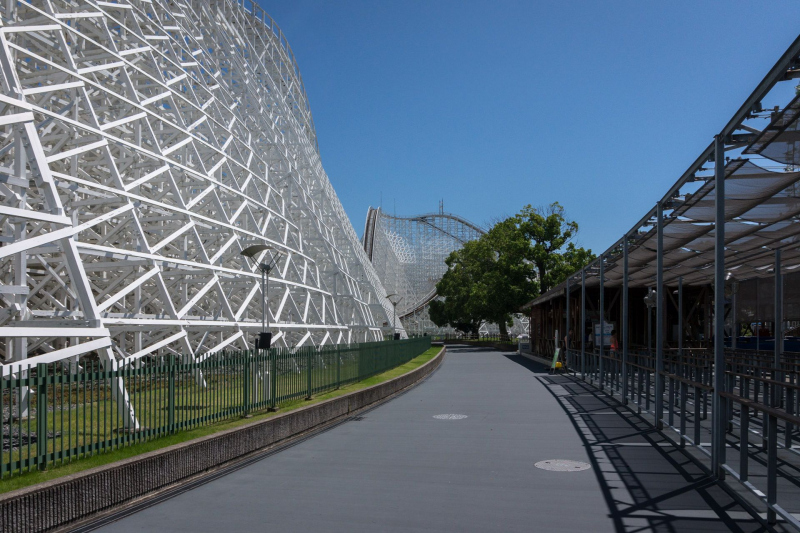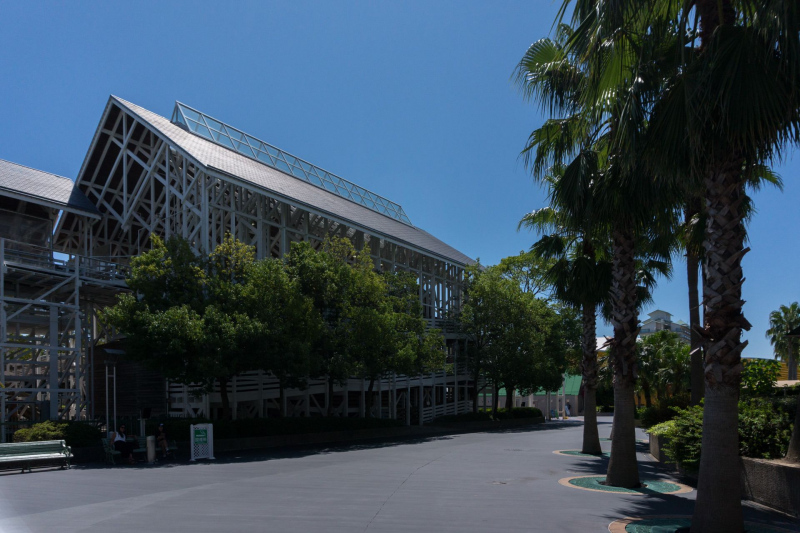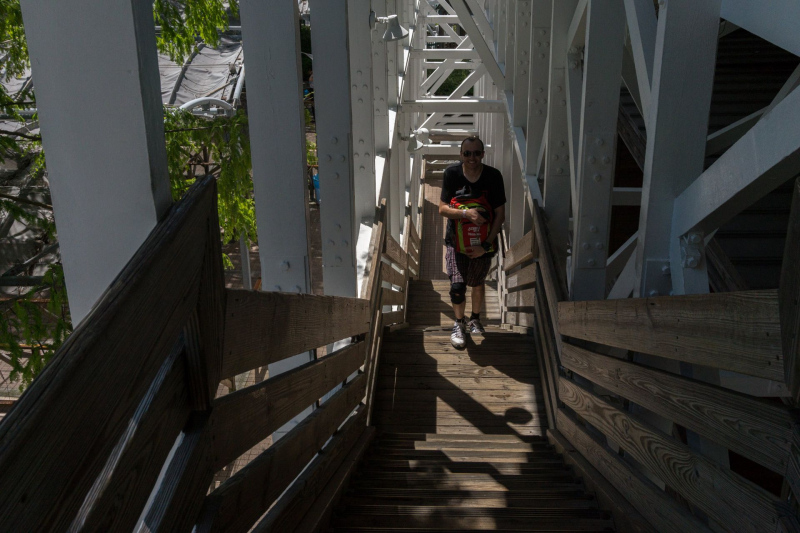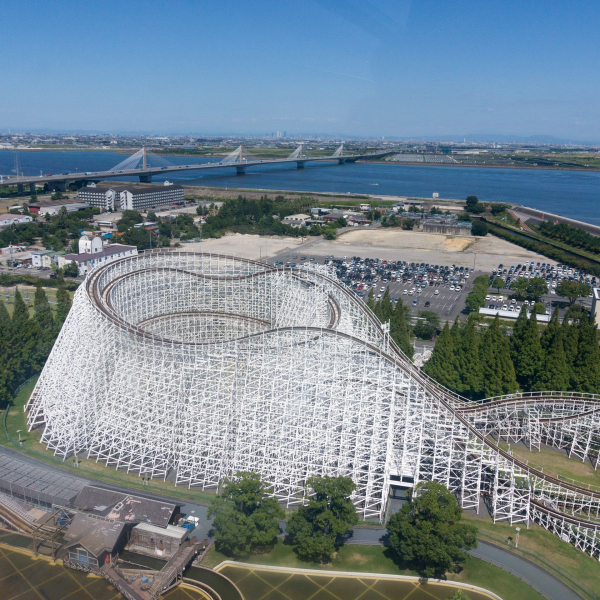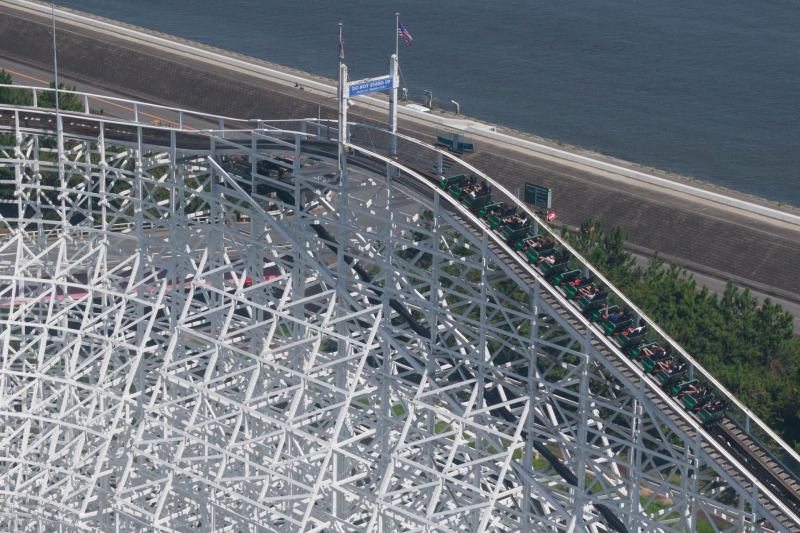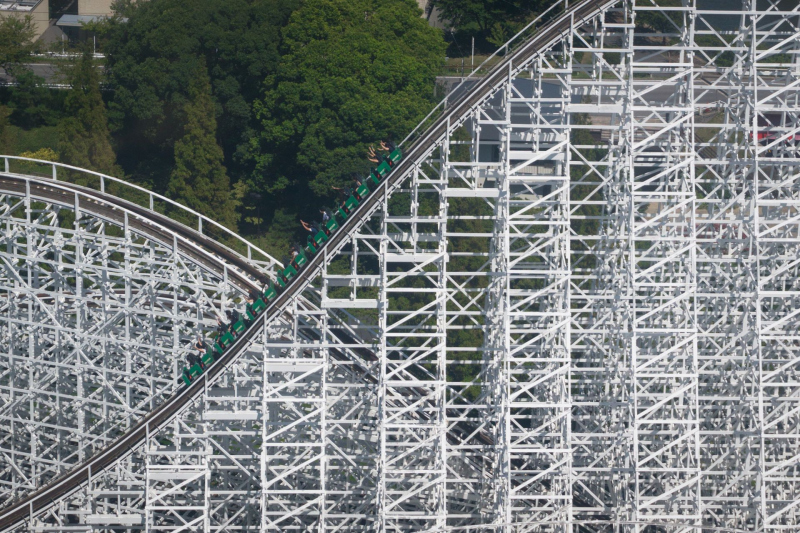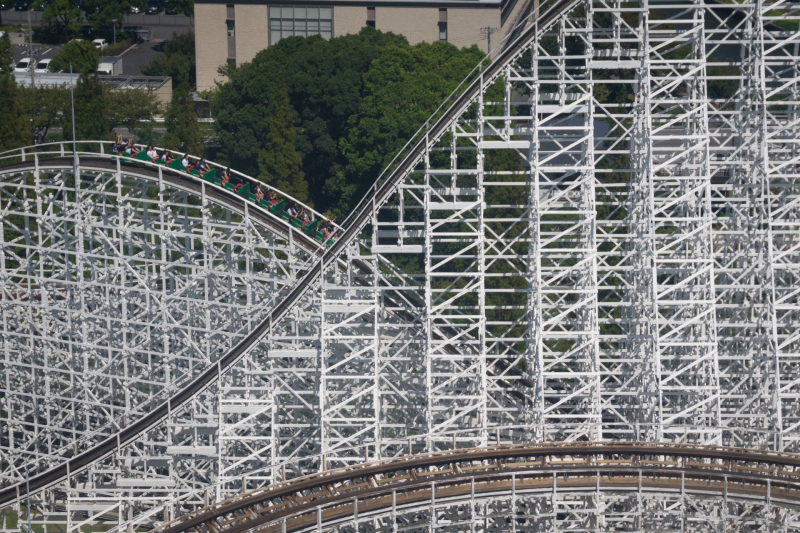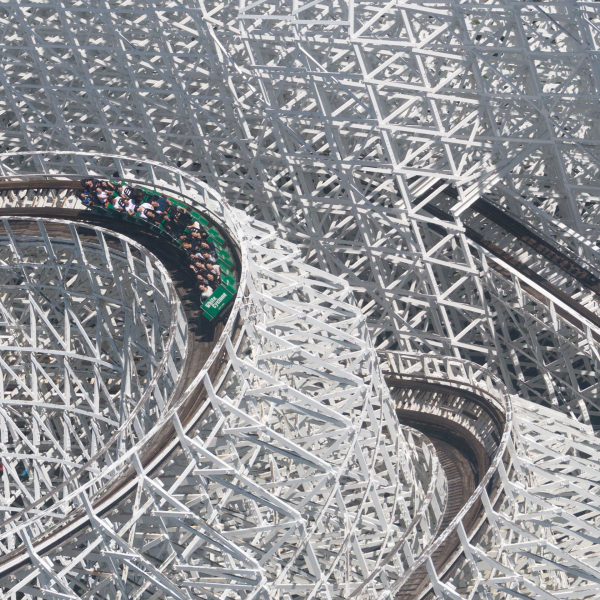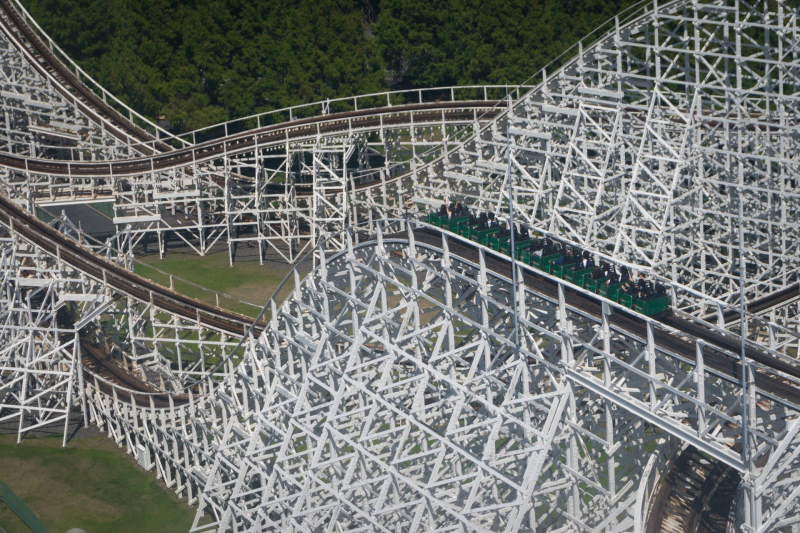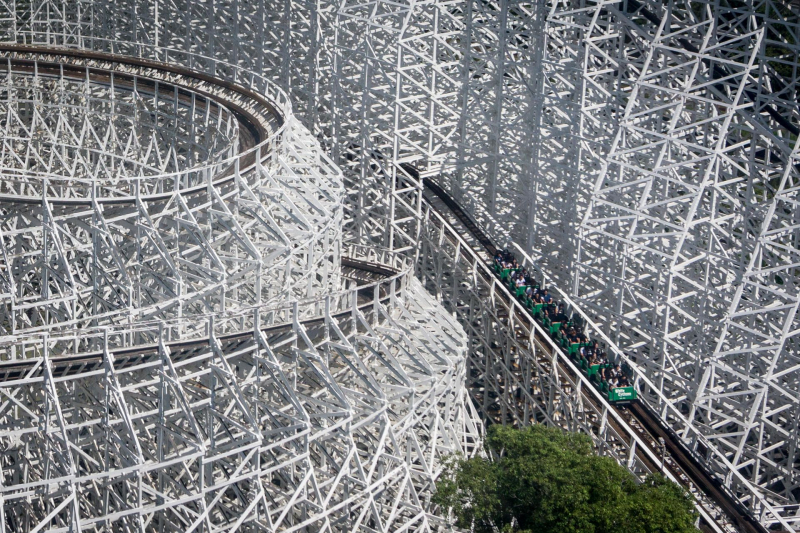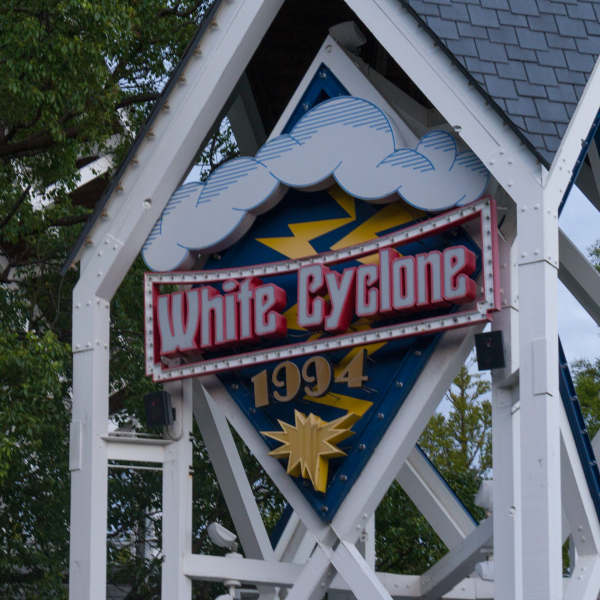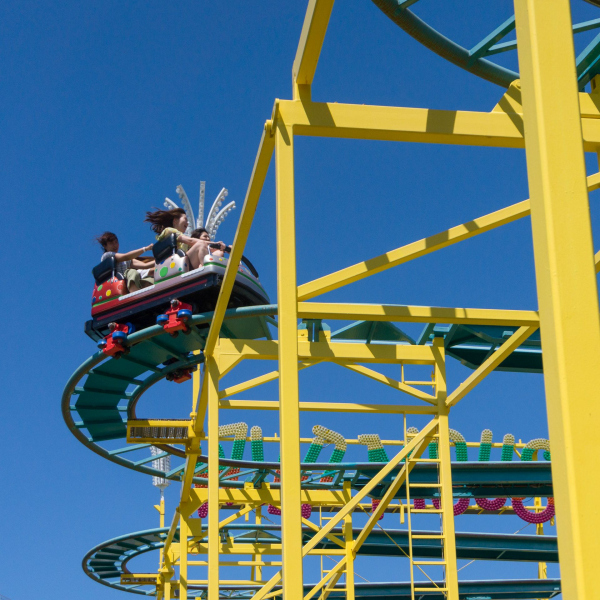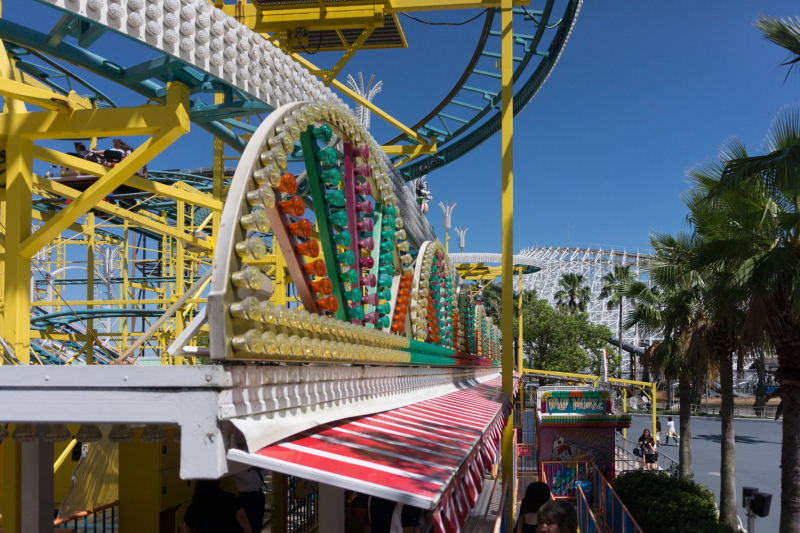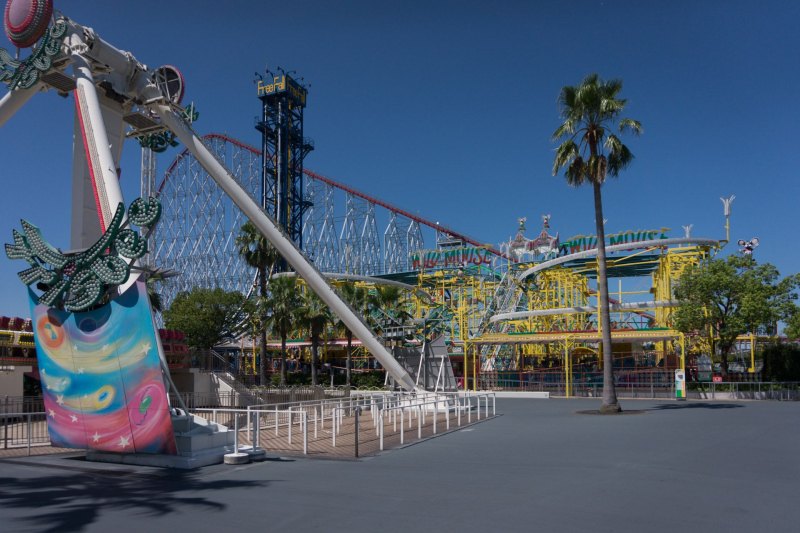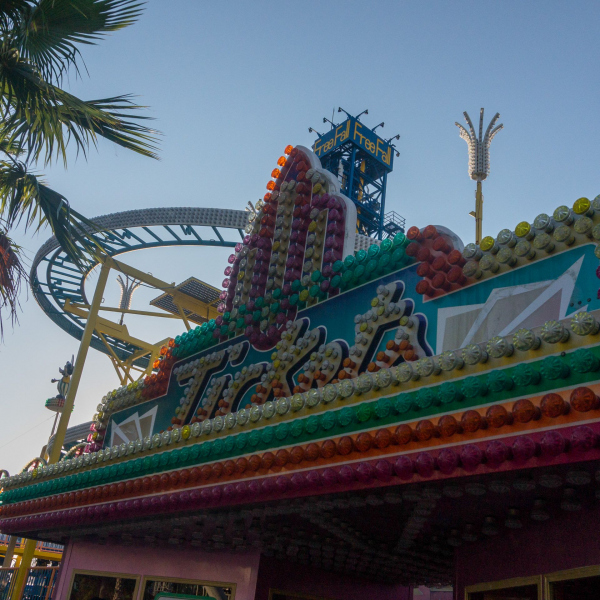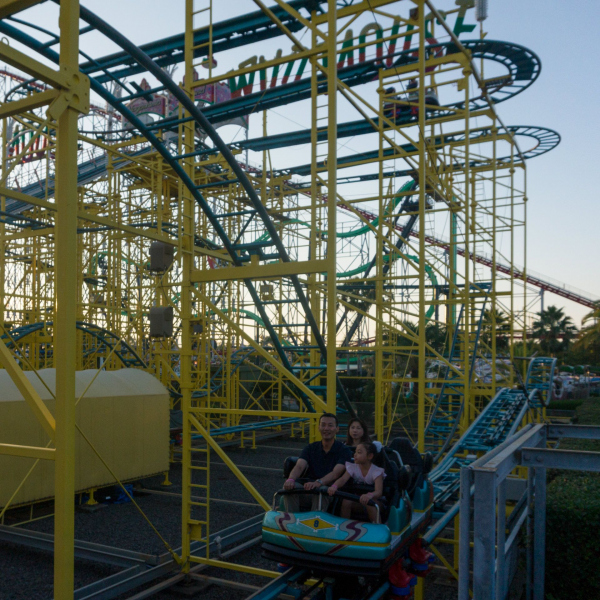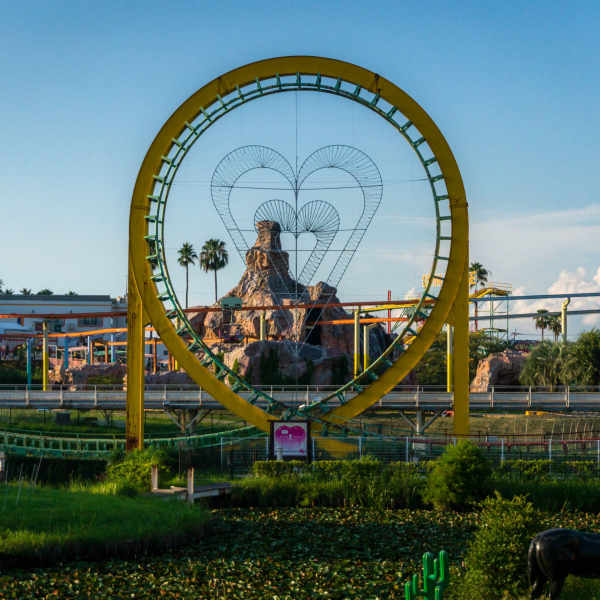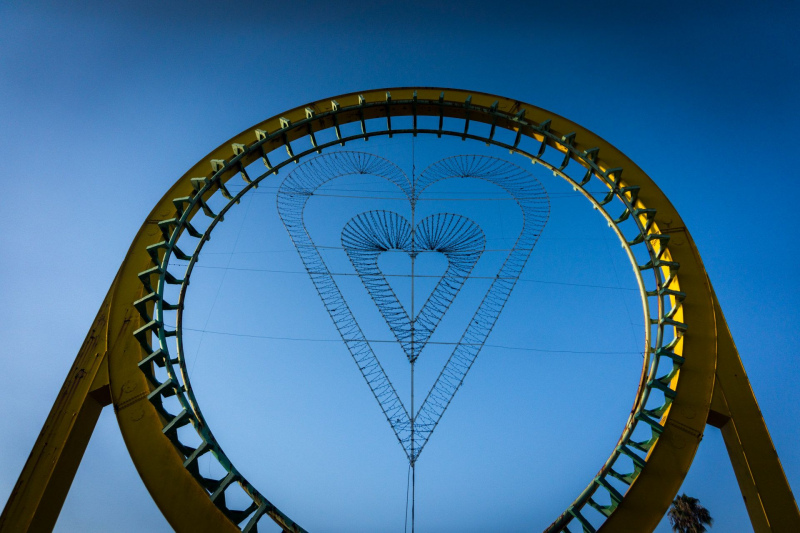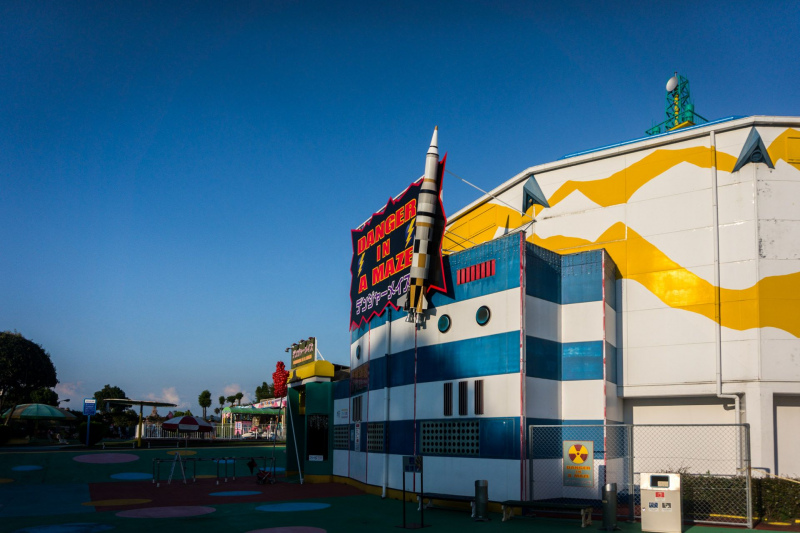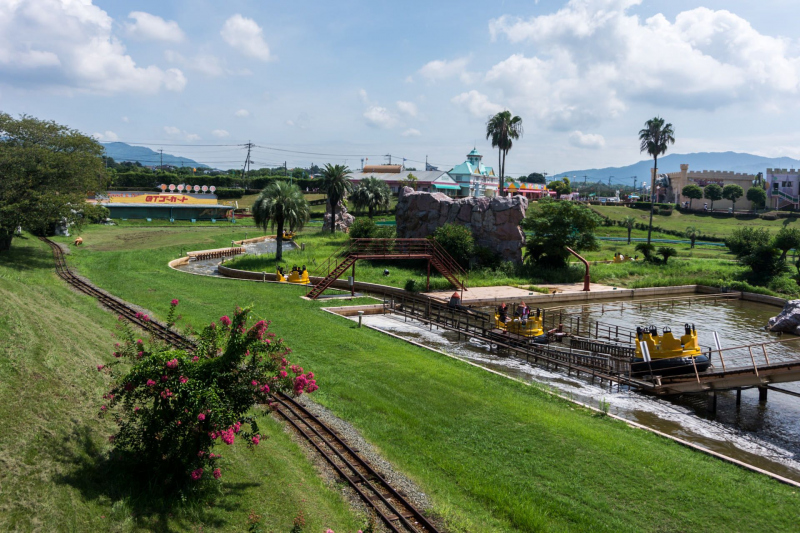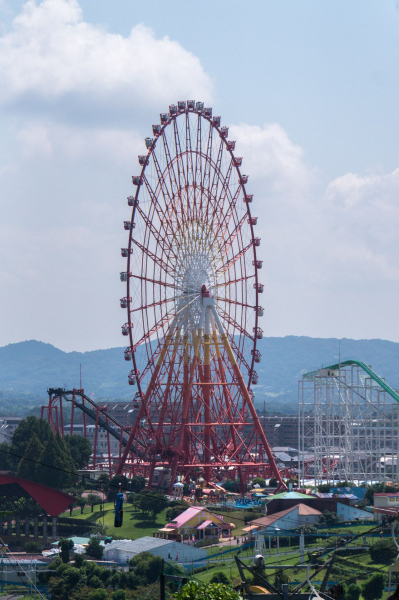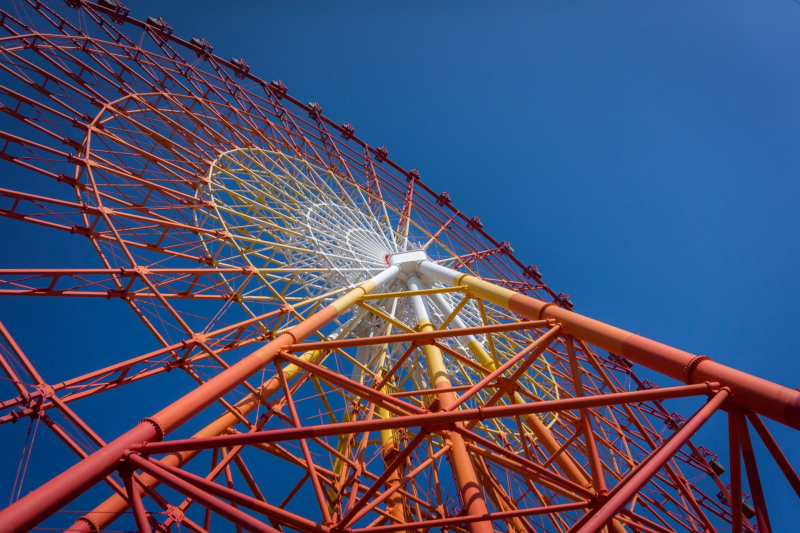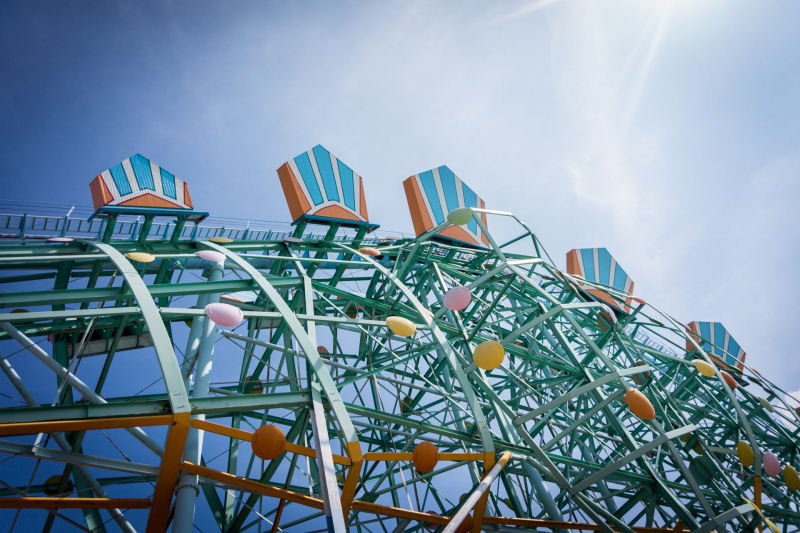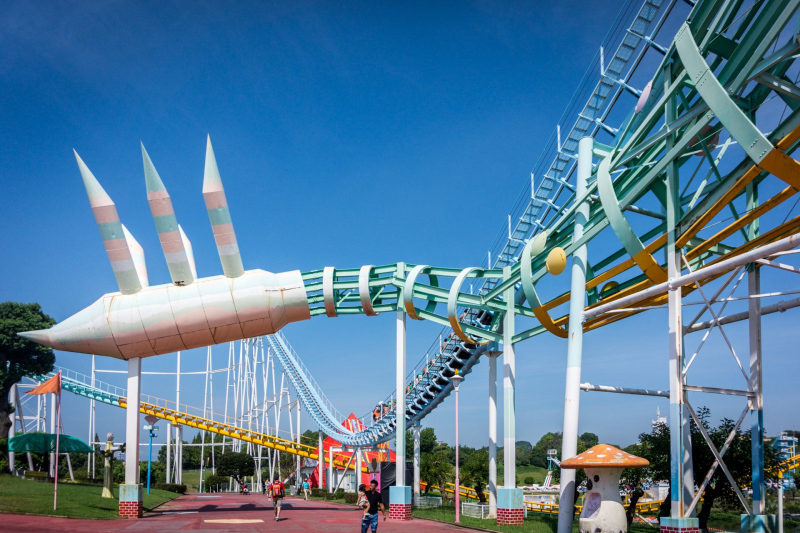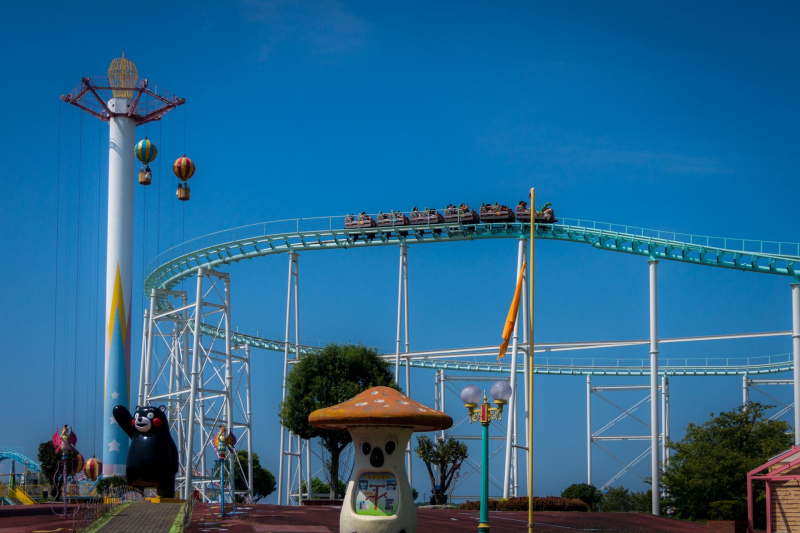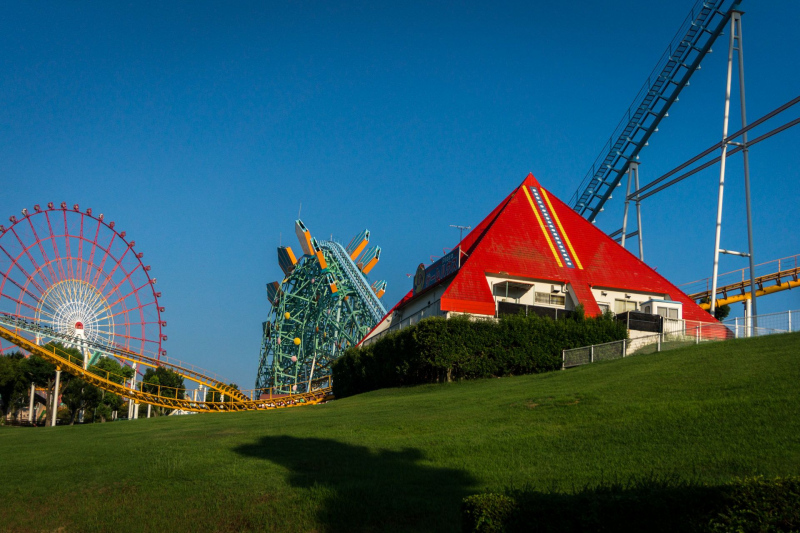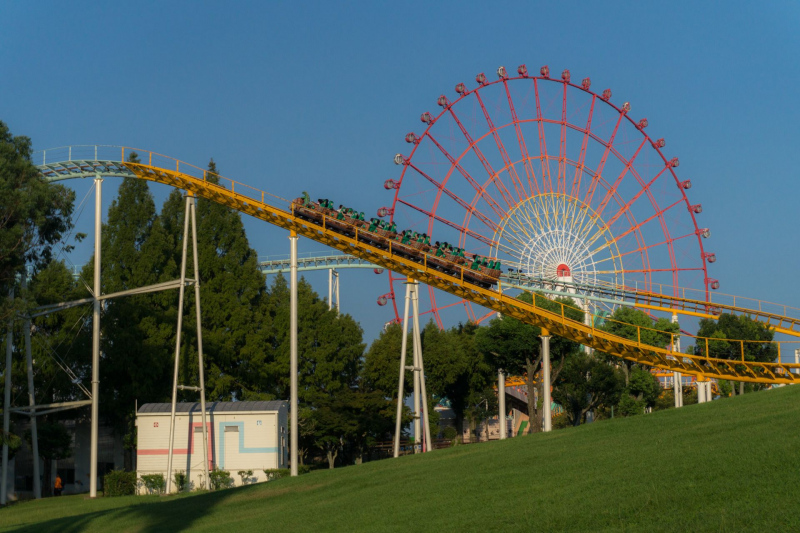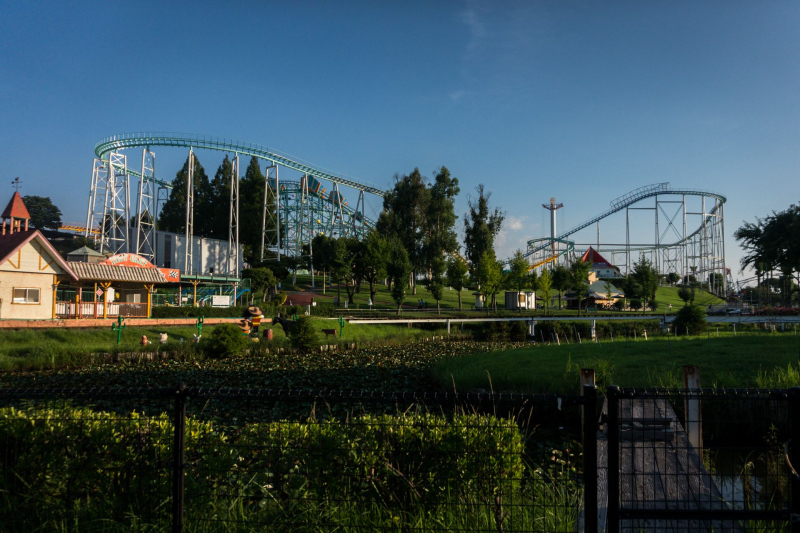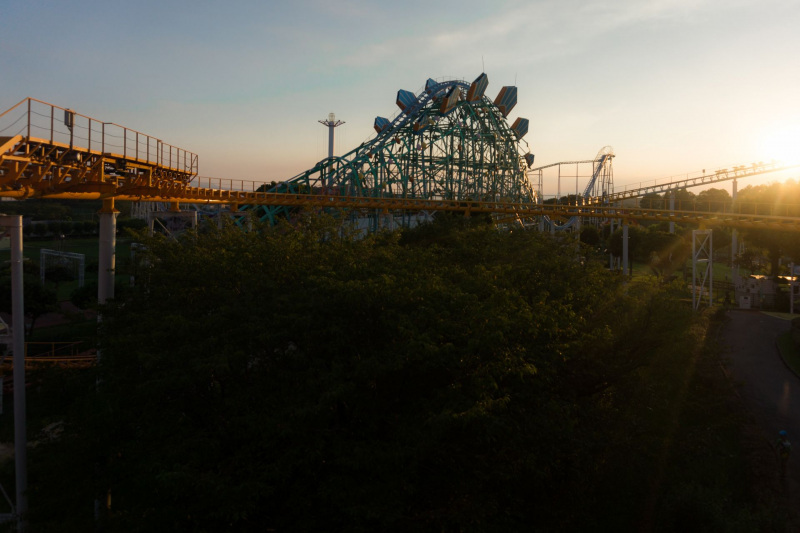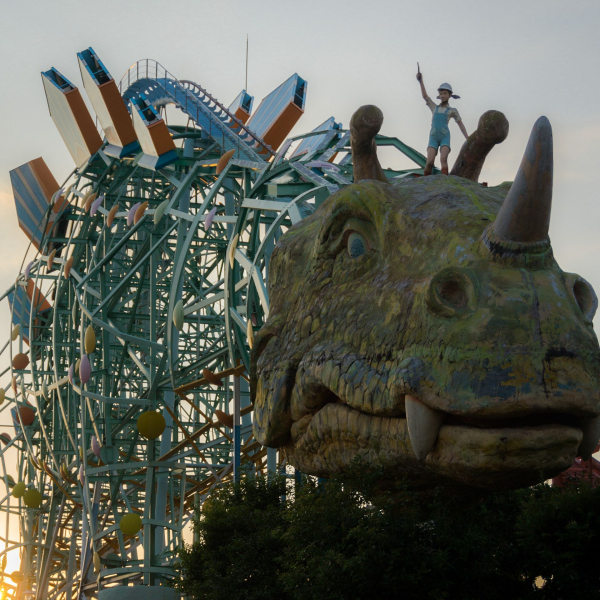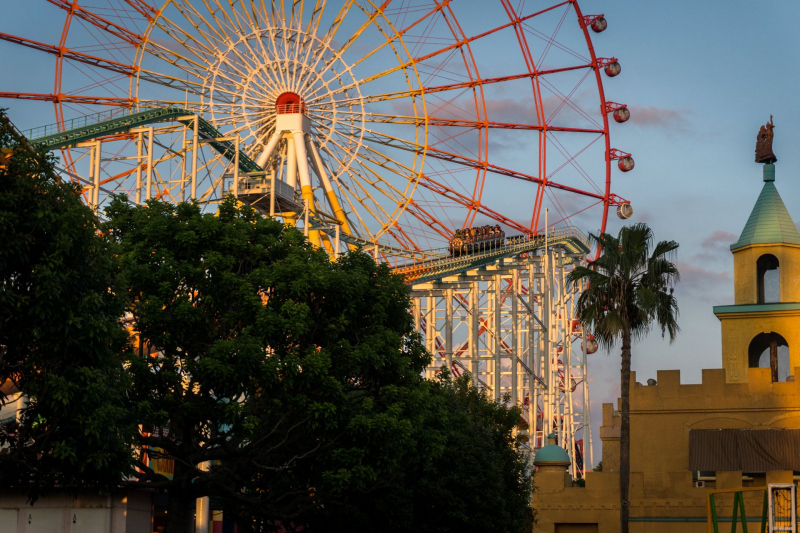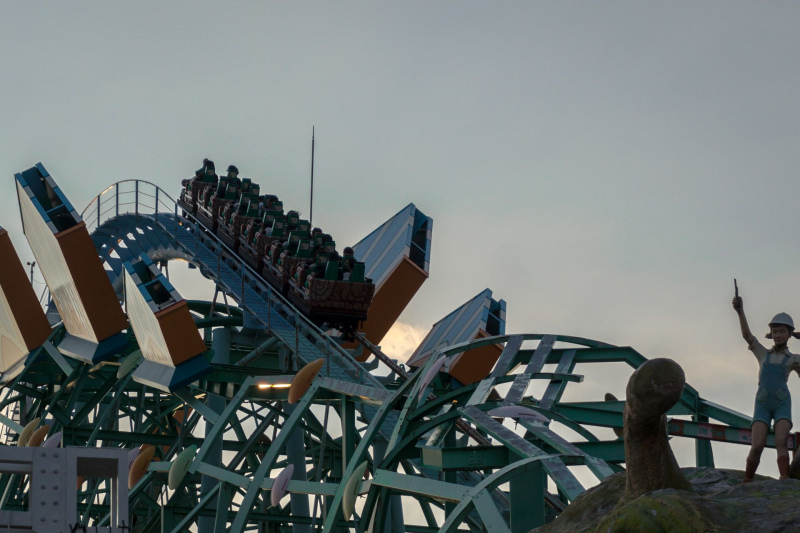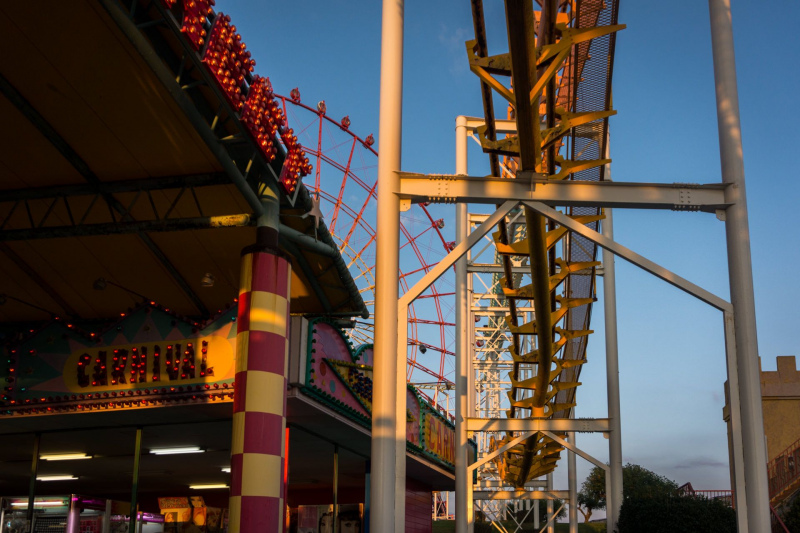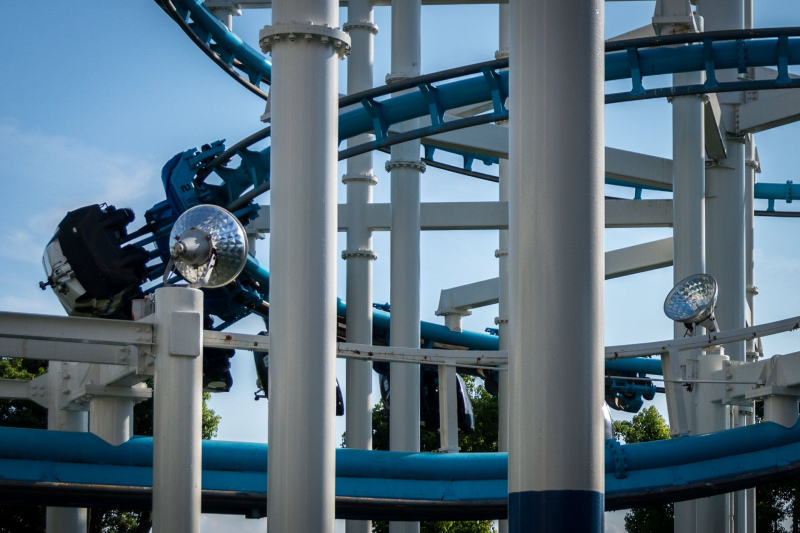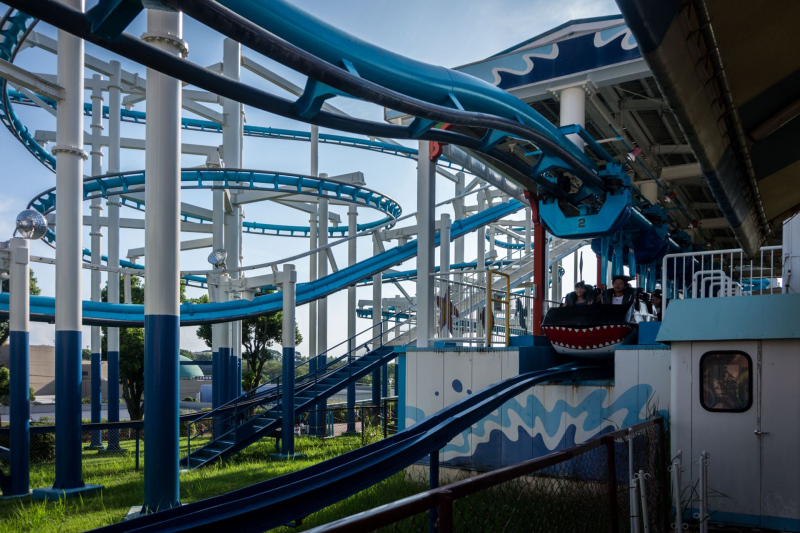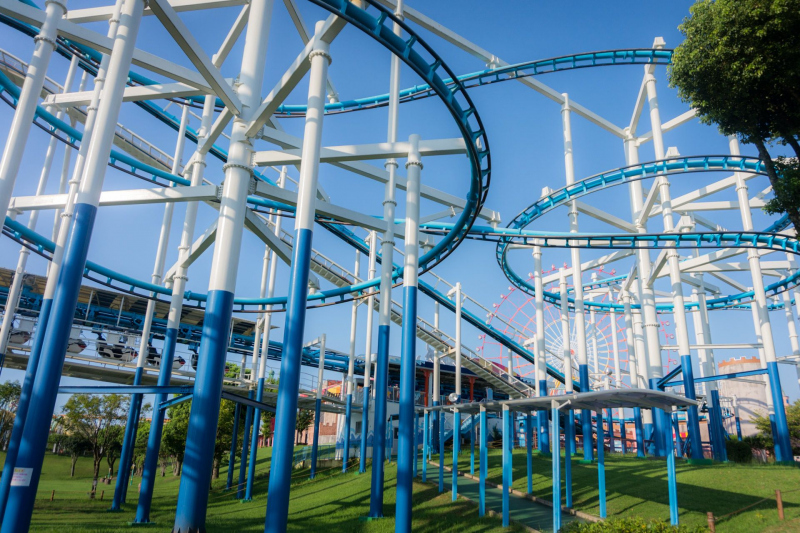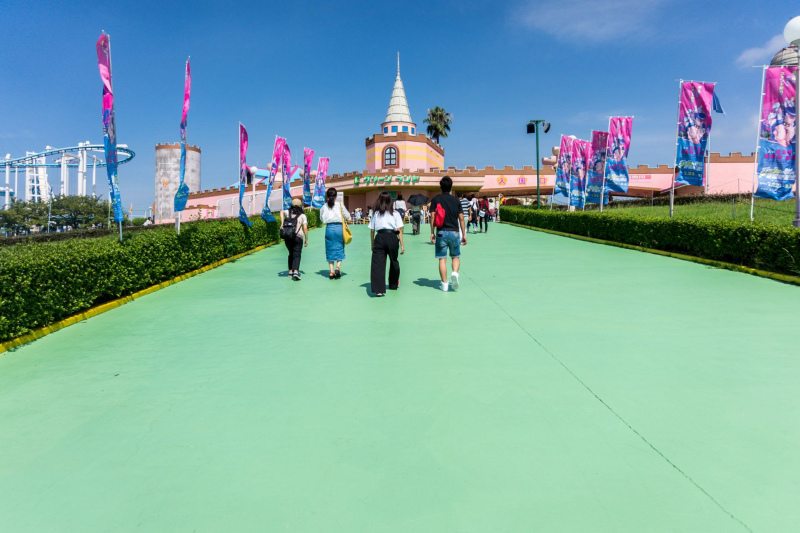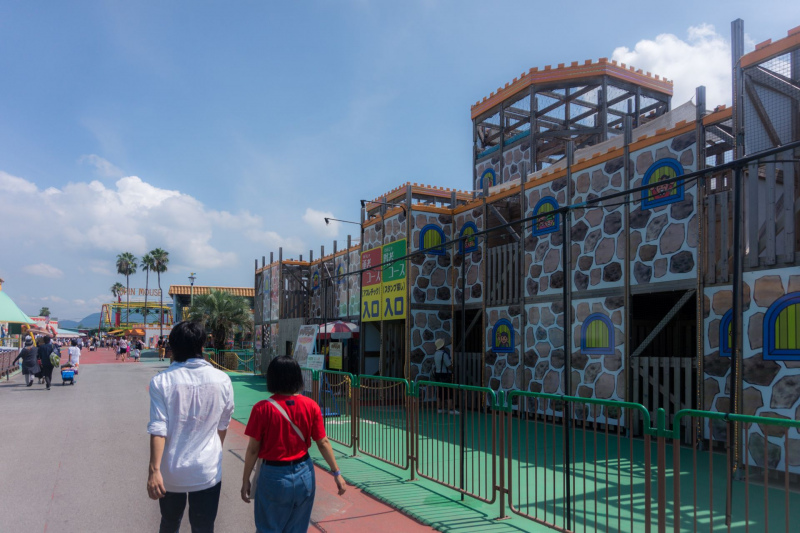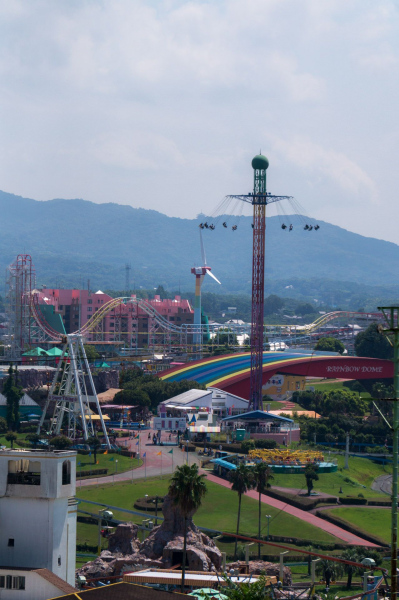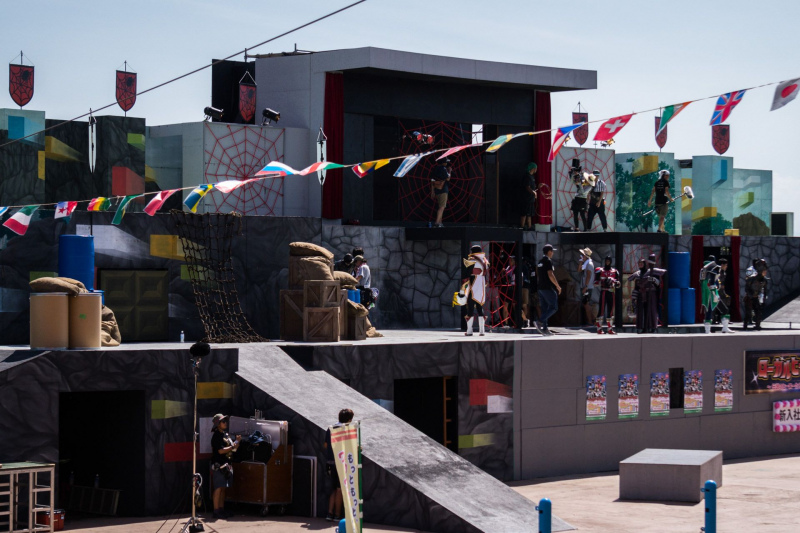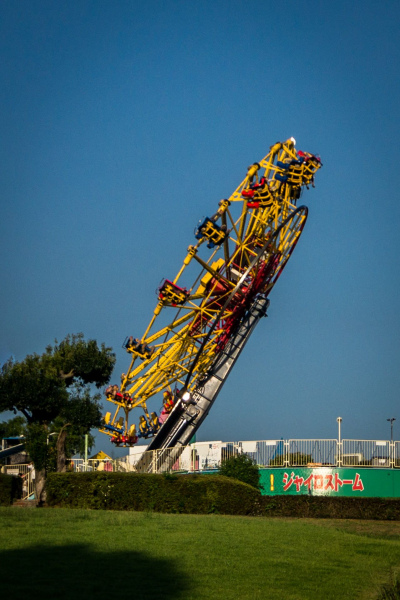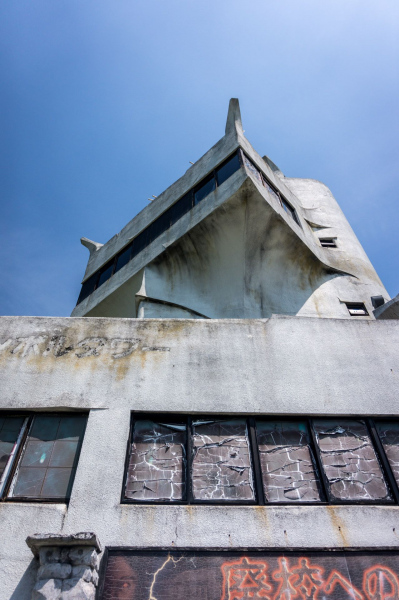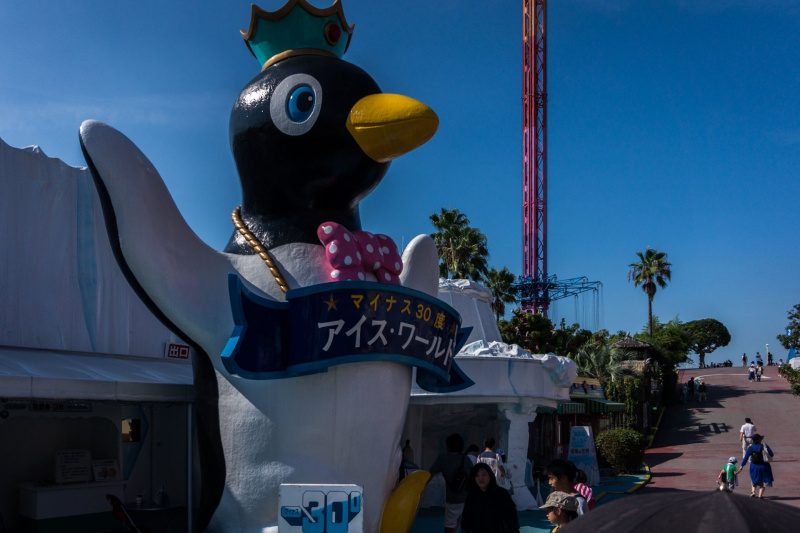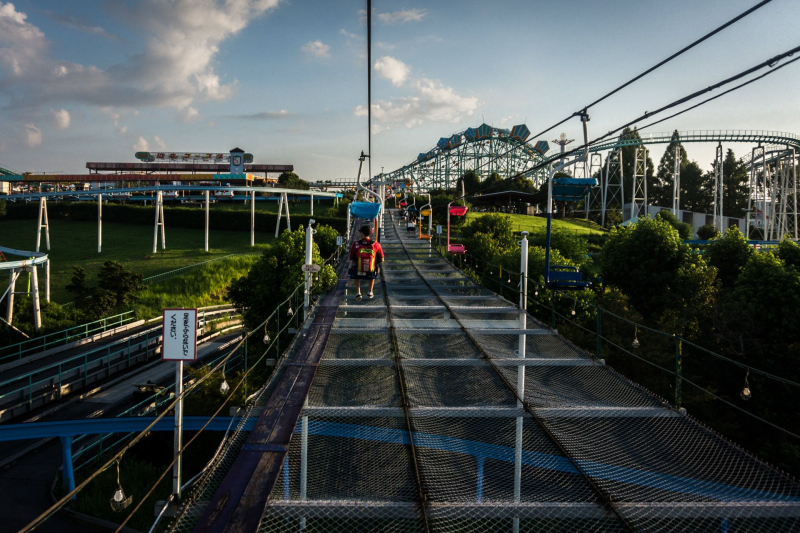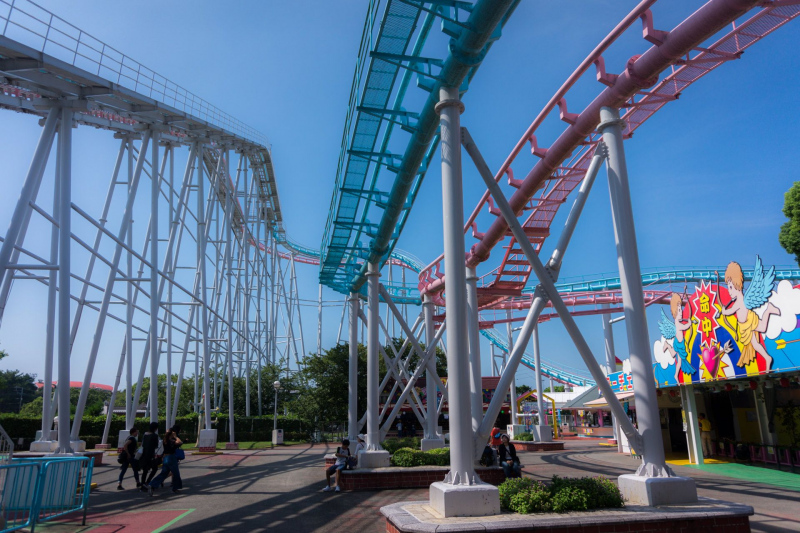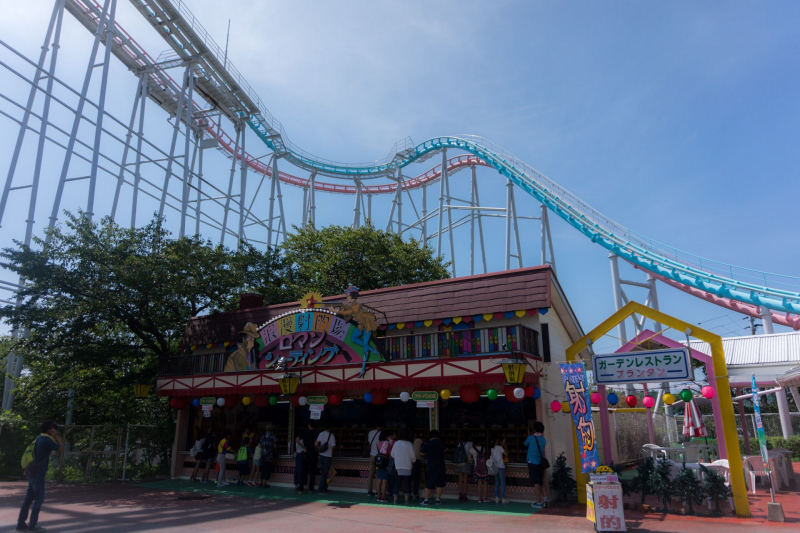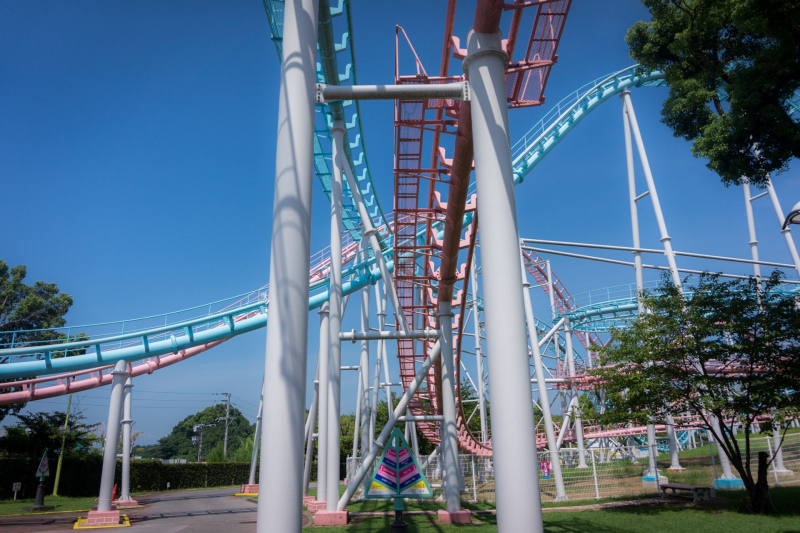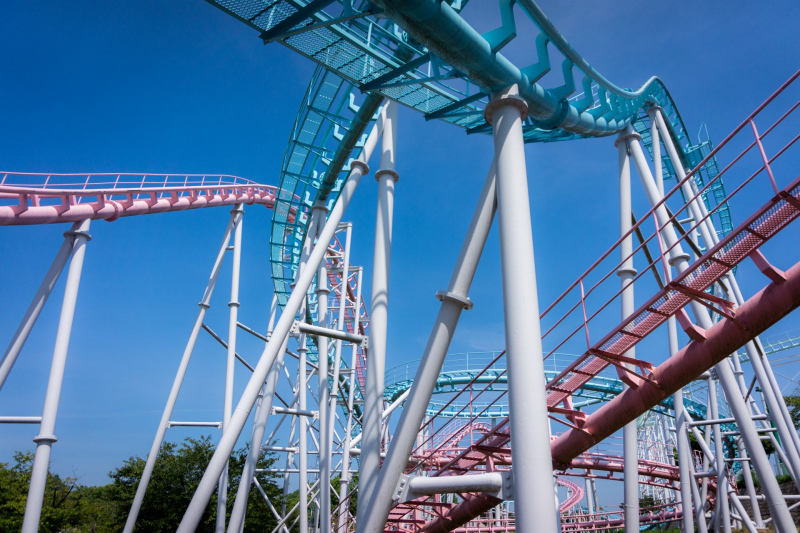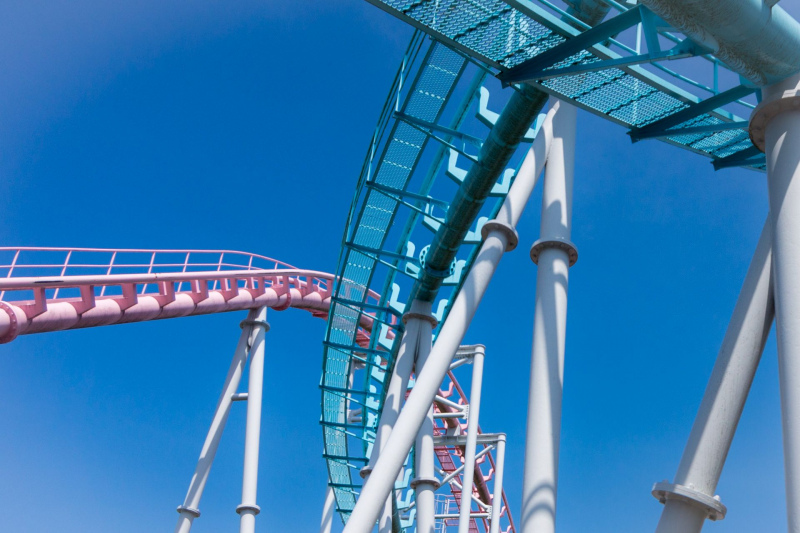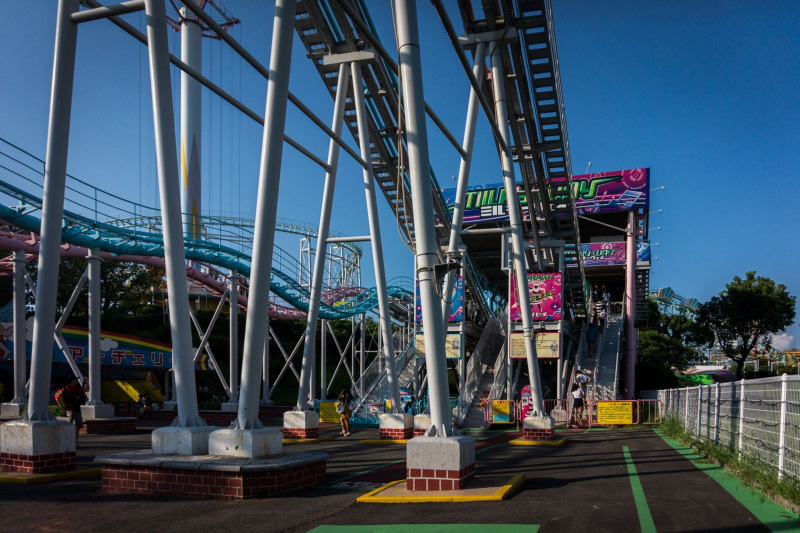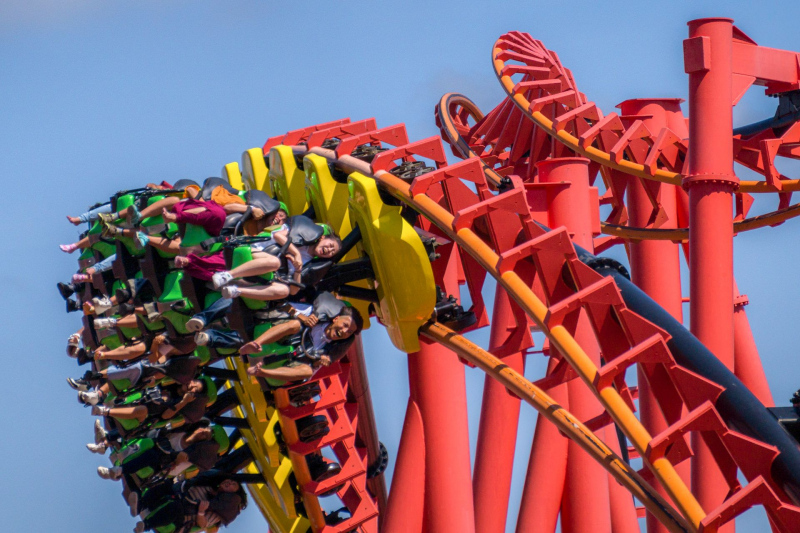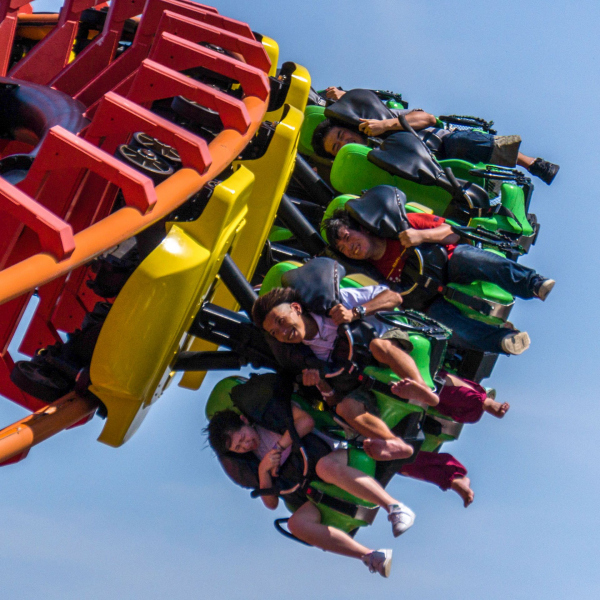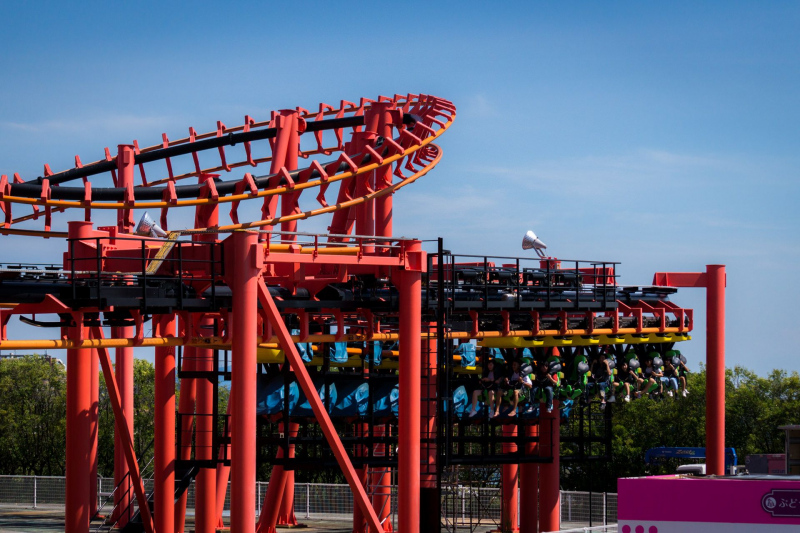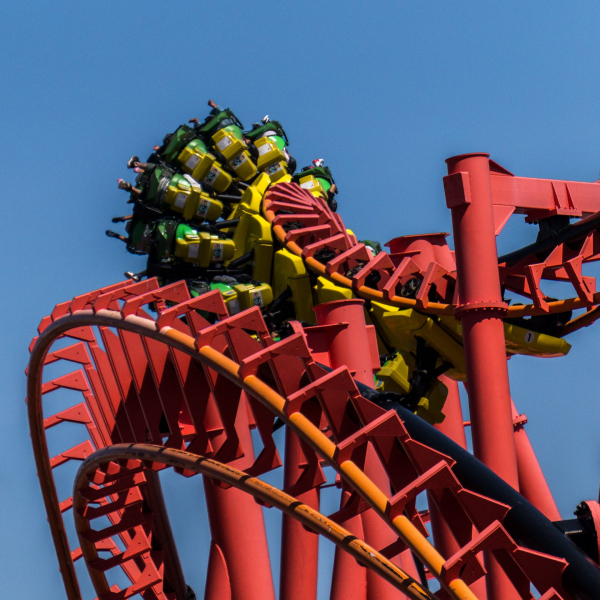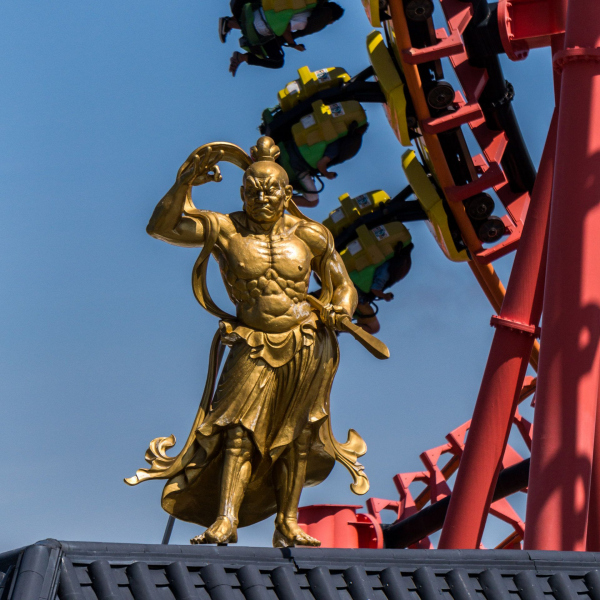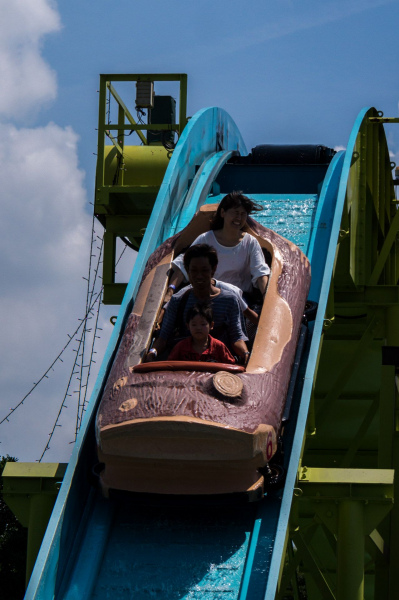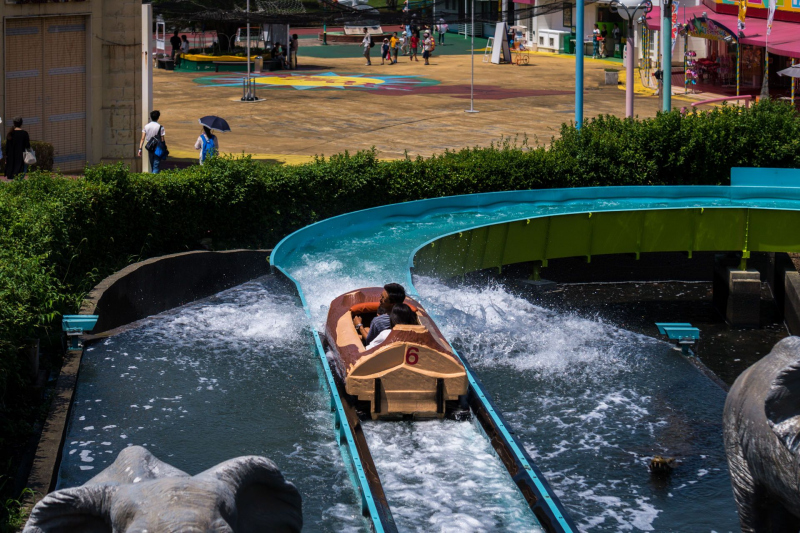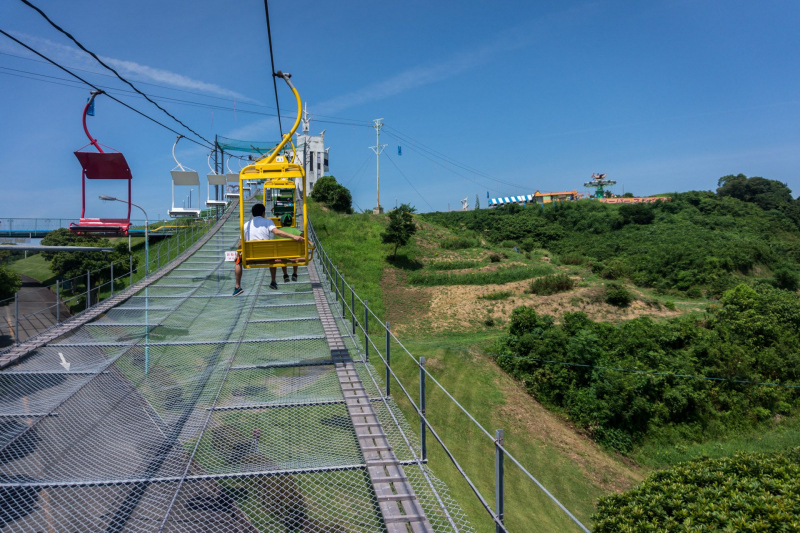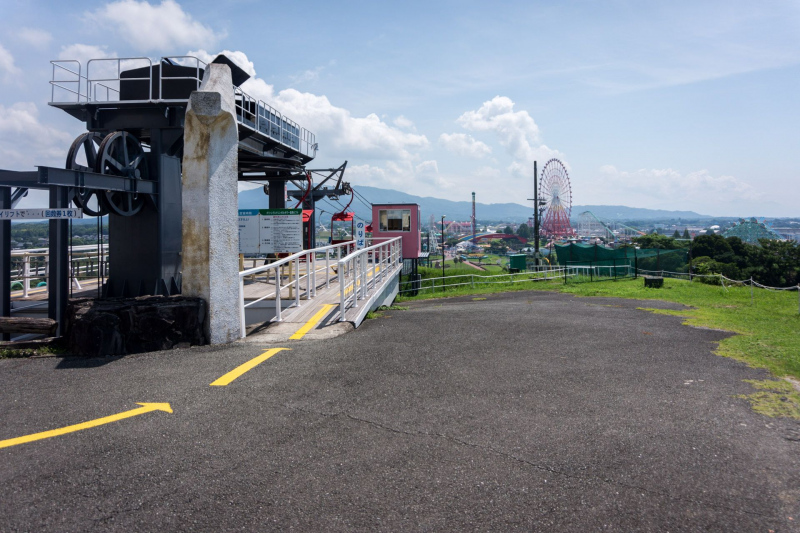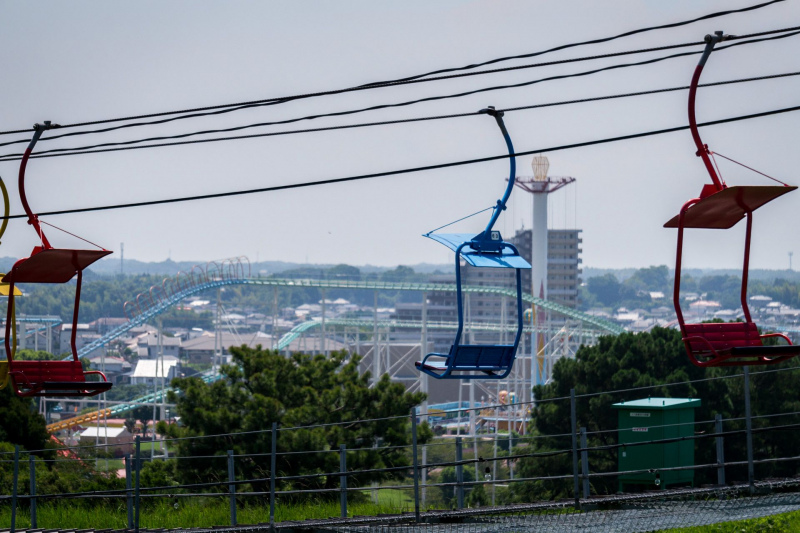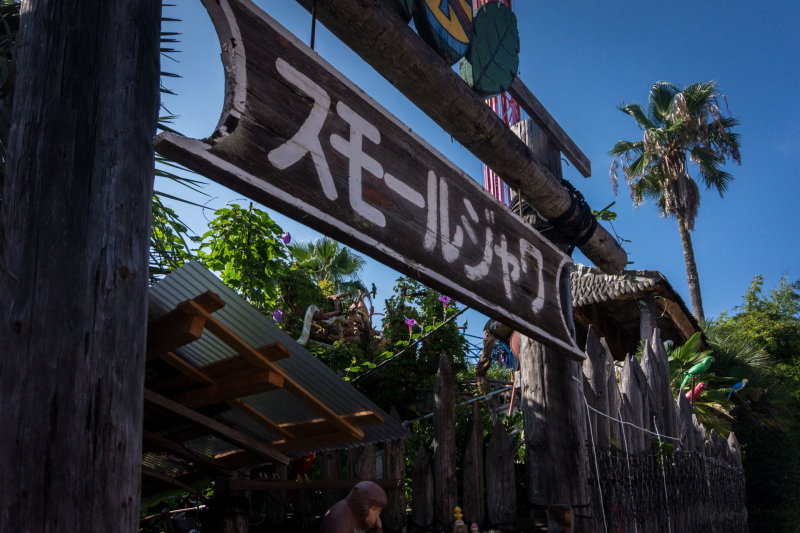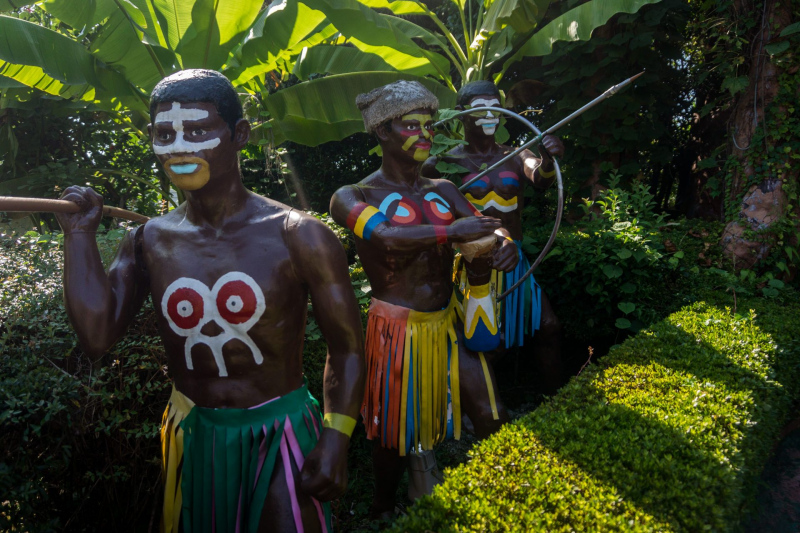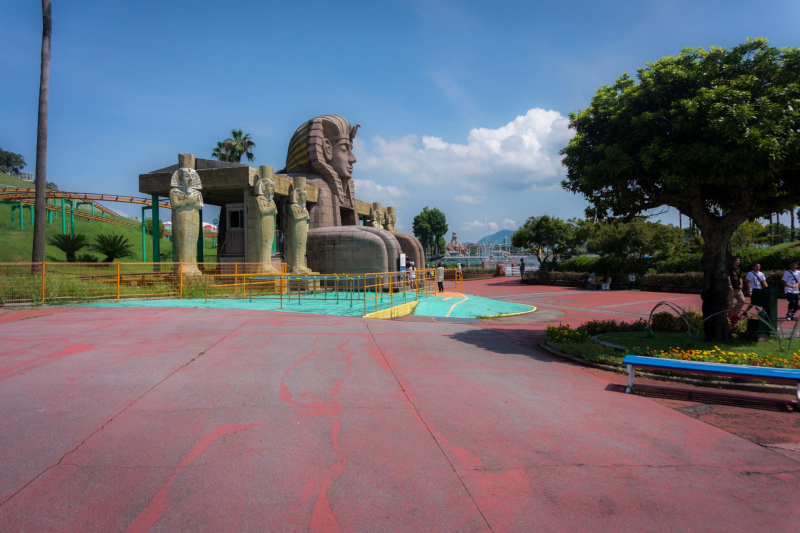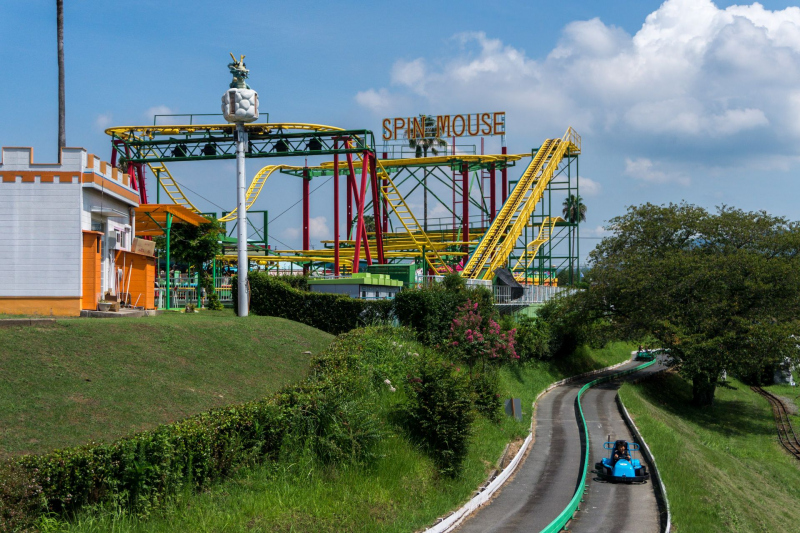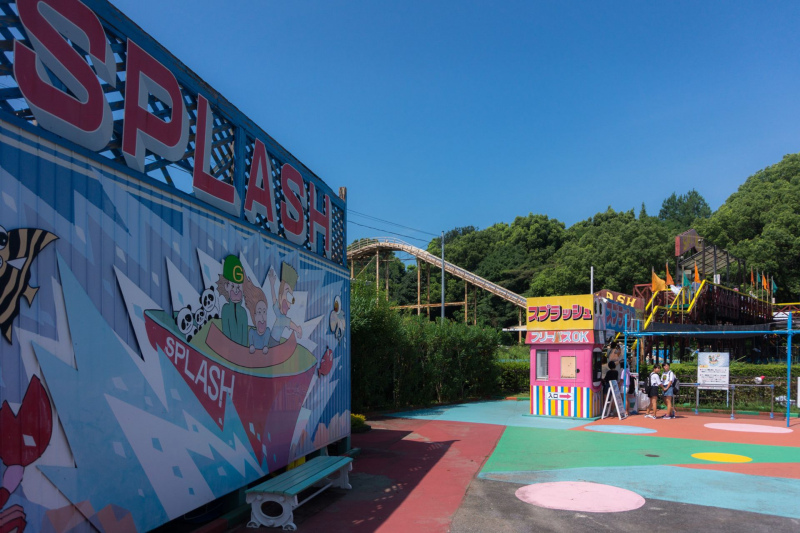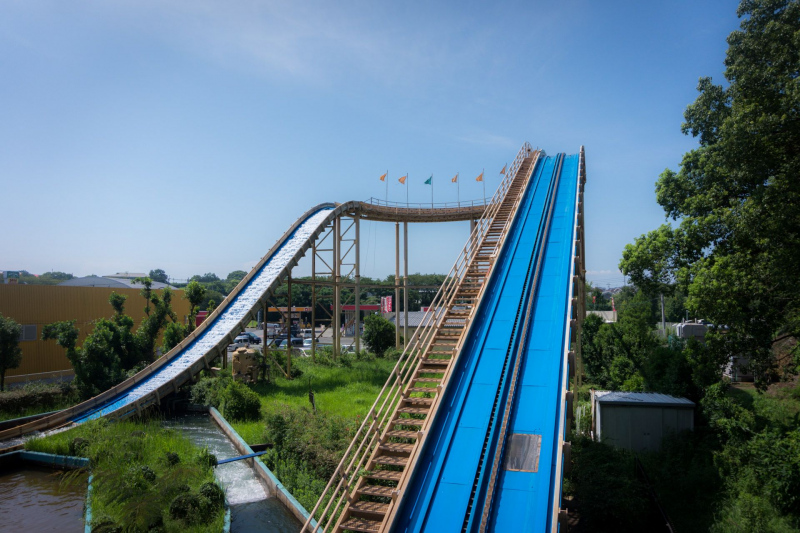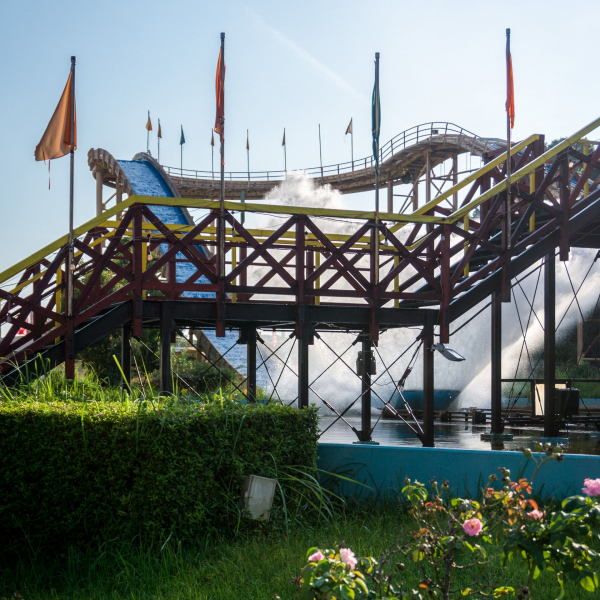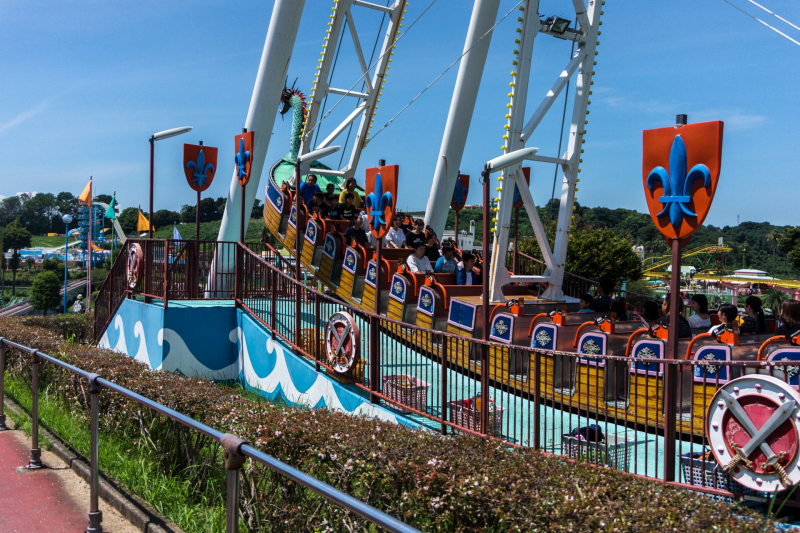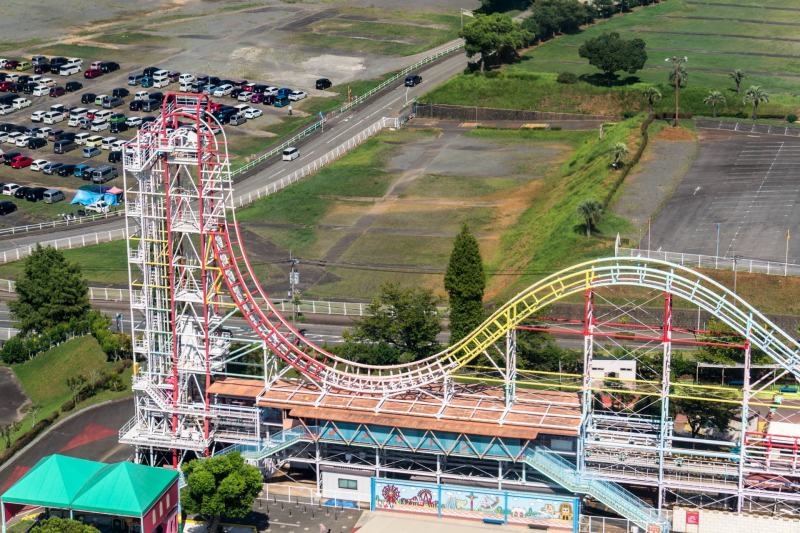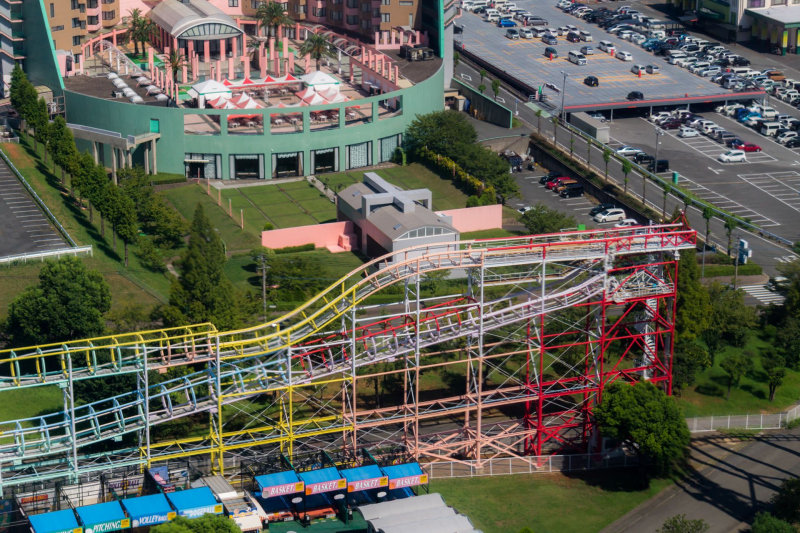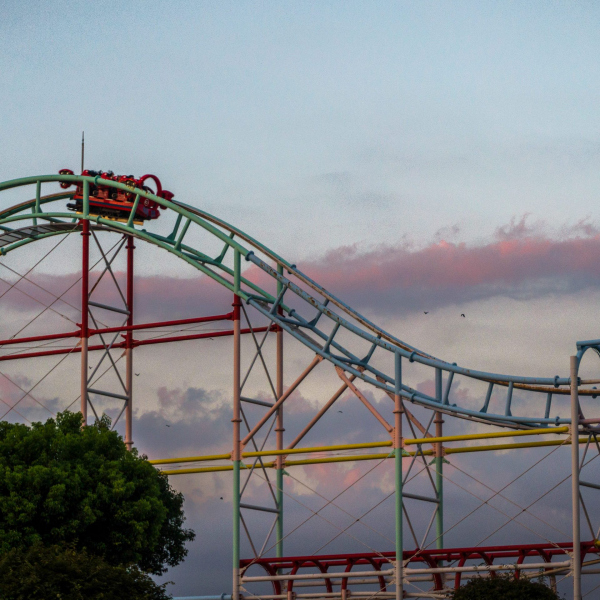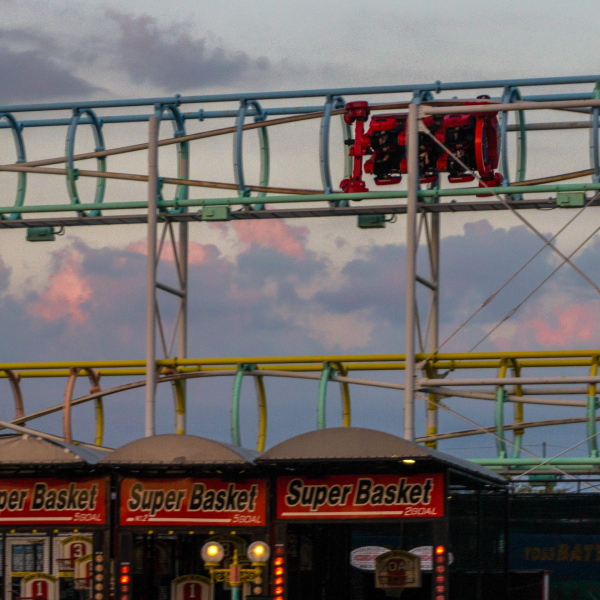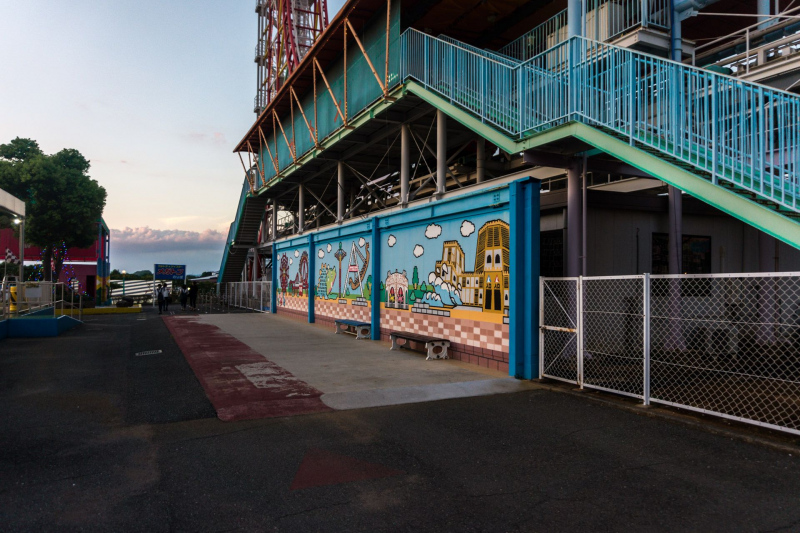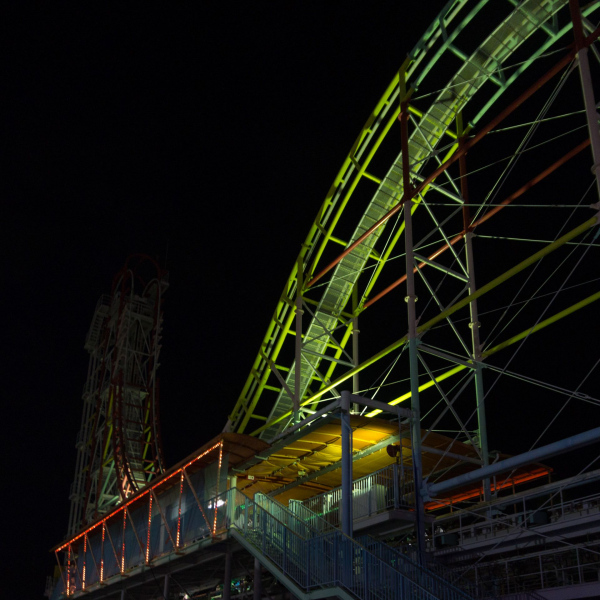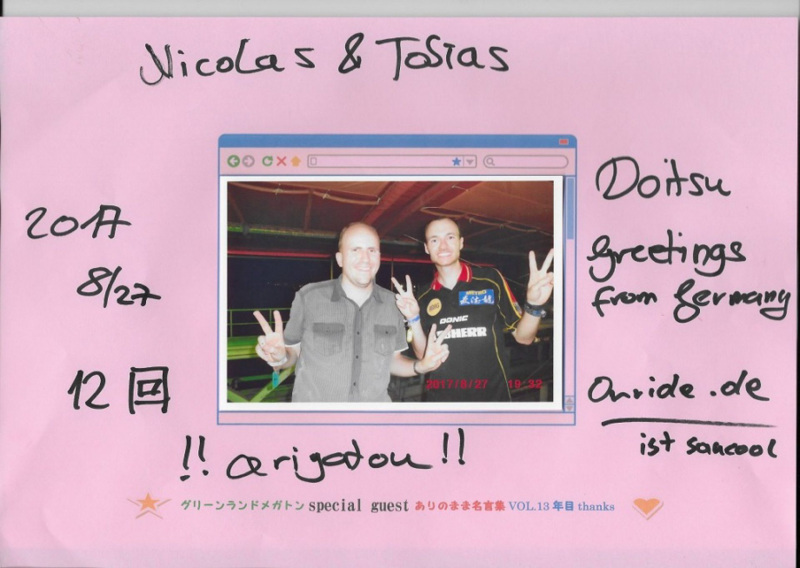Preface
“Will you come and visit me in England? There’d be some great CCI wood in Wales.” – “Hmmm…” We’re talking about the Oakwood Theme Park that was hit as a late sequel to this chat.
Since a long weekend is always a bit difficult to combine with my work, it was of course very convenient for both of us that the Oakwood Theme Park had a few more open weekdays on Halloween in addition to the usual weekend openings in October. Add to that some unusual flight connections and an absolute hotel bargain, and the mini-trip deep into the Welsh pampas had already taken shape.
Pretty much on time I landed in Bristol, where I was through the passport control in no time and was able to pick up my travel bag. Tobias came through the airport entrance door at exactly the same time as I did through the locks on arrival – timing! Only a few minutes later and accordingly only poorer by the minimum parking fee, we already romped through the left-hand traffic again, which I could tolerate this time in a much more unexciting way. After first errands and a tank of gas at Tesco Extra we drove through Bristol on a route that was, ahem, not exactly low on roundabouts, until we finally passed the long and quite Tampa Bay-like bridge over the Severn Estuary to Wales. Shortly after the toll station we found our Hampton Inn, where after a tasty meal at Sawyer’s Bar & Grill across the road we just ploped into the comfortable beds.
The next day, after a fantastic breakfast at the hotel’s own buffet with English and continental concessions, we soon tackled the remaining 110 miles to Canaston Bridge. Sounds like a phrase in this sentence now, but let me assure you once again: it goes on and on and on. The park is not only located at the proverbial ass end of the world, but rather at the tip of a hair on a pimple at the same place. On the way, one crosses the most beautiful landscapes, but one has to be a very dogged CCI-pilgrim to make it worthwhile. The park is almost cut off from public transport – also according to its own statement on its website. The running gag, that not even a certain Ingo Wahlen should be able to find his way here without a two-hour hike, we are happy to release at this point as an impulse for a Stinson-like “Challenge accepted!”. A nice detail: the closer you get to the park on the unusually well developed country roads, the higher the probability that the brown signs will again bear the original name Oakwoood Leisure and not Theme Park.
But at some point – you can hardly believe it – after passing the probably hottest roundabout decoration for the coaster addicts, the parking lot of our destination today is reached! At the entrance I got out my online ticket, which I bought and printed out at home in Switzerland for £20.25, Tobias and his English student card even managed to get in for only £18. God knows, you can’t complain about that!
Tour of Oakwood Theme Park
A small train takes the park guests who have just arrived from the ticket booths to the actual attraction area. As it only runs every quarter of an hour and we had just missed it, we walked the short distance on foot. En route, a fascinating side effect of the modest weather became apparent: you don’t see a more than 30 meter high Intamin Mega Splash every day so autumnally wrapped in fog. Due to equipment reasons and also because the ride would start at 14.00 o’clock, we postponed a ride with it for now.
Megafobia
Passing the exit station of the park train, we would have actually wanted to head for this year’s novelty, the Scotland Import Flight of the Giant Peach. But as the queue had already grown to a respectable size and it was only going very resinously, we took a run under the railings and walked to the main reason for the visit of our whale detour, which was already audible from far away, but not so visible in the fog and behind the trees: straight to the CCI monster Megafobia!
The sight and the sounds alone make your mouth water! With a height of about 26 meters, a length of 900 meters and a top speed of about 77 km/h the local exemplar is not exuberant spectacular, even within the CCI family I love so much. While the first few rides of the day were already really, really good, the performance of this fun wood improved so much during repeat rides in the late afternoon that it has now secured itself a place high up in the personal Woodie hit list. Let’s start from the beginning:
Looking from the access path to the gates in the station building, it looked like Walk-on all day long. However, it must be specified that this was the only way it looked during the first rides right after arrival, for a very British reason: The visitors applied the principle of the empty station – and they did it completely on their own! Completely without Sixflag’s instructional brats, they waited at the line after the stairs until the previous passengers had passed the gates, then the next 24 people (or at least nearly as many) joined the gates. And this without the station staff having asked for it via loudspeaker or anything like that, but simply as a natural consequence of British queuing culture. I’ve never seen it so real before!
Once you take a seat on the classic PTC train, you’ll already be confronted with one of the funniest aspects of the ride: the slightly older and above all charmingly nonchalant ride op with gnome beard and late hipster chignon! On most of our rides during the day he entertained the guests – and above all himself! – with announcements and actions that were bursting with flat jokes. Examples that have remained special to us:
– Each time before immediate departure: “All right, folks. You know what to do. Try not to fall out.”
– After arrival: “After opening your searbelt push down on your lapbar to open it and exit to your left. Come on, do it. What’s keepin’ ya? Go on, you too. Yeeeah, you can’t, can you? Seems like I’ve got to push that button over here first. You know, the one that goes swsssh. Whole other noise than the green one over here, which I push to open the gates for the next guests. That one kinda goes like fmmmp.”
– Checking the bars when a young lady in the row just checked takes out her smartphone: “Oh, you naughty girl, you. What do you have there? Puppy pictures? Let me see! Aaaw, isn’t he cute? How old is he?” usw.
– After he invited people to stay seated in the late afternoon, but some deliberately wanted to wait another cycle for the front: “Typical. All right. Wait it out if you must.”
– To the question of a little boy in the front part of the train, how steep is the track: “Oh, you know, 78.5°. It’s steep, okay? Beyond vertical even.”
Whether it’s simple jokes, flappy sayings, quirky onomatopoeia of control panel noises or biting sarcasm – this guy truly accounted for half the charm of the already great attraction! For the regular reader of reports and Helvetism catchers I repeat myself at this point, but still: geile Siäch!
Join us now on a journey with this proverbial wooden gem! If the last capers of the funny staff are over, the belts are closed and the bars of some seats are locked in a strangely high position due to protruding screws on the thread, we’ll soon be off! The lifthill brings you into the Welsh autumn weather and the typical woodie chaindog concert accompanies you up to the starting height – with great views of the track to be rattled through at once, you’ll get all tingly!
At the top, you disengage from the lift chain and already complete the first dipped CCI turn rich in lateral forces. Thereupon, you race down the first drop, which is quite narrowly capped and elegantly curves away to the left in the valley. Especially at the back of the train and during the rides later in the day, you’re going to be really high-flying! In combination with the narrow headchopper through the following section and the truly rough and tumultuous valley afterwards – the only part of the track that can be described as rough – a really incredible start! I would say that there is or was only one more time such a striking airtime moment on a classic Woodie: on the infamous ride in the over 18 backrow on Cyclops in Mt Olympus.
Thereupon one races over a parabolically much more generous hill, immediately afterwards into the next valley, over the following hilltop and to the second CCI-turn, here of course a little more banking. In my opinion, the next hilltop is the best part of the track. Almost as striking as the first drop, you are thrown out of your seat, photographed in a nosedive on the rather steep descent – seldom does a photo location produce such funny and horny snapshots as here! – in the following bottom of the valley because of the somehow much too narrow “re-up-radius” you get crushed in such a way that you get beaten in the stomach with every single ride! Sounds a bit more brutal than it actually is – first of all the sequence and pacing of these elements is just crazy and makes you laugh forever even on the sixth time!
And it’s not that you can’t recover from that, because two somewhat flatter ramp hills now join back to the Lifthill, where you are forced to cuddle with the side pad or the one sitting to the left: a wonderfully bankless curve, bordered by supports in the second part and turning a total of about 180°, is completed. On the now back leading and, because it is done on the top of the slope, even rather small hilltops, fantastic floating airtime is produced in all rows of seats, the longest lasting one naturally at the back of the train. Simply extraterrestrially beautiful and a real celebration!
After a tight 180° turn and a subsequent fall, a very strange bunnyhop follows, which seems to be completely straight when approaching it, but in a very curious way it turns sharply left. Somehow this abrupt slide to the right surprised us anew with every ride and was simply awesome! Emerging from the valley formed by it, a kind of CCI-turn follows again, but its second hilltop is much higher than the one at the beginning and with the loss of speed that comes with it, it actually allows something like a breather. But it doesn’t last long, because now follows a surprisingly deep dive, which leads directly into a right turn, which is again free of crossings. Somehow the only part of the ride that explicitly reminds me of another CCI ride: Rampage in the Alabama Splash Adventure. From there you pass two final bunny shops and reach the final brake, which finally puts an end to the truly wild ride.
Megafobia was, quite simply… mega. The varied layout, which plays with the topographical conditions and is surprisingly versatile for the rather small dimensions, offers a riding experience from which many woodies would benefit! It may be that I, as a fanatical CCI-lover, am a bit too prejudiced or blind of fog (giggle!), but all the rides, which were much more intense later in the day, have lifted Megafobia directly to a top position in the personal Woodie charts. Together with Shivering Timbers, the Hershey-GCIs and Joris in the Efteling, the ride will definitely make it to the lacront-club of favourite Woodies, who will really put a big smile on your face once they’ve warmed up! But that’s not all: this treasure of gold, so carefully placed and hidden in the deepest pampas, has plenty of attractive attributes anyway. Two murderous ejector airtime spots and countless tamer ones as well. A numerically not necessarily distinct, but in terms of conciseness extremely effective use of lateral Gs. Superb headchopper and near misses with supporting structure and vegetation. As well as a simply perfect and just the right amount of shaking, wooden roller coaster ride dynamics – except maybe the first valley.
Another thing that really impressed me was that although I’ve ridden some CCI tracks all over the USA and the typical elements like the dipped turns are present here, the track as a whole didn’t immediately remind me of anything else from West Chester, Ohio. Only the descent into an unbanked right-hand bend after the last 180° turn reminded me a bit of Rampage in Alabama, especially during the more intensive afternoon rides. Obviously, they have put a lot of effort and thought into creating something totally unique here, which is almost tailor-made for Oakwood Theme Park and the space conditions – attention, C-in-CCI humor. In any case, I cannot emphasise enough that every left-hand traffic mile, no matter how stupid it is, is completely worth it! And to the UK-experienced Tobias, who after our little ride marathon and hard fought Frontrow-drive now counts this gem among the best Woodies in the UK, there is no way to thank him enough for having made the Oakwood Theme Park proposal in the first place and for actually driving the long distance out here.
After the first few rides on Megafobia the exploration tour through the Oakwood Theme Park led us past the pedal rental. In the afternoon we saw some boats on the water despite the still modest weather. The Pirate Ship remained closed the whole day. This was already pointed out to us at the cash desk.
Snake River Falls
At least until the early afternoon a part of the Snake River Falls boat slide quartet was open. As far as I remember the two open wave slides in the middle and the cobra tube were in operation, we had a fun ride on the right of the two wave slides. I got the wettest on the elbows and the sleeves of my jacket, because most of the water came from this height of the slide channel wall.
Bounce
The Huss Shot ‘n’ Drop called Bounce, which was somehow neatly placed in a dip, probably to comply with height regulations, was announced last year that it would be closed. But it is still standing, together with the packed passenger gondola and the apparently operational control box. A certain heavyweight romanticism in all the autumnal foliage during our visit cannot be denied.
Treetops
Right next door is an attraction with a slightly longer lifespan: the oldest roller coaster at Oakwood Theme Park, Treetops. You don’t see such a beautiful Tivoli Large embedded in forest and trees every day! It may be that at its opening in 1989 it was still towering above the treetops, but that’s definitely not the case today. It is somehow eerily beautiful how one can disappear in the darkness of the forest and in the vegetation even on visiting days with good weather.
There is not much new that can or must be said about the journey itself. The long trains, the smooth ride and the naturally numerous near misses with scarce rail crossings, tree trunks and branches are great fun for young and old alike. Worth mentioning is the fact that only the back half of the train was occupied, although there were times when there were enough people in the queue to fill it up completely. We suspect that this had less to do with the Oakwood Theme Park’s compliance with loading regulations of a physical or mechanical nature, but rather with the fact that the seats and floors up to the sixth or seventh car were totally covered with rainwater, leaves and twigs.
Furthermore to mention: the one ride operator was a bit gnarly and stupid, when I took some pictures of the track at the station. He probably assumed that I wanted to record a POV, since he mentioned that I had to check this with Guest Relations. In the age of smartphones and stupid park guests, he will of course have the correction to clearly point out the rules here. Nevertheless, motive-conscious “station/access route photographers” like me, who of course store the camera in their short pockets during the ride and thus do not violate the attached regulations at all, should proceed somewhat discreetly here.
Circus Clown
Since the Eurofighter Speed, which is located next to Treetops, would not start operating until 13 o’clock, we explored the children’s areas of the park a little more. The Pinfari Circus Clown named Circus Clown is part of a roundabout of children’s rides with circus theme, whose attractions are probably supervised by a single ride operation in rotation, as you have seen for example in Conneaut Lake or other small American parks. We felt that it was a bit too stupid to do count-begging.
Neverland
The second larger children’s area of the Oakwood Theme Park is Neverland, which can be reached through the walkthrough attraction Journey to Neverland. Once you arrive at Neverland, you will find yourself in a small hook/pirate area. It consists of the Dragon Wagon Crocodile Coaster, the log flume Skull Rock and the indoor playground Hook’s House of Havoc.
Skull Rock
The Mimafab log flume, taken over from the Camelot theme park, is very nice, has a considerable pirate cave section for a park of this size and the only drop produces some very nice fountains. As I was sitting in the front of the log I was probably too well protected by the front cavity to get really wet; Tobias sitting in the back looked a lot more speckled afterwards.
Tink’s Flying School
But never mind! Immediately afterwards we applied the proven Blackpool method of airflow drying to Tink’s Jelly, uh, Flying School, by the way Tobias’ flyer premiere. I found the oversized cutlery replicas leaning against the control box especially funny – I had a lot of fun going round and round, heading for the flying box in the same way, so that there probably wouldn’t have been half a meter missing to erase the respective tips. As always very cool and within Europe also with rarity value!
Crocodile Coaster
The access to the Crocodile Coaster, which was put into operation sometime during the afternoon, is right next to the one to the whitewater ride – you then pass through a tunnel through the skull and behind the drop of the whitewater ride. Except for the fact that the instructions before departure had a certain Glenwood Caverns AC tendency (“Thumbs up if you understood.”), I can’t write much more than: shaky affair.
Flight of the Giant Peach
Since now just halfway there, we made a second attempt at this year’s novelty. The heart of the new Dahland (themed and designed according to the stories of Welsh writer Roald Dahl) is the Pinfari RC40 imported from M&D’s Scotland’s Theme Park. Also known as Cobra, Express and finally Space Coaster – according to the old RCDB entries, the Pinfari RC40 was designed after Dahl’s children’s book James and the Giant Peach and is now called Flight of the Giant Peach.
Luckily there was almost nobody left when we passed the cue this time, which was illuminated in a very effective orange colour. Not only Tobias had a premiere on that day: after some thorough RCDB tuning this might have been my first Pinfari ever. The comment of our expat was very harsh: “What a first impression for you!”. Somehow, this statement brings all my impressions of the track to the point. It’s just a fairground coaster. In spite of not existing rollovers it is equipped with (automatically lowering!) shoulder restraints. Apart from the one harsh valley, the ride as a whole is actually quite okay, but it doesn’t offer too much excitement. Twice done and somehow already forgotten.
Marginal note: The storage track was not built up at all and is, as Tobias rightly noticed, in the inner courtyard of the railway. So there is probably only one train at present, and thus only one entry – despite a separate exit station, where the poor ride-ops had to trample over the wet ground in every cycle.
Spooky 3D
We waited a while at the entrance to the Spooky 3D creepy walkthrough (we assume), but it seemed to be on a break. Right next to it is one of the Halloween mazes, where sometime during the afternoon people actually queued up for it. We assumed that these mazes were only in operation during the longer Saturday evening opening hours; on other Halloween special days, the Oakwood Theme Park closed at 5 pm.
Speed: No Limits
As announced, the giant Eurofighter Speed: No Limits started operation at 13 o’clock in its own small cul-de-sac. Thus we joined it directly for a few rides. One thing I can already anticipate: the ride was the absolute surprise hit of our Wales trip! Due to the route layout, which was somehow quite “generous” for a Eurofighter, and not least because of the impressive key figures, I expected a ride that was a bit different from the usual Eurofighter standard. Nevertheless, the indisputably fancy thing simply blew us both away! With Megafobia you could somehow foresee in advance that the ride would be really good – here you could just marvel and laugh about how much power and speed are offered on the 610 meters of track!
As expected, only one of the four possible eight passenger cars was in use, so our three rides consumed a considerable amount of waiting time compared to the park. But in retrospect I would have estimated that this was a maximum of a quarter of an hour or so for the first run; on the two repeat runs we were even faster. And as we were supposed to be impressively demonstrated, every single minute was worth it! Thanks to the, as always, extremely comfortable Gerstlauer shoulder restraints, the check-in as such never took very long – most of the time, the waiting was spent watching how the train unrolls the compact course and how the passengers react to it.
Once all eight shoulder restraints have been controlled by the quite dislocatable Ride-OP, the vehicle starts moving and over a 90° bend out of the station, you already reach the foot of the vertical lift, which is intimidating with every ride due to its sheer shape. Under unbearable tension, the chain is soon set in motion, which you finally hook into and which now turns you into the 90° angle required to force this type of lift. In the process, even the otherwise so dominated British and Welsh people elicit highly yankee-like sounds of disbelief, rapture and fear – “I don’t like this at all!” or “Oh my God, why did I let you talk me into this?!” were part of the repertoire often heard at this point.
Lying on your back in the seats, you’re now 35 meters up into the fog – even after defeating other Eurofighters several times, it’s still queasy, oppressive and fucking weird! Freaks like Tobias and me turn our heads to the right or left to enjoy an unreal tilted panorama of Oakwood Theme Park and Megafobia, or rather to see exactly what kind of metal stuff is lying in the field next to the track. But at some point the top is reached and you tilt from the supine position now in one go first into an upright sitting and finally into a forward overhanging position. With a truly frightening view of the unreal 97° shot in front of you, you lose contact with your seat and plunge into the shoulder restraints, catapulted up into the yawning depths – what a start! After the forward tilted madness fall, you gradually straighten up again in the valley and reach the top speed of 90 km/h, which is terrific, triggers tears of wind and even gives inspiration for naming the ride.
Immediately afterwards, you climb up and fly over the best part of the track: the airtime hill. Not only does this give the runway a great unique selling point in an internal comparison of the “classic” Eurofighters – it also really, really, really hits you hard! According to Wikipedia, -1.3 g is effective here, but I honestly wouldn’t be surprised if there were a bit more to it. In any case, you are thrown incredibly awesome towards the sky and photographed in the following nosedive. And as Tobias laughingly stated, I had the same incredulous expression on my face full of enthusiasm and surprise about this totally unexpected kick – because according to my reaction nature to such moments nothing else was possible! What a power hillock!
Now you elegantly glide through a huge over-bent curve and then race through a really pressure-packed vertical loop, where the sheer joy of the truly unexpectedly awesome ride dynamics of this caliber during at least two rides inevitably led to an Alvey scream – “Loop-de-Loop!!!”! Thereupon you climb up the ramp to the intermediate brake, where slight contact with the shoulder restraints is usually not easily avoided, but not really painful due to the generous width of the shoulder parts. After a small dip from the not too tightly gripping brake, you now roll slowly through an inline twist on the slope, whose slanting position is immediately adopted at the exit for a seamless transition into a fast steep curve. One rather brutal change of direction later you race through a downward helix that turns 540° and has alternating wide curve radii, where you are pressed into your seat for a long time. Thereupon the final brake is reached and another brilliant ride is unfortunately over.
I guess you could tell from the sheer volume of text for a Eurofighter (!): we really liked that thing a lot! Whether it’s the 97° downhill run, which as always is extremely well run, the power-airtime hill, the sloping curve, the powerful loop, the roll or the squeezing final helix – the track simply offers a complete package that will blow your mind! As mentioned, this is definitely a track where the potential for surprises is so great that you’ll be baffled afterwards! At the end of the day Speed: No Limits is still a Eurofighter, which is a bit more special than its conspecifics in terms of the layout, but from the outside you would never expect such power and fervor. And that’s the crux of the matter and the beauty of such tours: Appearances can be deceptive and it’s important to sit down and form your own opinion. Come and see it – it’ s great!
Waterfall
To be honest: we had already planned to do the surf slide attraction Waterfall. Especially since I am a big fan of this type of slide in water parks and in swimming trunks and I wanted to have a try in a leisure park just because of its rarity. But when we saw how the water just dripped off the buttocks of the passengers who had just completed a ride, we decided to postpone it until later. And since we could do the ultimate water ride in Oakwood Theme Park only at the end of the park because of certain, um, gear handicaps, Waterfall was simply no longer on the way. But a good reason for an early return.
Bobsleigh
The queue at the park’s own mini-summer toboggan run with a roller conveyor lift called Bobsleigh was actually quite long all day long, as there were only five or six bobs on the circuit. After our visit, I would list this as one of the most urgent points for improvement in the park: with the Flight of the Giant Peach in forced induction mode and a summer toboggan run with only as few sleds in use, there are two main attractions with extremely low hourly capacity right at the beginning of the main circuit through the Oakwood Theme Park, which means that the waiting time there probably increased to an estimated three quarters of an hour shortly after the park opened. Which is a bit bitter for an otherwise completely empty park. I really hope that next season, or at least during the main visiting periods, the capacities will be increased a bit.
Anyway, the queue had shrunk to a much more bearable size during the third pass, so that we dared to go inside and finally waited for 15-20 minutes. However, Tobias still a considerable additional time longer than me, because I just caught the last sled of the “six-man group”, if you can call it that. To both our surprise, the Wiegand course, which is only 275 meters long and only consists of six curves, was surprisingly good! Especially because of the fourth turn, which really surprises you with the low sidewall and the tight radius. And anyway – it’s cool that you thought: “Hey, we have a small slope available! Let’s add a bit more and build a luge!” Not many amusement parks in the conventional sense would have done this – that’s for sure.
Drenched
It had to be done. Even if as a continental European you ask yourself somehow head-scratchingly why on earth a park like Oakwood Theme Park gets an attraction like an Intamin Mega Splash in this climate: even on mini holidays you have to adapt to the local mentality without reservation. And here, this includes letting yourself be soaked up to your underwear at autumnal 14°C! Seriously: I don’t really understand the decision of the Oakwood Theme Park, and I probably would have acted differently as the operator – but I can’t deny that this fabulously sick looking thing was, besides Megafobia, one of the main reasons for wanting to tackle the Welsh side trip. And this cognitive dissonance is really half the fun of this mad attraction!
There were two main reasons why we saved Drenched to the end. Firstly, because it was tactically cleverly placed near the parking lot and changing room, you can quickly and relatively easily change into dry spare clothes afterwards, so that you don’t catch cold. But in order to do this – and this is the really stupid second reason on my part – the prepared laundry at home in Switzerland has to get into your travel bag!
I usually pack for such trips according to the principle: lay out everything I need in a large pile and then distribute it in the bag with optimized compartments. Which usually works great. But this time somehow simply not. The three T-shirts I thought of – one especially for the ride on Drenched! – have simply remained snotty and cheeky at home. Everything from the pile came with me – including some unimportant stuff, which I hadn’t sorted out on the outbound flight because of the included checked baggage. Just not the T-shirts. So there was not much else to do than to storm the souvenir shop at Megafobia before our ride and buy a nice Oakwood Theme Park T-shirt. Which on the credit card statement in francs hurts a little bit. But that makes a very good impression concerning the production quality and curses one more also the most effective reminder for it is to make a checklist for packing next time.
Anyway, the T-shirt ubulus was relieved and we went straight to the station of the actually running water ride. During stops for taking pictures she had had some dropouts. As nothing else was possible as a replacement, I had to give her back to me in the best Valhalla tradition of the previous year – in jeans and Oakwood Theme Park T-shirt at 14°C!
Until the end I secretly hoped that I wouldn’t be able to fit into the boats and that I wouldn’t have to do this nonsense to myself. The shoulder restraints, which had to be retrofitted because of the fatal accidents on the sister attraction Perilous Plunge at Knott’s Berry Farm and the local specimen, don’t exactly have a reputation for offering particularly generous seating. To my astonishment (and annoyance), I fitted in, with a completely inverted distribution of problem zones than expected: there would have been plenty of room for the lap belt and the corresponding part of the stirrup, but my upper body was brutally squeezed in due to the strange “angle” of the upper metal bars of the shoulder restraints. In such a way that with each inhaler I got sometimes a little bit of space shortage and the cold metal bars bored themselves into my chest. The solution was somehow suboptimal, but unfortunately it became necessary after the accidents. I do have a more pronounced, but not so large chest muscle circumference that would have caused me problems on other shoulder restraints. I therefore assume that more people with a large bust than those with a large back or thigh circumference could have problems here, but this is completely different from body to body…
But well, to get back to Federal Heights and Pfäffikon: What do you do for awesome rides? At some point we were sitting in them – of course in the Frontrow! – and were pulled up the insanely stupid, about 30 meters high lifthill. The tirades of demonisation of the project, which get stronger with every meter, are nipped in the bud by the shoulder bars, but at some point the top is reached, where we turn around 180° and now face our doom. With an almost RMC-like airtime push, which is quite remarkable for a water ride, the only and about 78° steep fall is finally completed. Despite all its shortcomings, you really have to give it a try: not only because of the various cold conditions, this is an incredibly goose-skin-causing and terrific adrenaline rush – this drop is absolutely amazing!
With almost 80 kilometers per hour reached, you ultimately rush into the water, where a splash, which is somehow less than expected for both the inmates and the spectators, sets in. Don’t get it wrong: even so, as a passenger you get wet except for your underwear and have absolutely no chance to stay dry somehow. Even on the downhill run, you get water splashes in your face in the frontrow. And even my shoes were soaked from behind during the first ride, despite the sophisticated drainage system on the bottom of the boat! But still, the spray attack was less intense in terms of “pressure intensity” than, for example, one on a typical US spillwater. Depending on the specimen, it seems as if you get a bucketful of water slapped in your face at once – but here on Drenched it felt more like getting under a battery of freezing cold Aquaclic indoor pool shower jets: stinging, constantly wetting, but somehow without the water “slapping” you. I hope you can follow me. It may be that this is just the way it is since the boats were converted, or that this is a deliberate modification for the cooler off-season by Oakwood Theme Park. But the fountains created during our visit just looked a bit World of Fun-like – some of the water masses didn’t even come out above the height of the bridge railing. This circumstance and the fact that we were simply too wet to operate the cameras afterwards, explains why neither of us managed to get a usable photo of the immersion process. But as we actually drove a second time in the second row – when in Wales and wet anyway! – and this is documented enough in the whole internet sphere, I hope you can generously overlook that we didn’t fulfil our journalistic mission as thoroughly as usual.
And with this final picture of Hydro we now slowly say goodbye to the Oakwood Theme Park! Anyway, after our rides on Drenched, we went back to the parking lot, which was not so far away, and changed back into dry clothes and shoes at the car. Concerns that one is guilty of indecent exposure are completely unfounded, because most of the guests in our part of the parking lot did like us. Originally, we had thought about going to the nearby Blue Lagoon with its impressive domed building on a hill behind the Oakwood Theme Park, as there would certainly be good opportunities to get changed and have a warm shower. In the end, the return trip to Portsmouth, which Tobias had to master on the same day, was simply too long.
Pictures Oakwood Theme Park
Conclusion Oakwood Theme Park
The Oakwood Theme Park as a whole is a totally enjoyable and rewarding small park, which is absolutely worth every adventurous journey and drive out into the Welsh Pampas. The attraction portfolio is amazingly varied and boasts some absolutely brilliant pearls of attraction. While the joyrides on the well established CCI treasure Megafobia were somehow predictable, especially rides like Speed and Drenched were totally unexpected and therefore twice as beautiful. And then there are simply all the park specific additional links, which enrich the visitor experience enormously, even with the actual standard stuff. That Treetops is so ingeniously interwoven with the dark forest. The flyers in Neverland, which are quite unique in Europe. That a short but through one curve suddenly streamlined luge winds down the slope in the middle of the Oakwood Theme Park. Funny and mostly also quite unique water rides, which are a house number for a park of this size and climate… All this makes Oakwood Theme Park somehow just adorable. Especially in view of the comparatively low and really fair entrance fee the park is really great. Merch could be a little cheaper, but I wouldn’t really mention that if I had had a little more brains when packing and didn’t know exactly that I had to take care of myself in this point. For those of you who are still wondering if you should include the Oakwood Theme Park and the necessary detour into a tour, I say, with regard to the textile theme, unfortunately highly ironic and fittingly outfittery-like: Do it, just do it! It will be worth it! Yr wyf yn addo!
What is your opinion about Oakwood Theme Park? Just write it in the comment field below the report or visit our social media channels:

